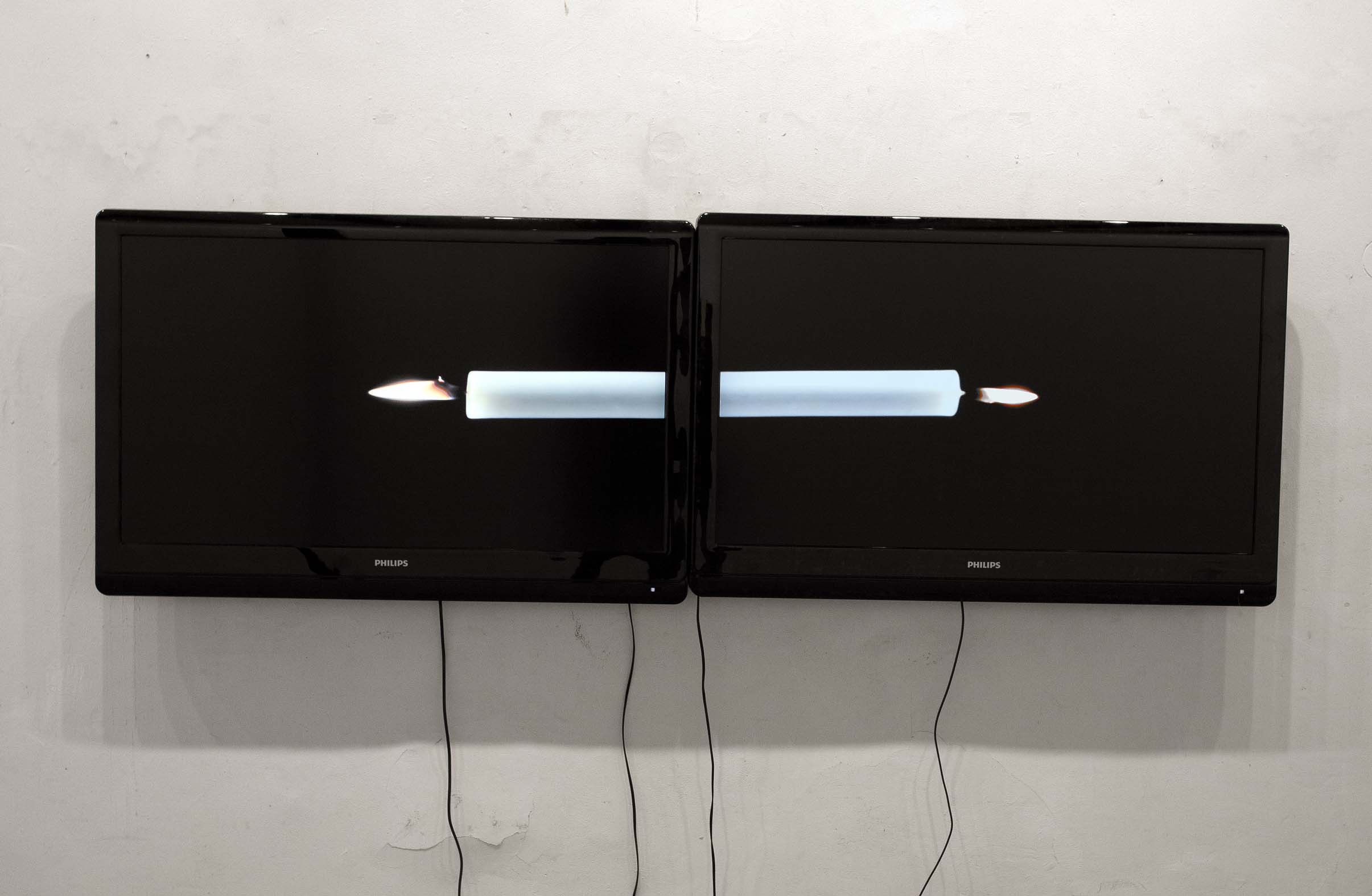Luchezar Boyadjiev
Installation
-
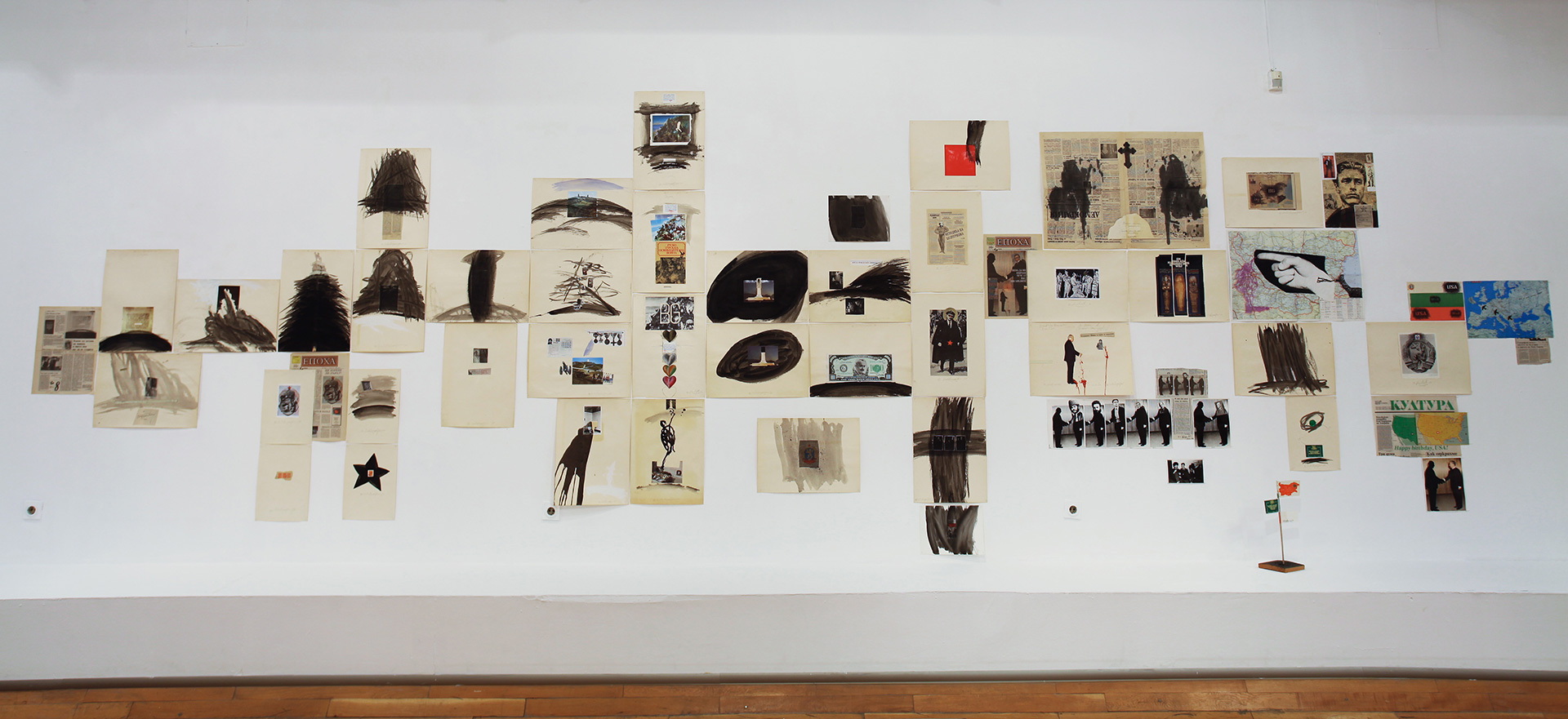 Visual Repressions on the Sign Environment (cycle), 1990-1991
installation
Visual Repressions on the Sign Environment (cycle), 1990-1991
installation
drawings, collages,
text, objects, press clippings
dimensions variable Installation view: “Art for Change 1985-2015”, Sofia City Art Gallery, Sofia. February - March 2015 The installation is the first publically exhibited work by the artist after he decided, in October 1990, to “come out of the closet”, acknowledge his artistic identity, and dedicate 100 % of his time to realizing his ideas first; and questioning if this is art or not – second. The Cycle of Visual Repressions on the Sign Environment is rooted in the time of the months after the fall of the Berlin Wall and the initial chaos of the collapsing social life and public order. It is a witness to the first concerns of the so-called changes in an ex-Soviet Bloc country after 1989 and the collapse of totalitarian regimes in Eastern Europe. The cycle consists of over 50 individual pieces – “trials” attempting to “erase”, “deface” and otherwise subject to artistic “repression” with brush, ink and scissors some powerful visual images and signs from the heated up visual culture of the time – some that symbolized the recent communist past, others – the pre-communist past. While testing the resistance to change of new and old images from the sign environment, the artist was de facto enacting a prophetic gesture – throughout the decades since 1989, the process of renaming and reshaping history is still going on at full speed. For instance, the cycles of destruction/erection of monuments and reshaping the historical narrative, is but one such line of societal life to this day. In the cycle one can see the first “signs” that the process of transformation will not be fast or easy – in some of these drawings the artist “tested” the most famous monuments in Sofia – the monument to the Soviet Army, and to the Tsar Liberator - Alexander II, a monument that has featured prominently in his later works too. Or the monument at Shipka Pass on top of the Balkan Mountains where the most important battle for the construction of the modern day Bulgarian identity was fought in 1877 – it is given a second monument so that this place of memory becomes an even more fortified point of identity. Or the post stamp from the 1930s with the profile of the ex-king of Bulgaria Boris III that had already been defaced in the late 1940s by the new totalitarian regime by rubber-stamping on each small piece of paper an appeal to collect rags… – in this cycle the stamp is outlined with a black five-pointed star. The conceptual motivation of the cycle in text, as well as a number of the pieces were published in the printed media of the time thus establishing the genre of “demontage” as a visual procedure, in the words of the artist himself. Work can be viewed in details here -
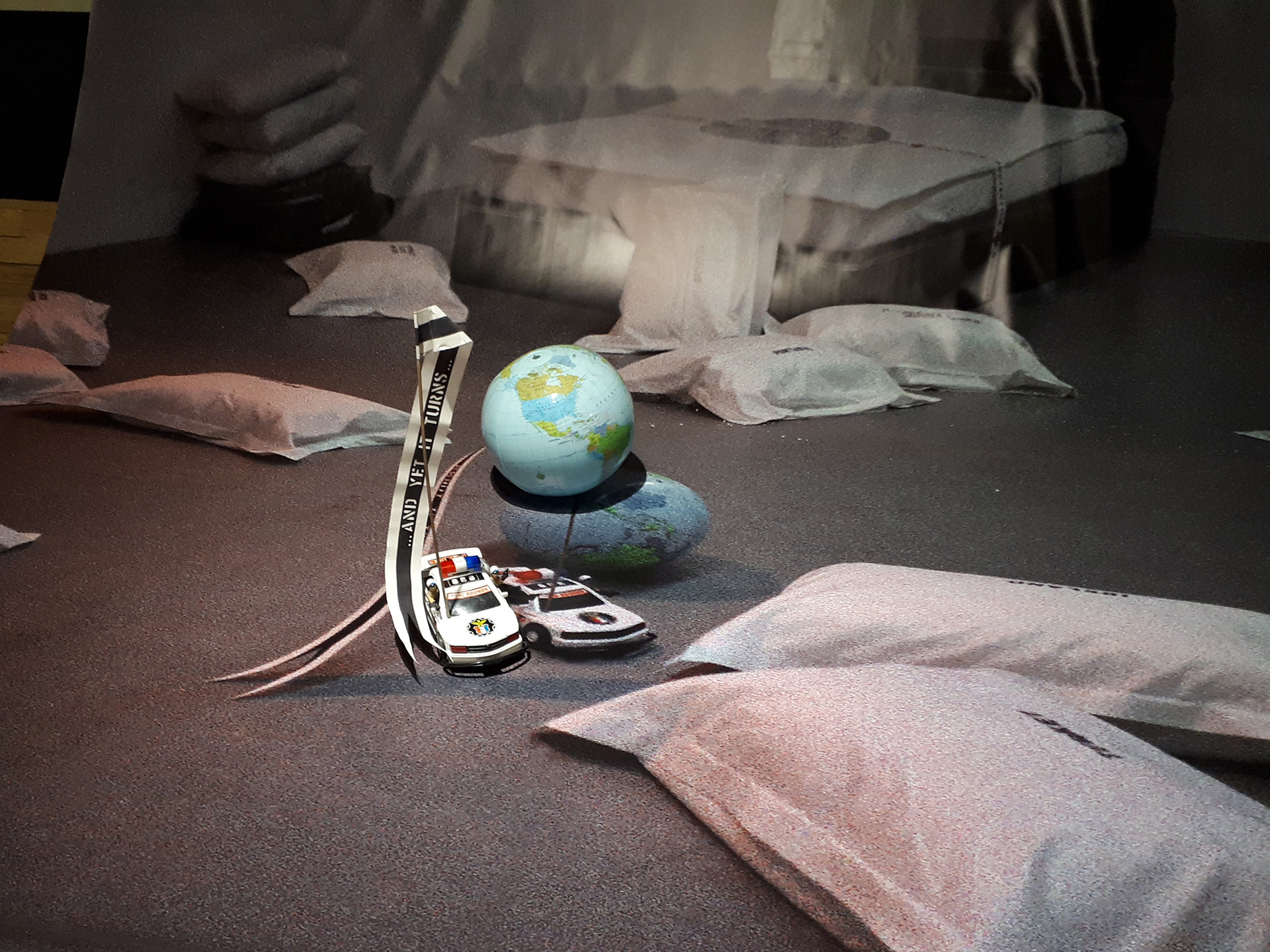 The Fountain of Europe. Double take, 1994 (2018)
Installation
The Fountain of Europe. Double take, 1994 (2018)
Installation
Author’s reconstruction in a new version
digital
print on vinyl - installation view from
“Beyond the Borders” – the 1st Gwangju Biennial in South Korea,
1995 graphite powder, pencil,
tempera, foil, coins, etc.,
drawings on paper hung on the wall,
child’s toy-police car, an inflatable globe, etc.
dimensions variable Installation view: “Luchezar Boyadjiev. Sic Transit Media Mundi (The present is too short and rather tight); Sofia City Art Gallery, Sofia. February – March 2018 The author’s replica of a work from the early 1990s revisits the strict duality of the same and the different. The ever-increasing continent of Europe was producing at the time yet newer and newer countries from the split and disintegration of the ex-USSR, ex-Yugoslavia, and ex-Czechoslovakia. Without any effort or doing of its own, Bulgaria, the home country of the author, transformed from a small-sized to a medium-sized European country. The installation – invoking a family bedroom after a pillow fight and referring to the foundation myths of Europe – the Choice of Paris, the Trojan horse in front of Troy, etc. asks the viewer to identify differences in the same and similarities in the different. The emblem-like drawing with the Fountain of Europe spitting names of countries up in the air, is from the invitation card to the 1995 Sofia-showing of the work. The installation was conceived for and first shown at “Luchezar Boyadjiev. The Fountain of Europe: Double take”, Center for Curatorial Studies - Museum, Bard College, Annandale-on-Hudson, NY, USA, Oct.- Nov. 1994. Work can be viewed in details here -
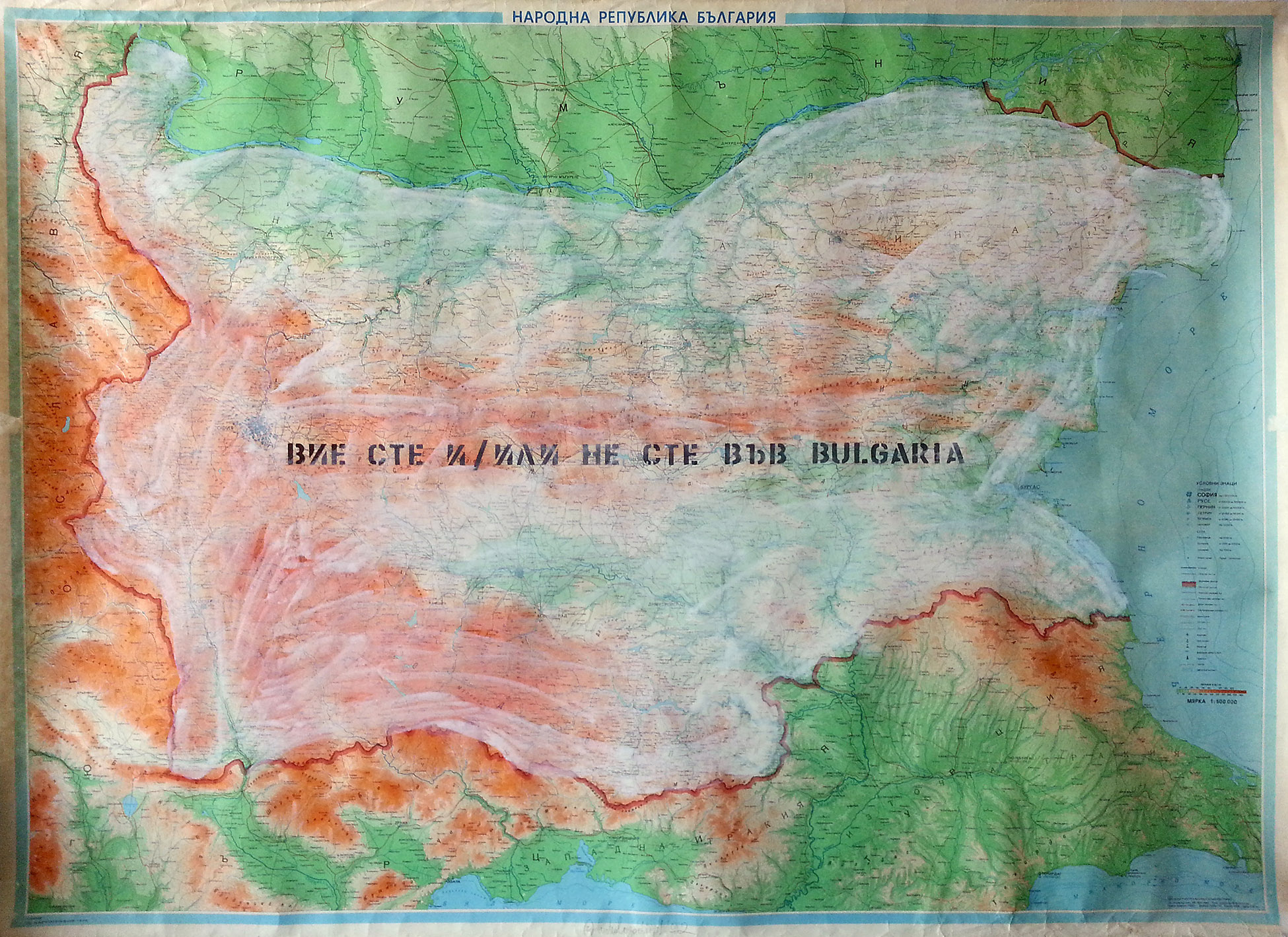 TOEFL, 1981- 1986/1991-1992
installation
TOEFL, 1981- 1986/1991-1992
installation
drawings, objects,
texts, photographs,
collages, etc. made at various times from the life of the artist ranging from 1981-1983 and 1986 (while living in New York), to 1991-1992 and the beginning of his career in Sofia
dimensions variable Installation view: “Medical Check-up”, Club of the (eternally) Young Artist; 6 Shipka St. Gallery, Sofia. February 1992 The early 1990s saw the influx of a lot of new and fancy things in the life and public space of ex-Socialist Bulgaria. Top among these were English language and visual pornography. The new notion of “freedom” was taken literally and extremely liberally to mean “anything goes”. You were now “IN” and/or “OUT” of Bulgaria at the same time; you were “IN” and/or “OUT” of Bulgarian language, visual culture, and collapsing notions of public code of conduct, etc. You were also “IN” and/or “OUT” of the whole world. Or so it seemed at the time.
The “TOEFL” installation plays with the notion of a simulated “test” for the visual and language literacy of new audiences as to the use of these “new-comers”. The title refers to TOEFL – Test of English as a Foreign Language, which each individual hoping to study or work in the USA must take convincingly enough.
In view of my own life/work background with regard to the English language and visual culture of the USA – which were the top source for imitation in Bulgaria at the time after the fall of the Berlin Wall, I incorporated bits and pieces in this installation that I had made as far back as 1981-83 and 1986 (such as for instance, the 2 horrible self-portraits from my first months in New York City back in the spring of 1981). The installation refers to the adoption of visual matrix from adult magazines and their specific gender constructs, and also to language constructs that are hard to translate from Bulgarian into English and vice versa especially some famous modern art dictums that have high currency ratings in the West but were of little use in the ex-Soviet bloc. Work can be viewed in details here -
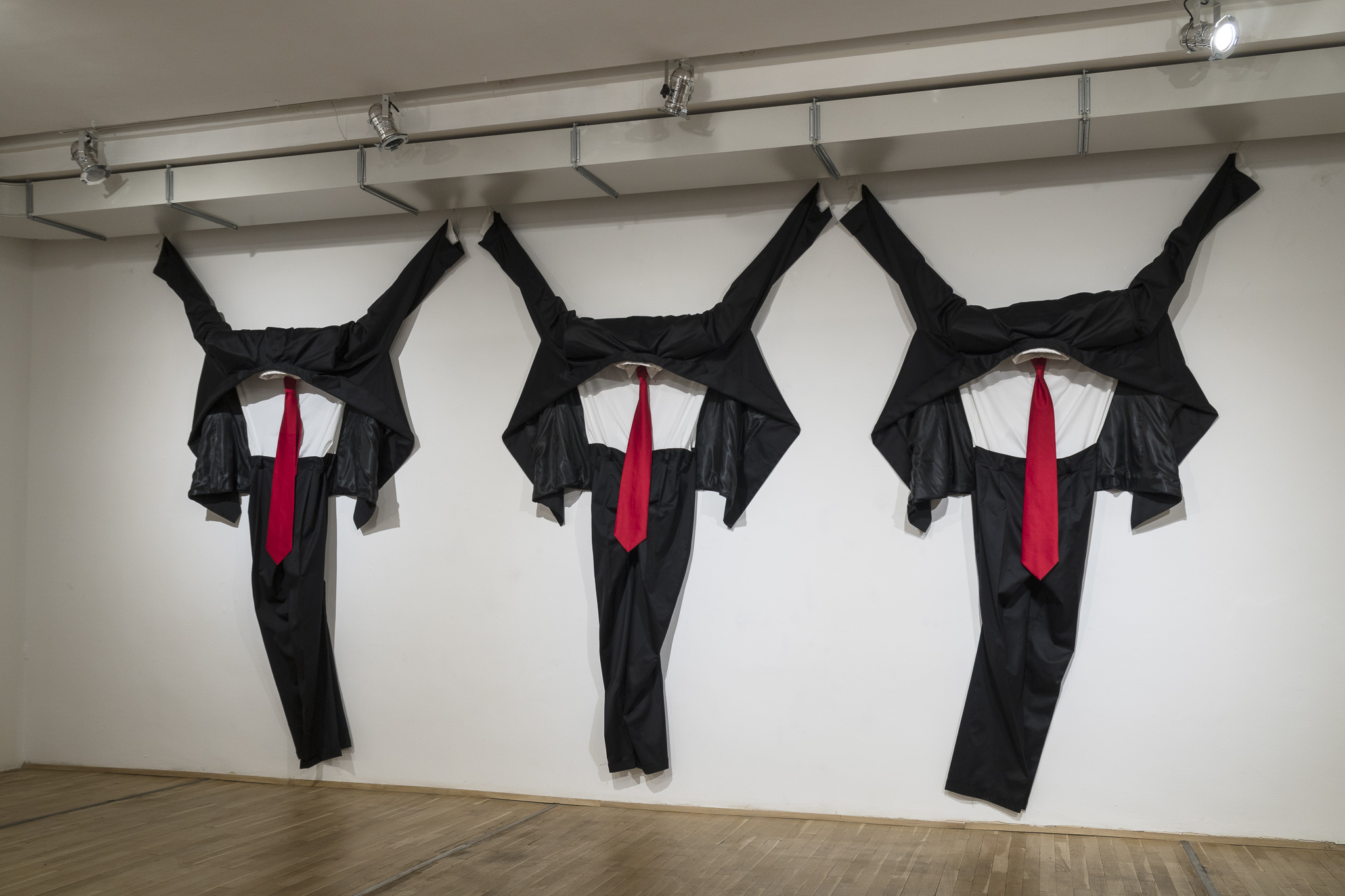 Post(neo)-Golgotha, 2018
author’s replica after a work from 1994 in 2/3 size of the first version
Post(neo)-Golgotha, 2018
author’s replica after a work from 1994 in 2/3 size of the first version
installation
fabric, soft sculpture
app. 350 x 600 x 40 cm The work engages with the replacement of one dogma with another in the post-1989 world – the dogma of blind faith in communism with that of blind faith in business, free market economy and so on. Nowadays it is seen as a critique on neo-liberalism while the new color of the neck ties and the position of the costumes-without-bodies is often linked to the situation in the US, the supposed leader of the free world. -
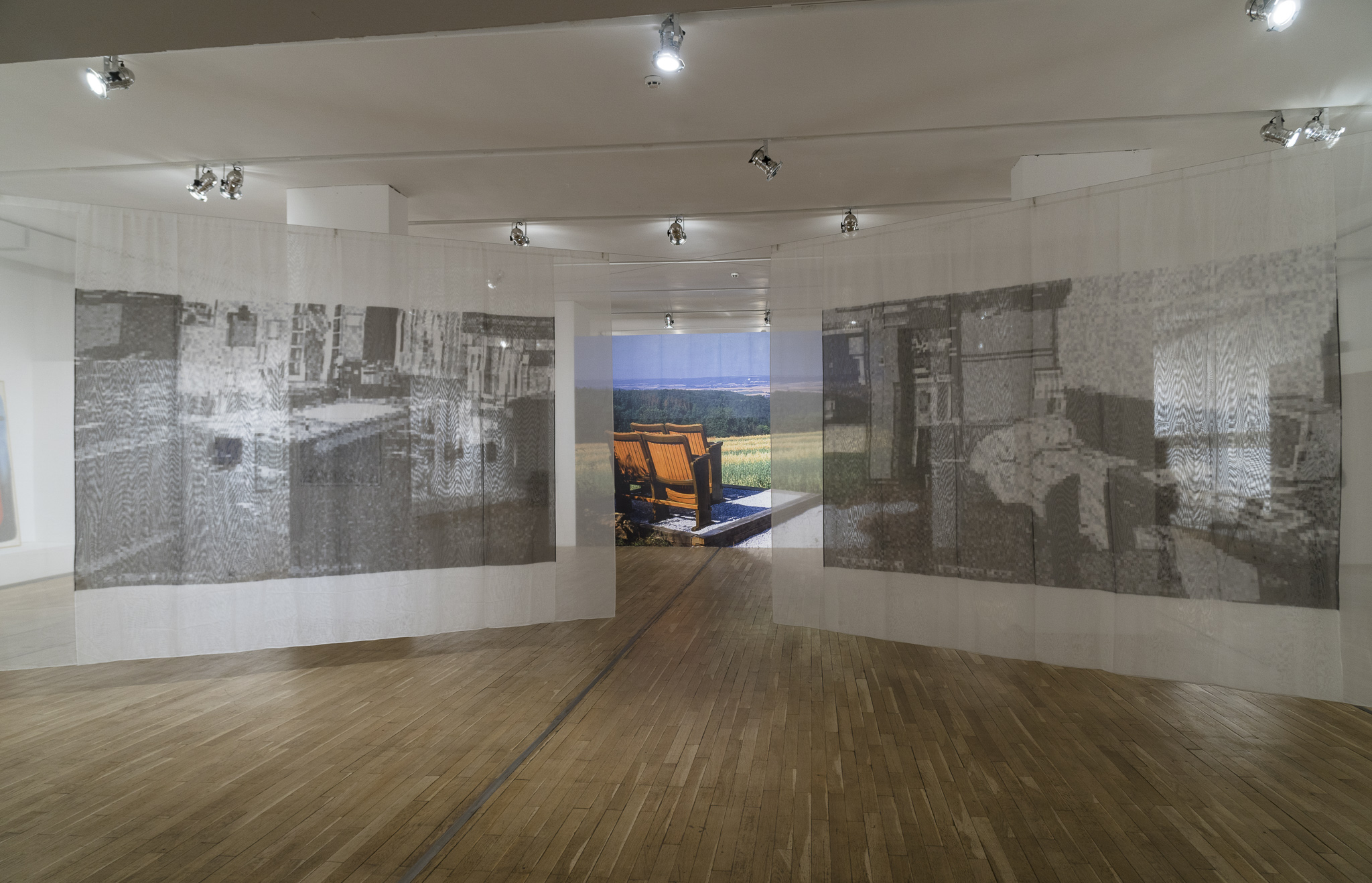 Movables. My Room, 1998
installation
Movables. My Room, 1998
installation
2 digital prints on semi-transparent fabric
280 x 415 cm each The two prints-curtains function as “walls” defining my room in Sofia as a hallucinatory, nostalgic, visual corner – a movable “property” that can be taken anywhere in the world “packed in a nut shell”. The source images were drawn by hand, from nature in the traditional way – looking at the interior, but using a mouse, the screen of a PC monitor, and the MS Paint program to draw. They were developed and finished during my residency with the FWM (Fabric Workshop and Museum) in Philadelphia and printed in Salt Lake City at the end of 1997.
Object
-
Intimate Endspiel (a domestic version of “Endspiel. The Good, the Bad and the Lonely”, 2012) 2018-2025
Hand-made object; wood, marker and pencil on sheets of 2 mm plywood, glued on repurposed chessboards
105 x 36 x 3 cm
1/3+1AP -
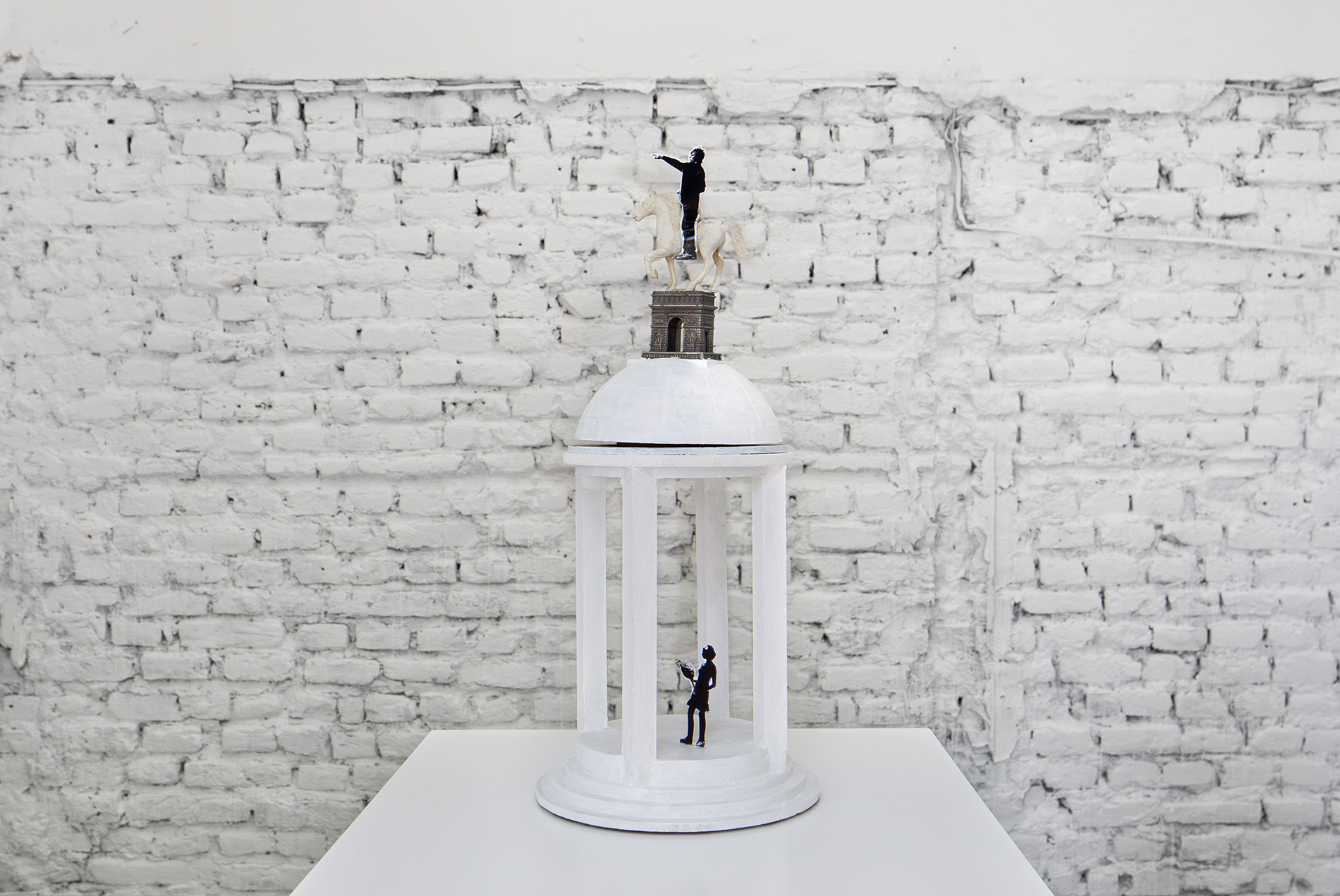 Project for an Equestrian Monument to Christo. Scale Model, 2022
Wood, plastic, metal, paper, acrylic paint on half globe, turning roller 50 x 21 x 21 cm
Project for an Equestrian Monument to Christo. Scale Model, 2022
Wood, plastic, metal, paper, acrylic paint on half globe, turning roller 50 x 21 x 21 cm
-
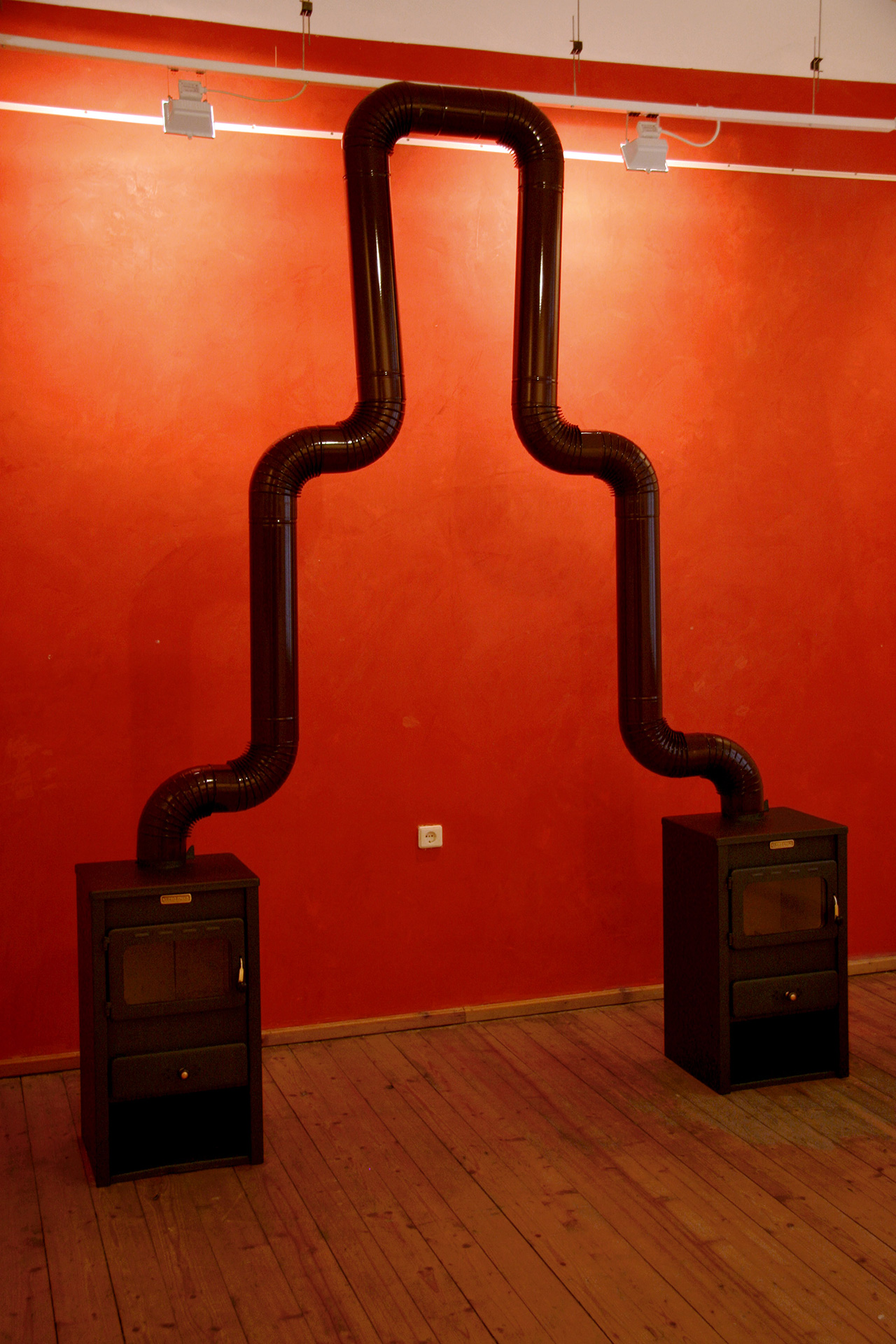 Perfect Lovers (new), 2011
installation
Perfect Lovers (new), 2011
installation
2 heating stoves, pipes
320 x 220 x 70 cm Installation view: “Luchezar Boyadjiev. Local Warming”, 2011. Friends Gallery, Rouse, Bulgaria. 2011
Photograph: the artist -
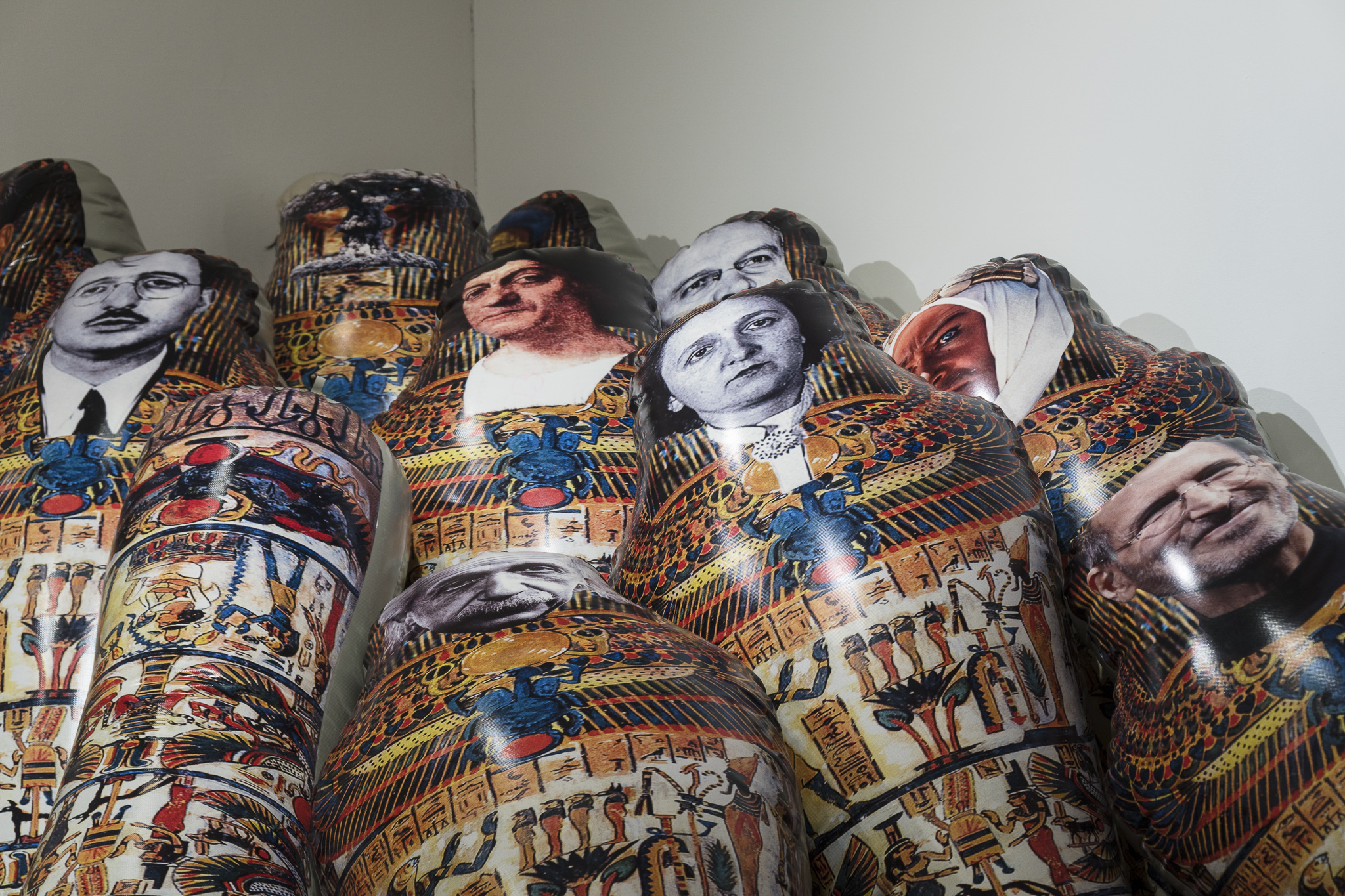 Untitled Mummy Project (Hold your breath!), 2012
installation
Untitled Mummy Project (Hold your breath!), 2012
installation
12 inflatable vinyl objects like mummies
faces of famous people
each one app.
200 x 70 x 60 cm
edition 3+2AP The work is an ironical stand on the media reality of post truth and fake news. It treats as “disposable celebrities” persons that are heroes from the past or present – “heroes” whom one may inflate and/or deflate at will (much like a sex doll but with political identity), may hide in the closet or display in public in various formations. The faces on the mummies are: Gagarin, Einstein, Columbus, Lawrence of Arabia, Molotov, Stalin, Mao, the Manhattan Project (the Nuclear Mushroom), Ethel and Julius Rosenberg, Steve Jobs and Dobby – the House Elf from the Harry Potter series whose face is used as a substitute for the face of Putin at street demonstrations in Russia, Ukraine, etc. -
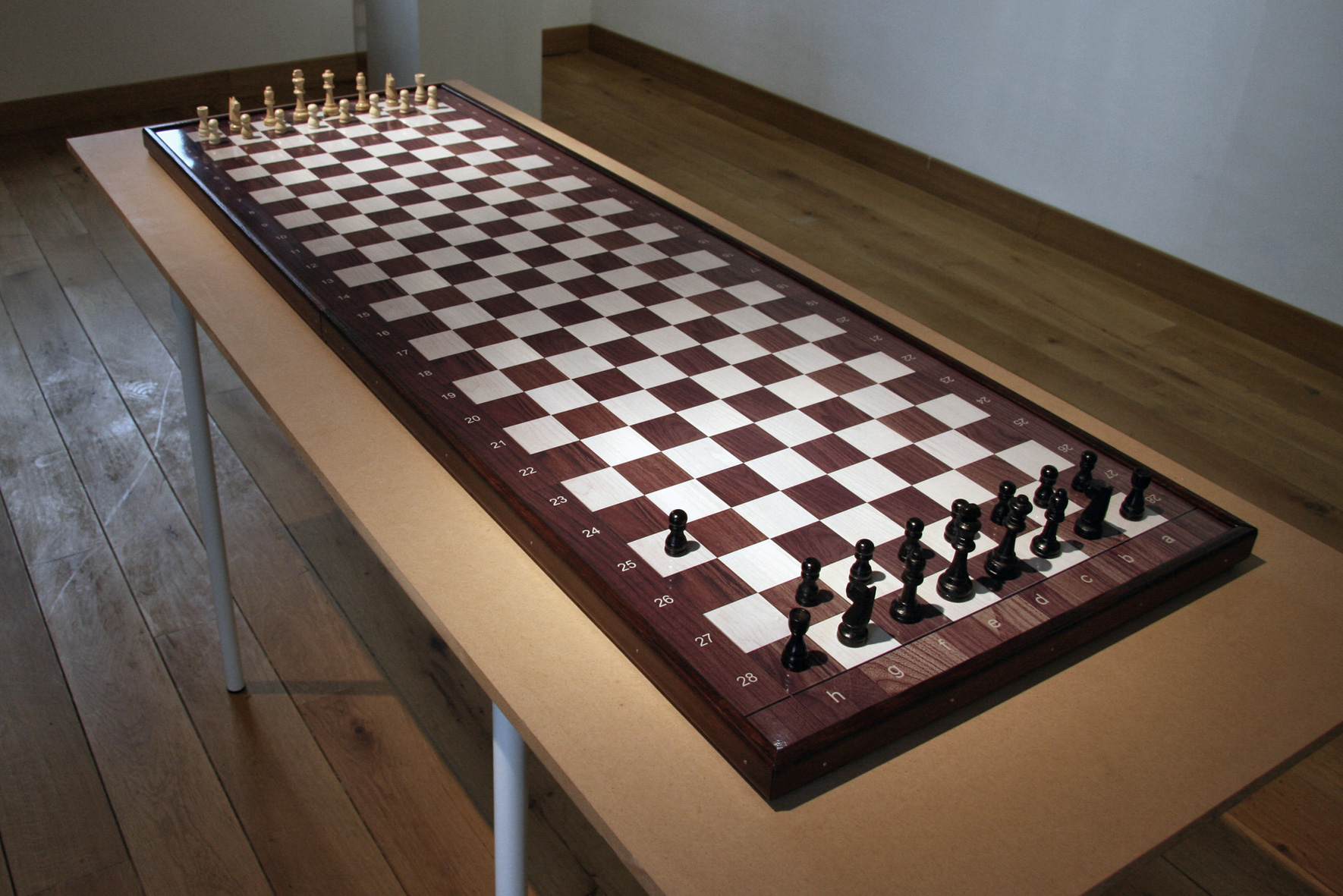 Endspiel; or the Good, the Bad and the Lonely, 2012
installation-object
Endspiel; or the Good, the Bad and the Lonely, 2012
installation-object
wood, metal, laminated print
table 82 х 180 х 70 cm
chess board:
150 х 50.5 х 3.5 cm
edition 3+2AP Taking a clue from the work and interests of the late Marcel Duchamp who wrote a book on the end phase of the game of chess, the work proposes a time-unlimited game option which also says – “there is no end to art; there will always be somebody who wants to play and enjoy, and see, and participate”. -
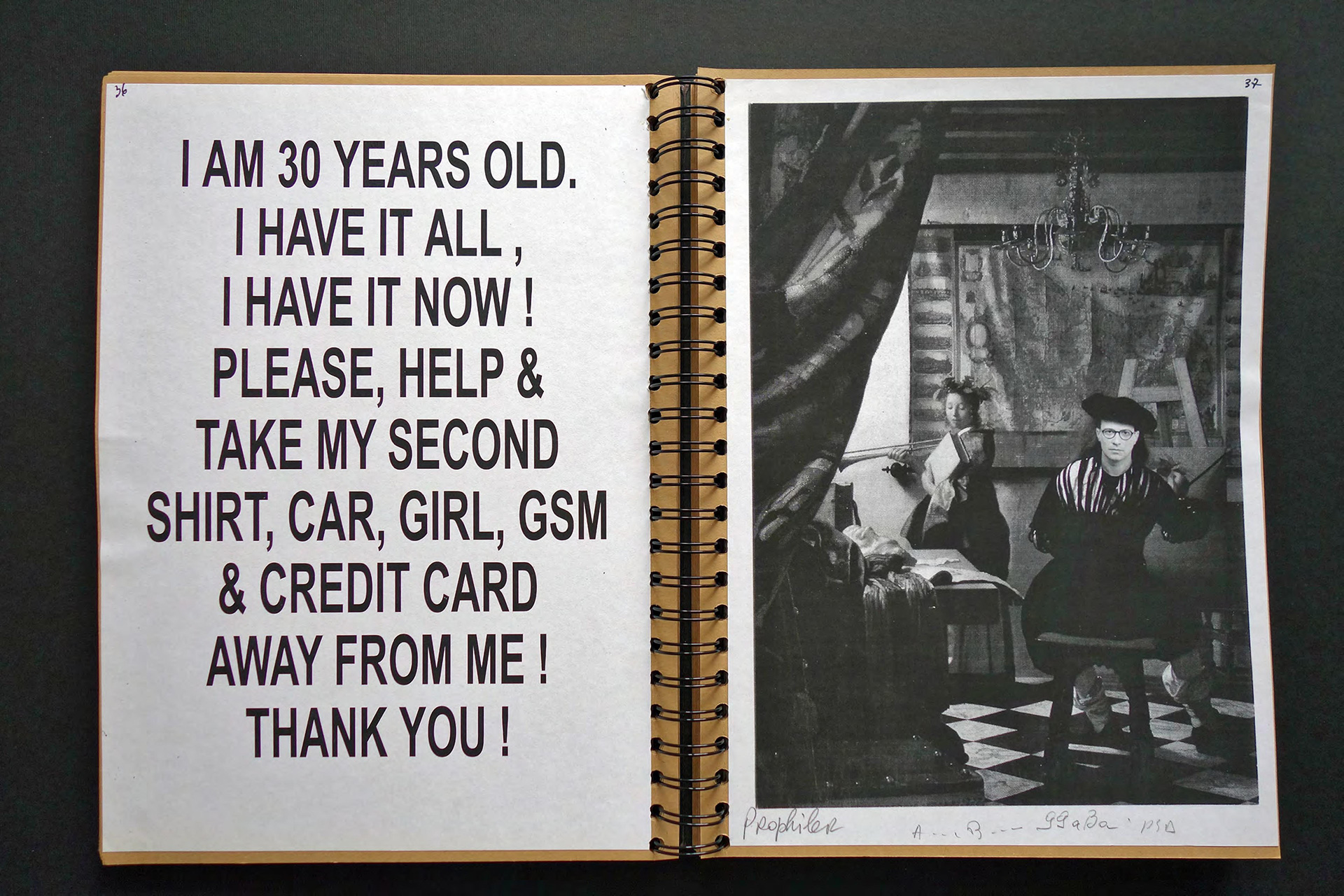 Scrap Book 1, 2002
unique artist’s book
Scrap Book 1, 2002
unique artist’s book
82 double pages with collaged drawings, photographs and text
30.5 х 24.5 х 3 cm
(30.5 х 46 cm spread) Work can be viewed in details here -
 Eternal Sunshine, 2018
installation
Eternal Sunshine, 2018
installation
“Prity Mini” type stove
39 x 47 x 62 cm,
Turkish made stove-pipes
allover dimensions app. 320 x 39 x 75 cm
Mixed Media
-
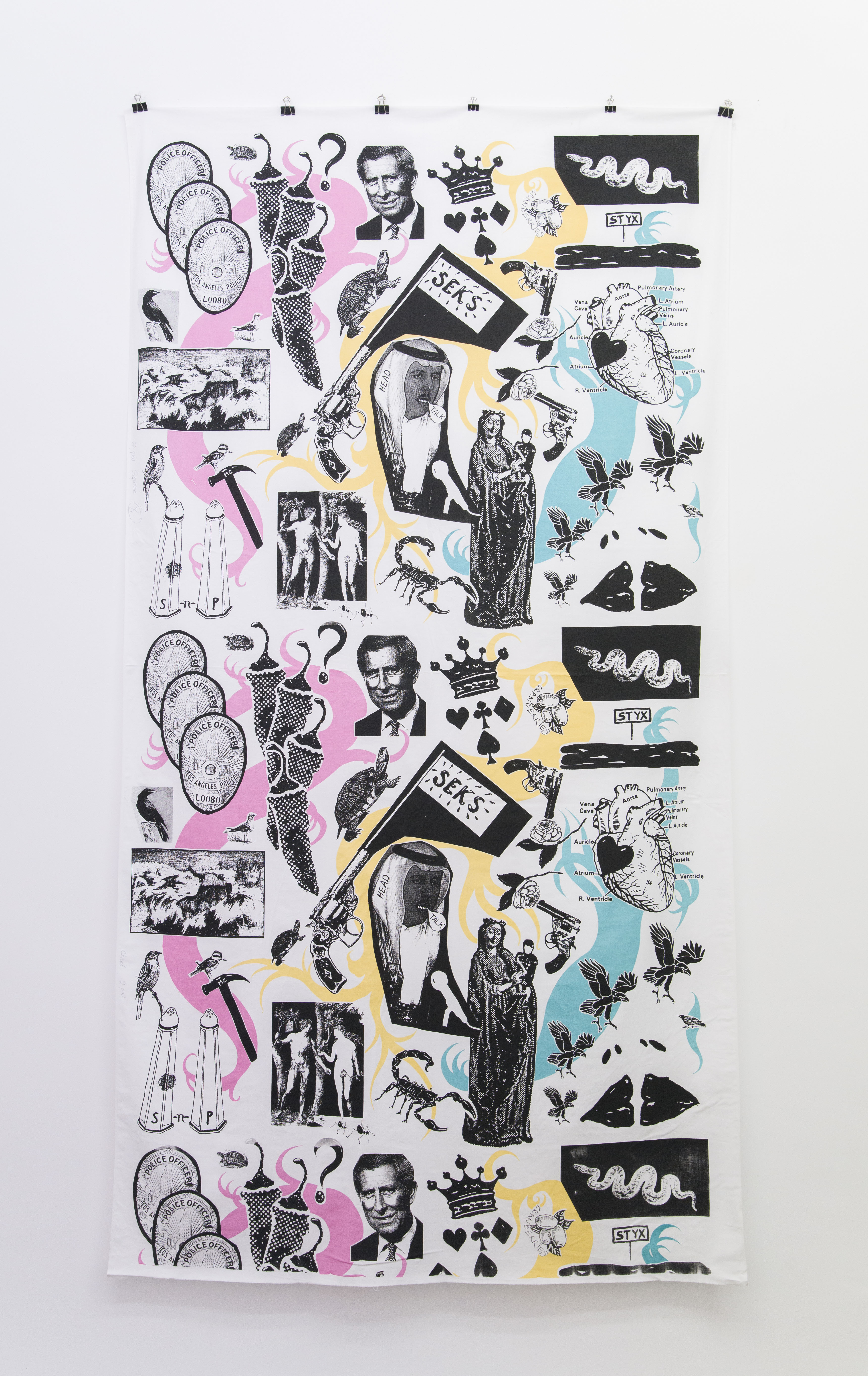 Music to the Eyes (Favorite Rock Acts), 1997
4 colors
Music to the Eyes (Favorite Rock Acts), 1997
4 colors
silk-screen, print on fabric
263.5 x 139 cm -
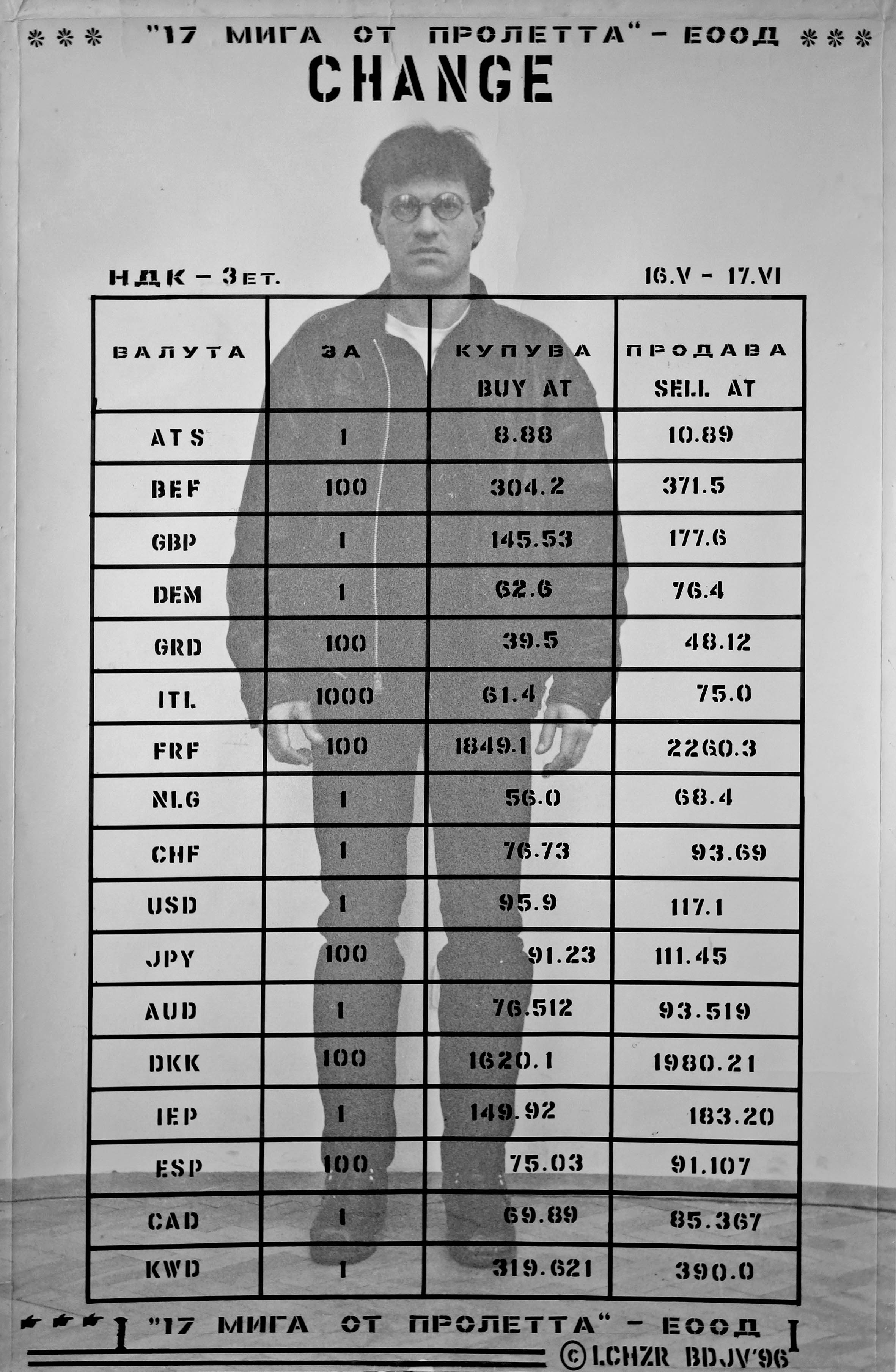 Change (Self-portrait with 17 currency exchange rates), 1996
photograph
Change (Self-portrait with 17 currency exchange rates), 1996
photograph
felt-tip marker on photo paper
framed
160 x 108 cm
edition 5+2AP Initially part of “17 Instants from Spring, LTD” – a project for a fictional currency exchange bureau and insurance company, 1996 -
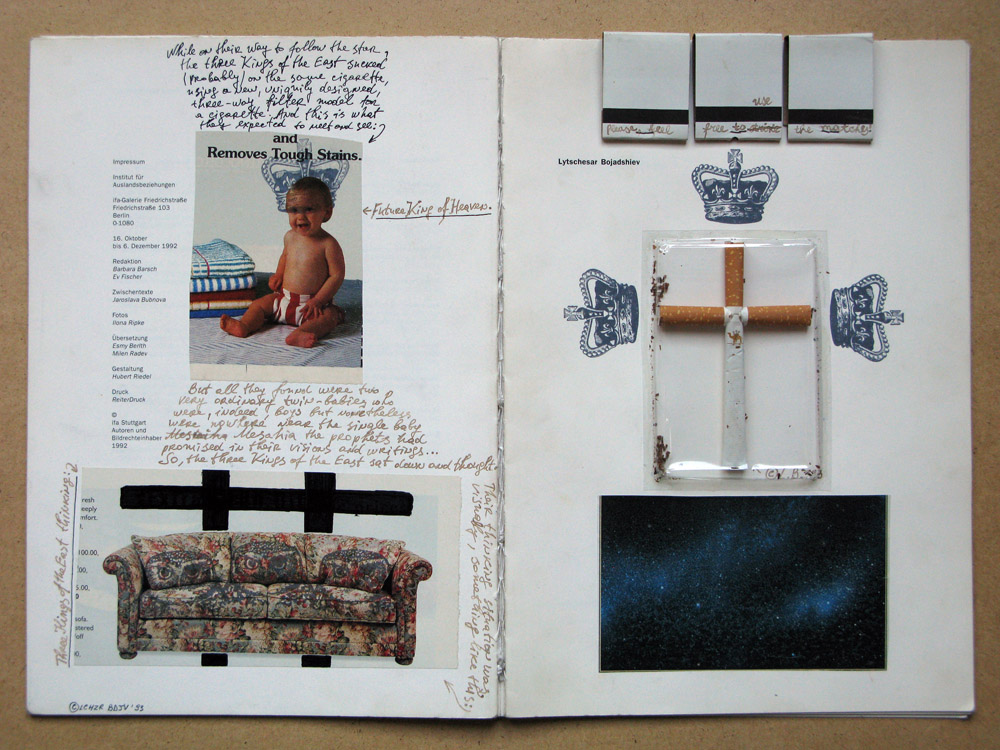 Modified Catalogue, 1993
Part of a cycle of 55 hand-manipulated catalogues from a solo show
Modified Catalogue, 1993
Part of a cycle of 55 hand-manipulated catalogues from a solo show
30 x 42 cm In the fall of 1992, the organizers of the first solo show of the artist outside of Bulgaria, the IFA-Berlin Galerie published a dual edition of the exhibition catalogue. By mistake, there appeared an extra 200 or so copies of the catalogue – with full content but without covers. The artist took some of these and “customized” them by giving each one a unique cover thus turning the faulty catalogue edition into a cycle of artist’s books. Work can be viewed in details here -
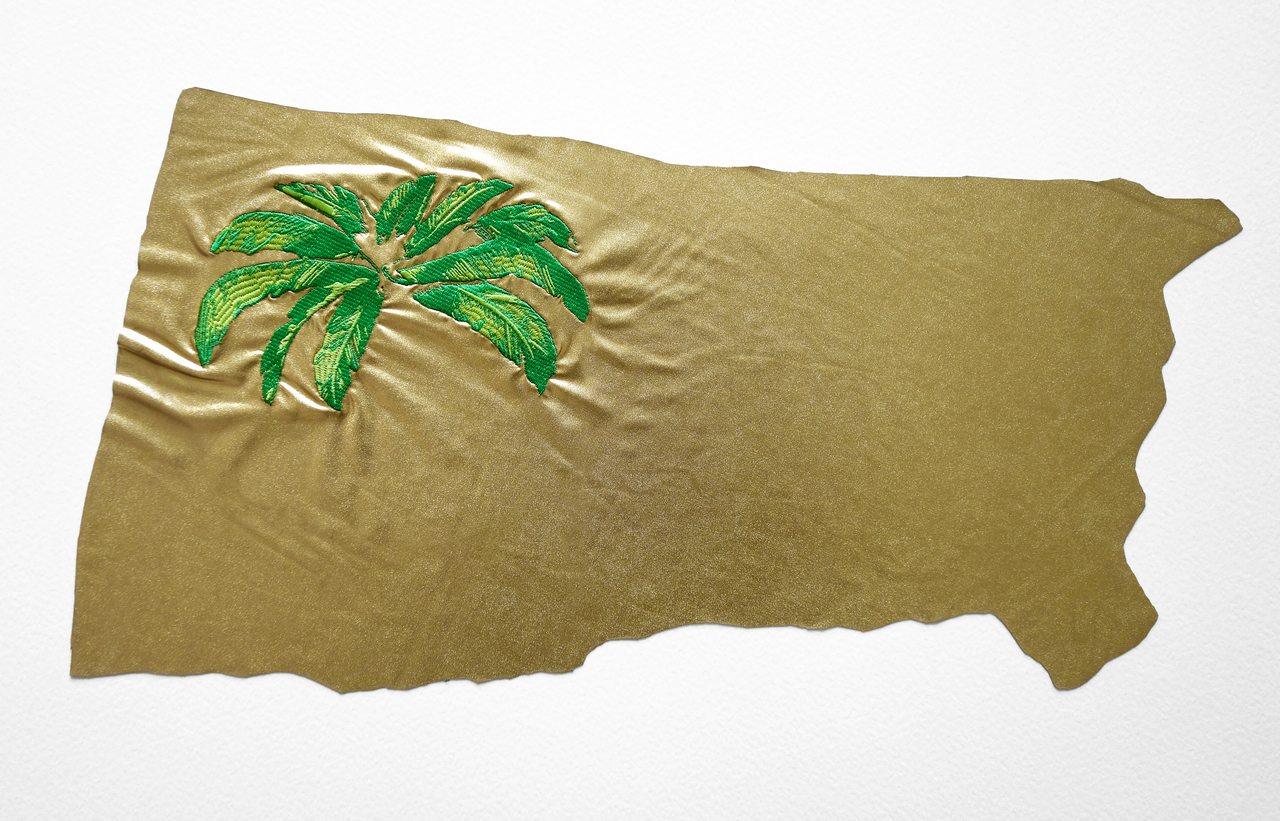 New-found flag for a missing country, 2018
object
New-found flag for a missing country, 2018
object
fabric, embroidery
31 x 58 cm
еdition 5+2AP
Drawing
-
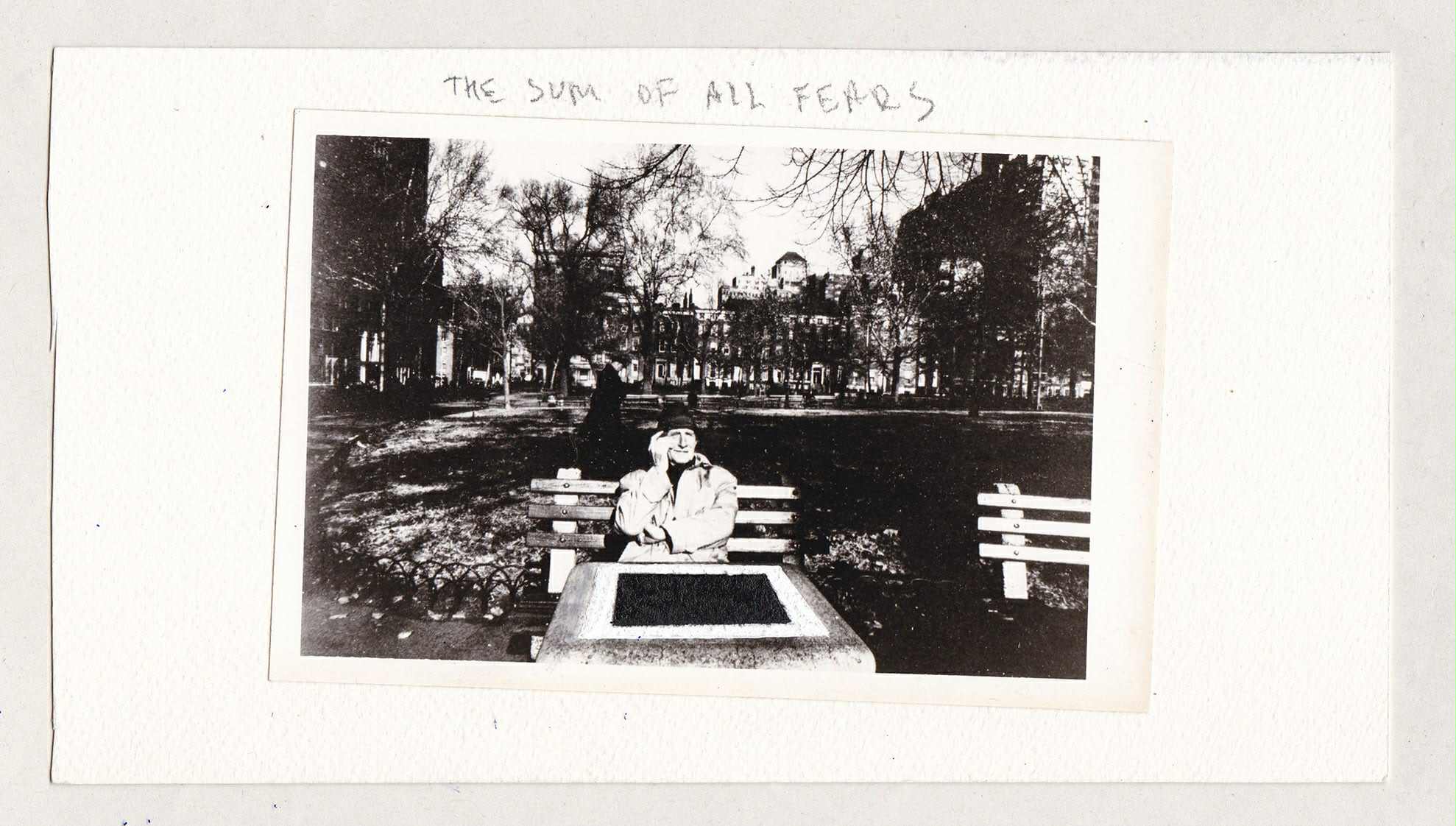 The Sum of All Fears, 2012
drawing on photography, pasted on watercolor paper
The Sum of All Fears, 2012
drawing on photography, pasted on watercolor paper
part of a cycle of 7 works
12,5 x 23 cm -
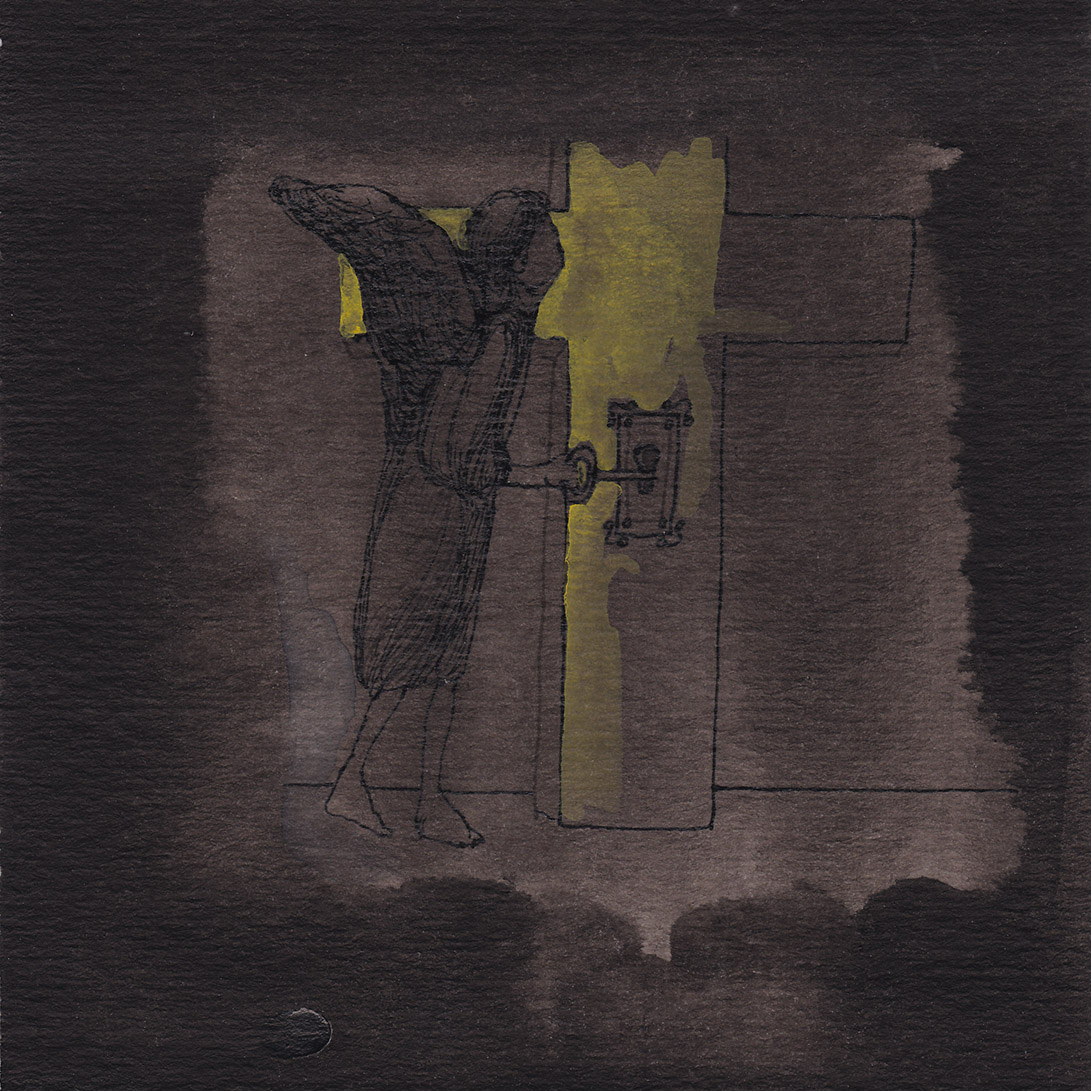 Drawing #120 from the cycle of 150 drawings “Crucifixion for the Fisherman”, 1991-1992
watercolor, brush, pencil on paper
Drawing #120 from the cycle of 150 drawings “Crucifixion for the Fisherman”, 1991-1992
watercolor, brush, pencil on paper
14 x 14 cm
numbered, signed and dated on the back More information on the series of drawings here -
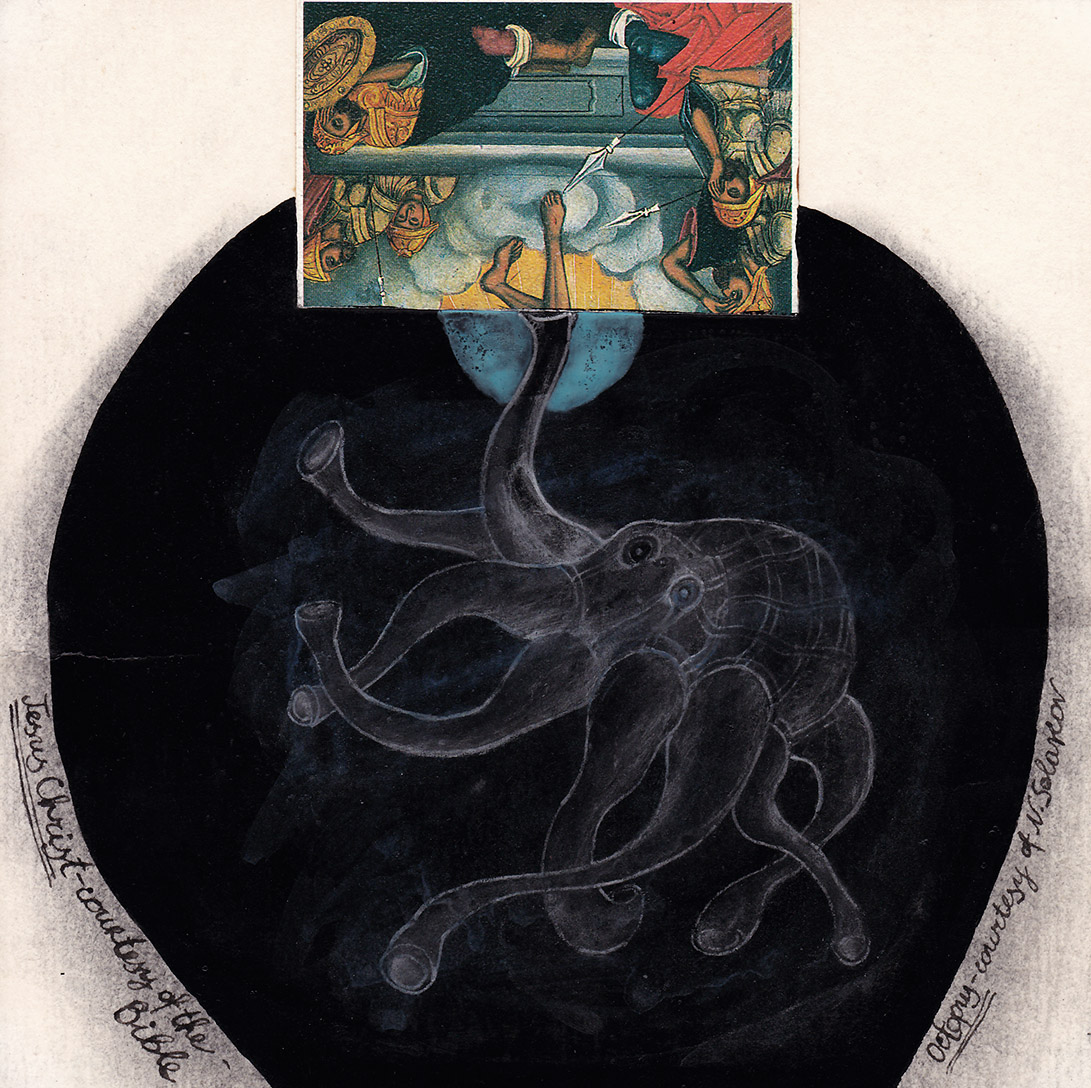 Drawing #142 from the cycle of 150 drawings “Crucifixion for the Fisherman”, 1991-1992
watercolor, brush, pencil on paper
Drawing #142 from the cycle of 150 drawings “Crucifixion for the Fisherman”, 1991-1992
watercolor, brush, pencil on paper
14 x 14 cm
numbered, signed and dated on the back More information on the series of drawings here -
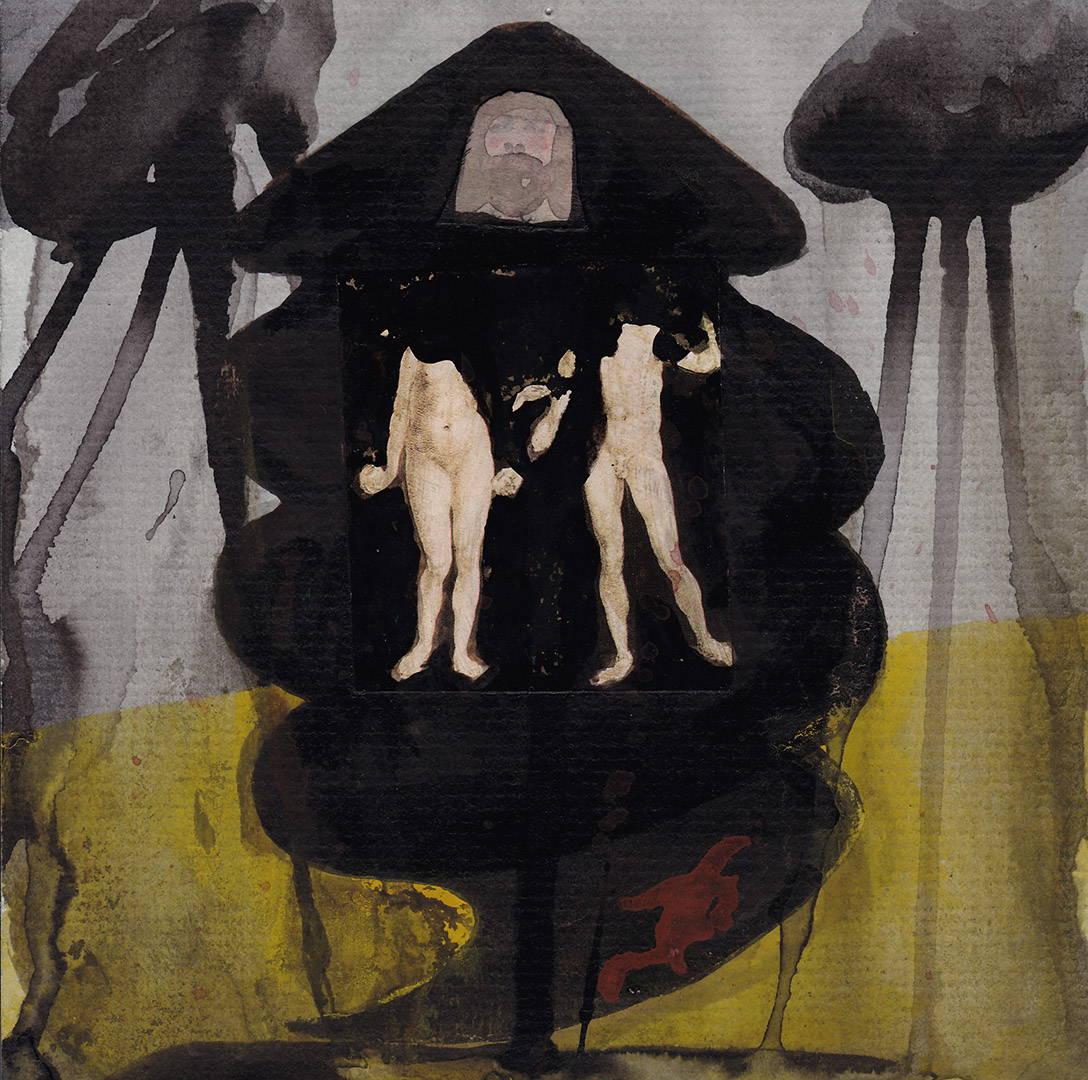 Drawing #77 from the cycle of 150 drawings “Crucifixion for the Fisherman”, 1991-1992
watercolor, brush, pencil on paper
Drawing #77 from the cycle of 150 drawings “Crucifixion for the Fisherman”, 1991-1992
watercolor, brush, pencil on paper
14 x 14 cm
numbered, signed and dated on the back More information on the series of drawings here -
 Drawing #62 from the cycle of 150 drawings “Crucifixion for the Fisherman”, 1991-1992
watercolor, brush, pencil on paper
Drawing #62 from the cycle of 150 drawings “Crucifixion for the Fisherman”, 1991-1992
watercolor, brush, pencil on paper
14 x 14 cm
numbered, signed and dated on the back More information on the series of drawings here -
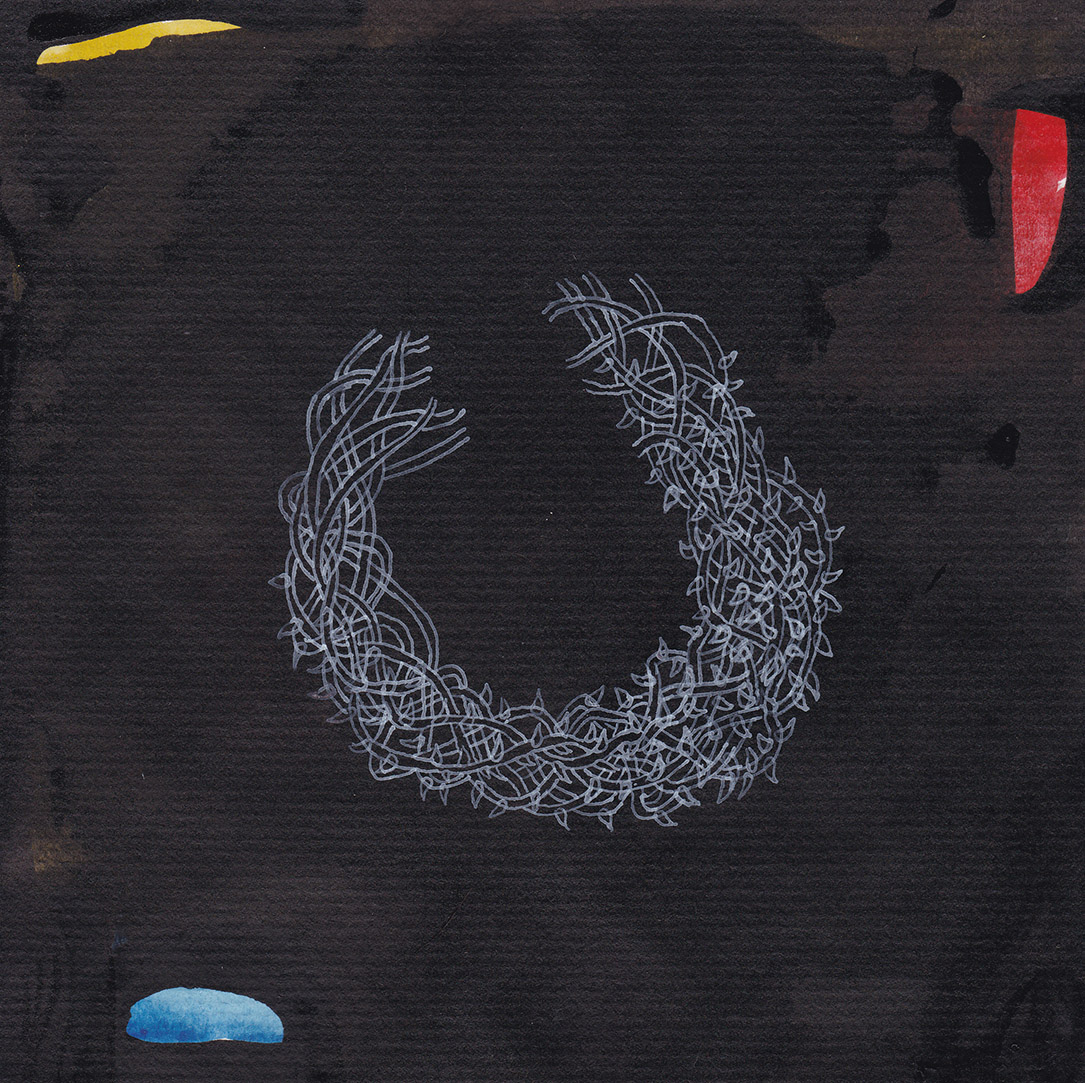 Drawing #107 from the cycle of 150 drawings “Crucifixion for the Fisherman”, 1991-1992
watercolor, brush, pencil on paper
Drawing #107 from the cycle of 150 drawings “Crucifixion for the Fisherman”, 1991-1992
watercolor, brush, pencil on paper
14 x 14 cm
numbered, signed and dated on the back More information on the series of drawings here -
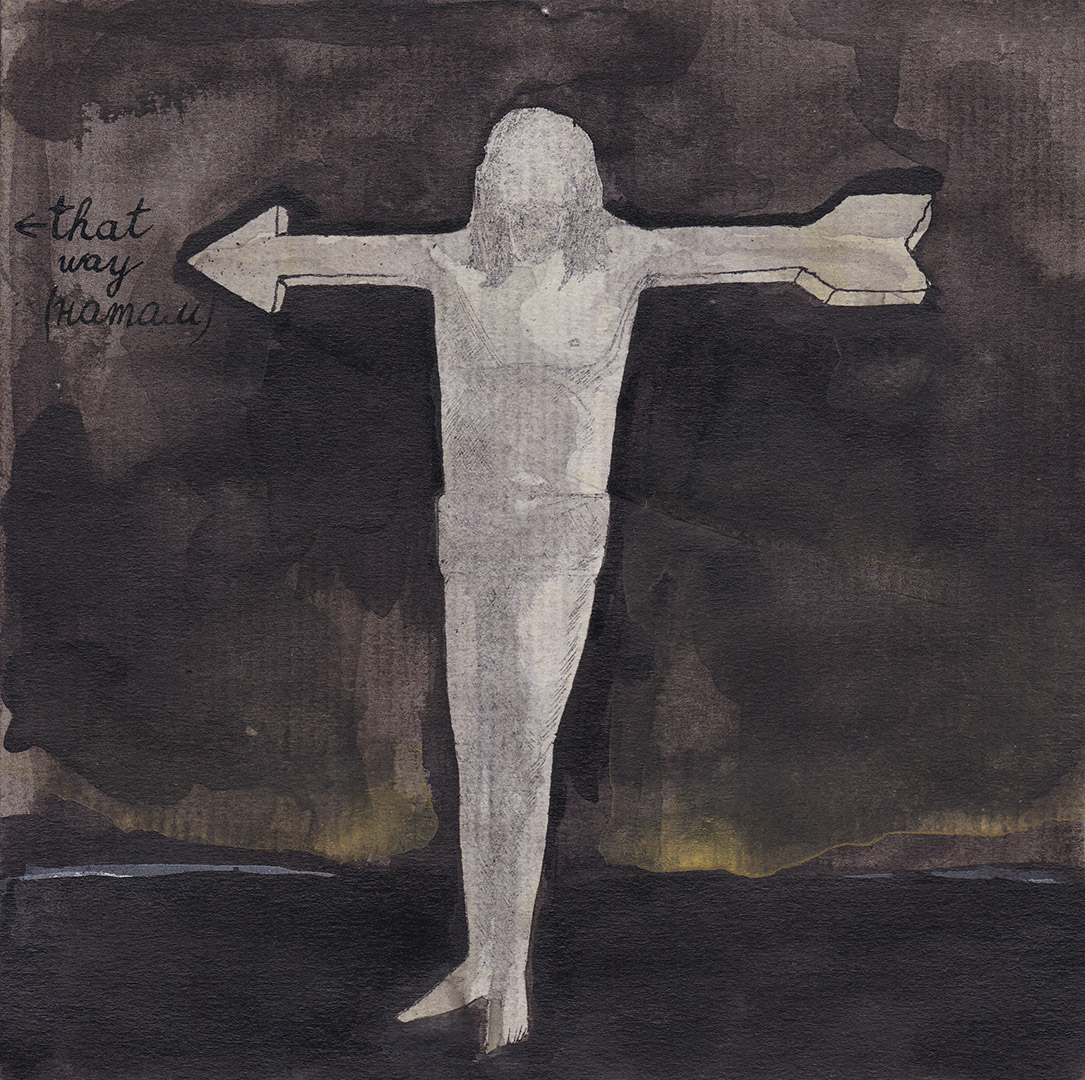 Drawing #21 from the cycle of 150 drawings “Crucifixion for the Fisherman”, 1991-1992
watercolor, brush, pencil on paper
Drawing #21 from the cycle of 150 drawings “Crucifixion for the Fisherman”, 1991-1992
watercolor, brush, pencil on paper
14 x 14 cm
numbered, signed and dated on the back More information on the series of drawings here -
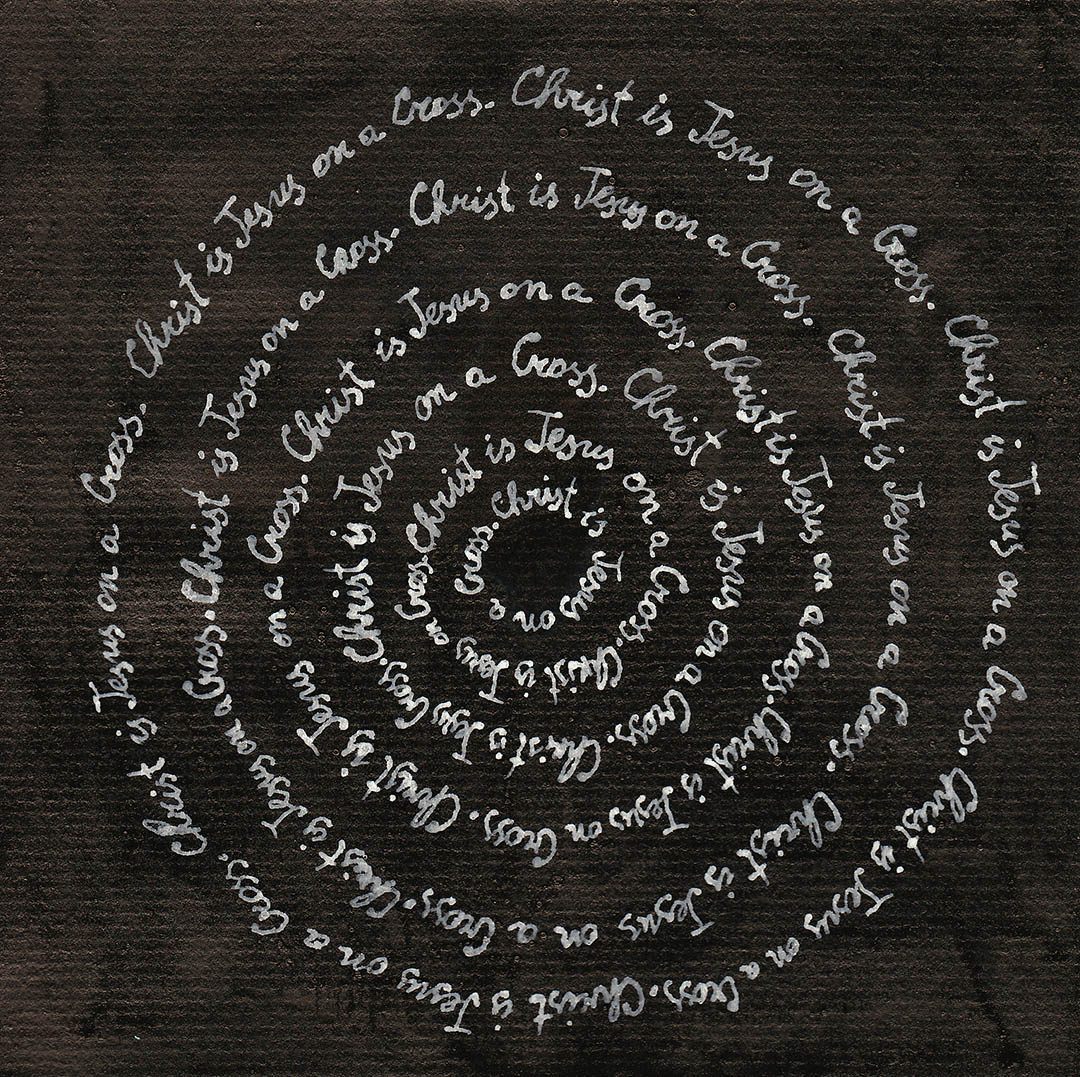 Drawing #112 from the cycle of 150 drawings “Crucifixion for the Fisherman”, 1991-1992
watercolor, brush, pencil on paper
Drawing #112 from the cycle of 150 drawings “Crucifixion for the Fisherman”, 1991-1992
watercolor, brush, pencil on paper
14 x 14 cm
numbered, signed and dated on the back More information on the series of drawings here -
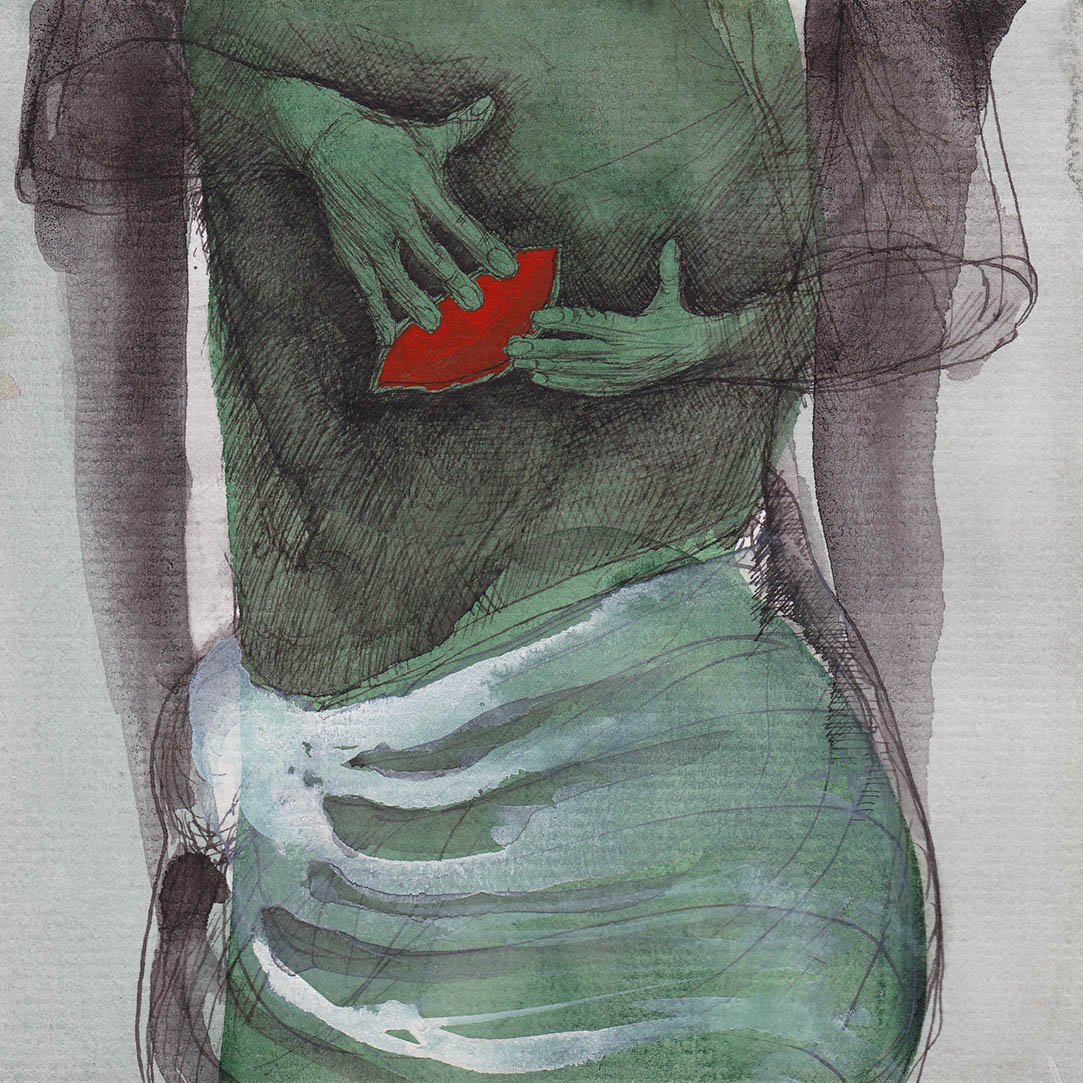 Drawing #127 from the cycle of 150 drawings “Crucifixion for the Fisherman”, 1991-1992
watercolor, brush, pencil on paper
Drawing #127 from the cycle of 150 drawings “Crucifixion for the Fisherman”, 1991-1992
watercolor, brush, pencil on paper
14 x 14 cm
numbered, signed and dated on the back More information on the series of drawings here -
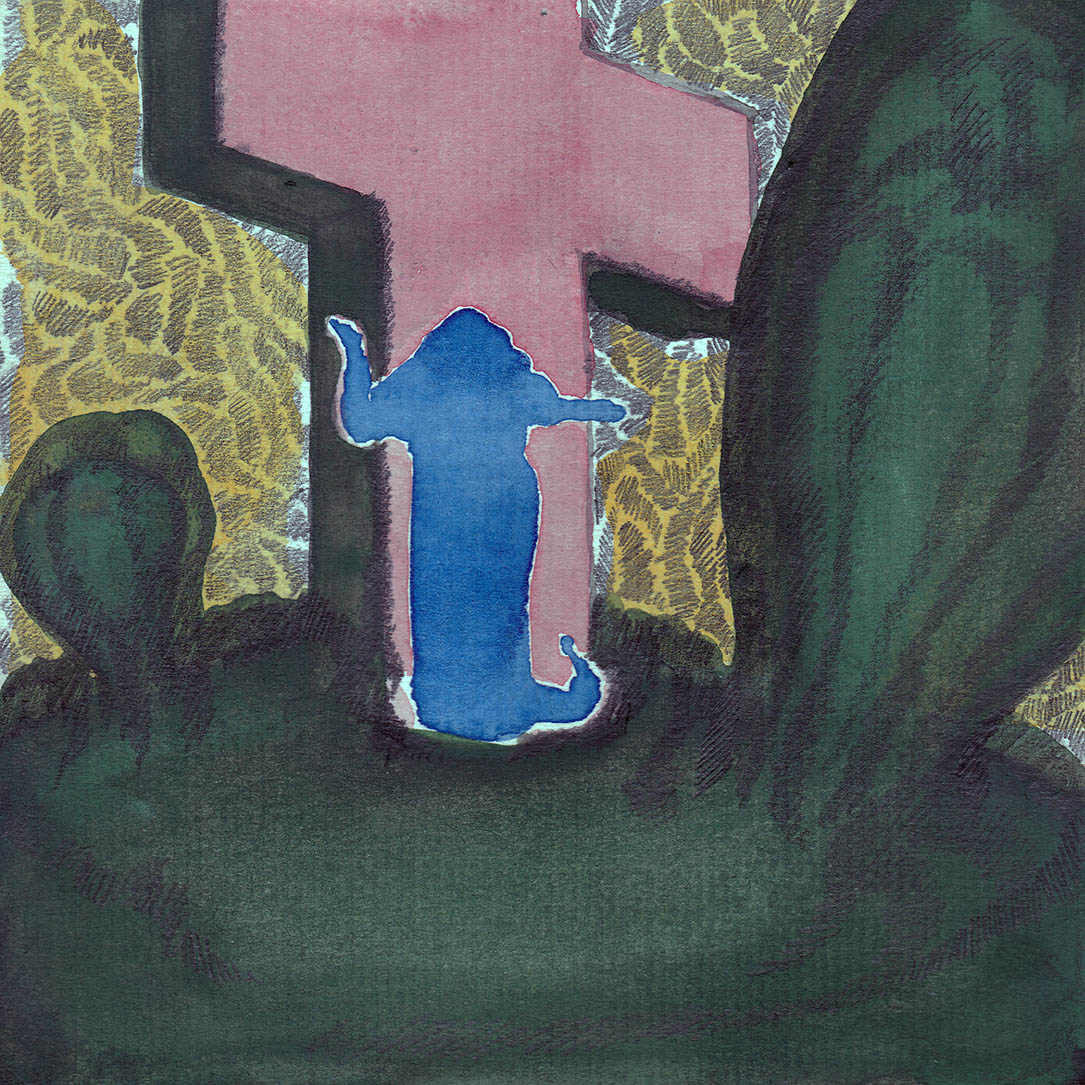 Drawing #89 from the cycle of 150 drawings “Crucifixion for the Fisherman”, 1991-1992
watercolor, brush, pencil on paper
Drawing #89 from the cycle of 150 drawings “Crucifixion for the Fisherman”, 1991-1992
watercolor, brush, pencil on paper
14 x 14 cm
numbered, signed and dated on the back More information on the series of drawings here -
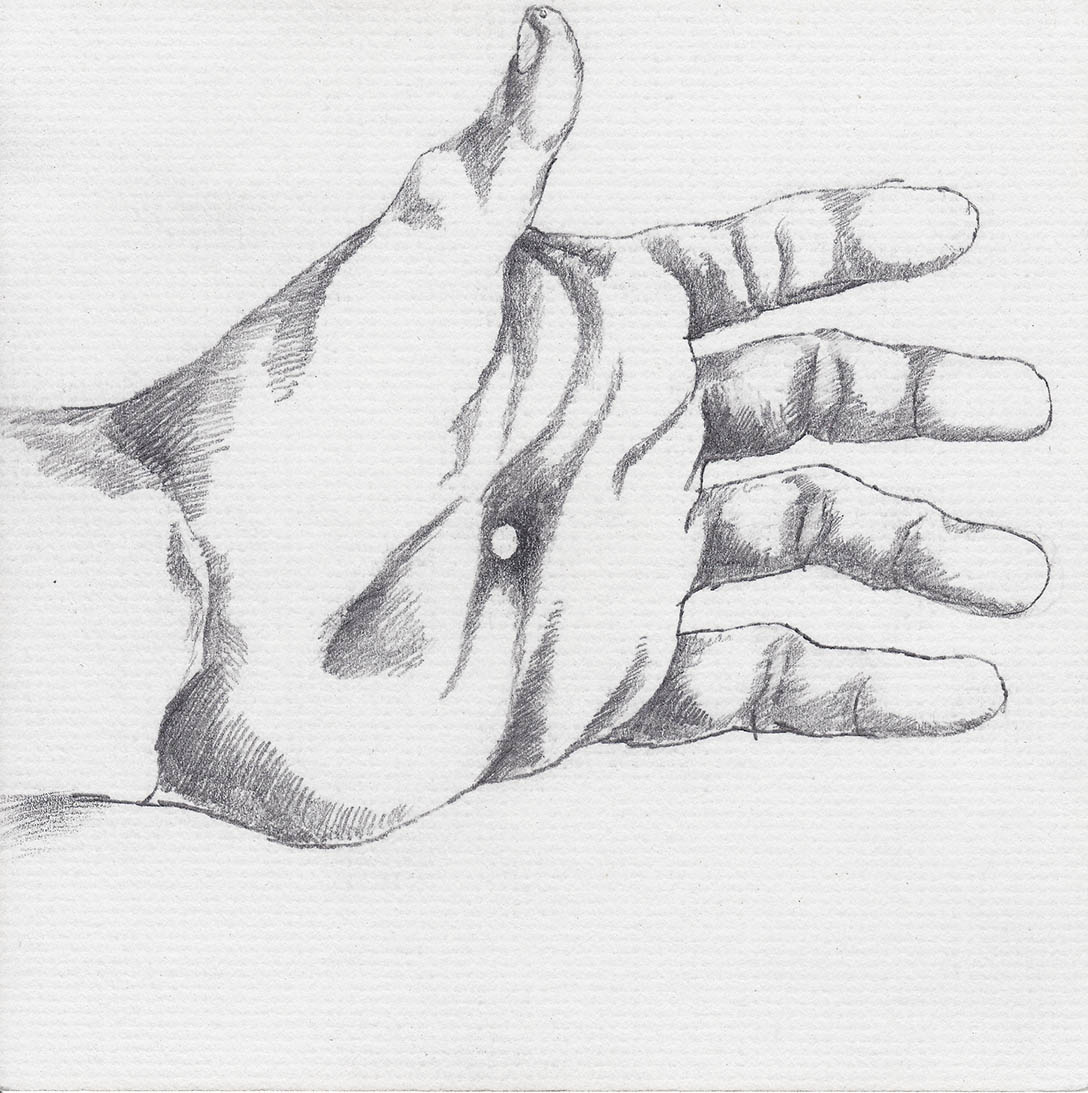 Drawing #20 from the cycle of 150 drawings “Crucifixion for the Fisherman”, 1991-1992
watercolor, brush, pencil on paper
Drawing #20 from the cycle of 150 drawings “Crucifixion for the Fisherman”, 1991-1992
watercolor, brush, pencil on paper
14 x 14 cm
numbered, signed and dated on the back More information on the series of drawings here -
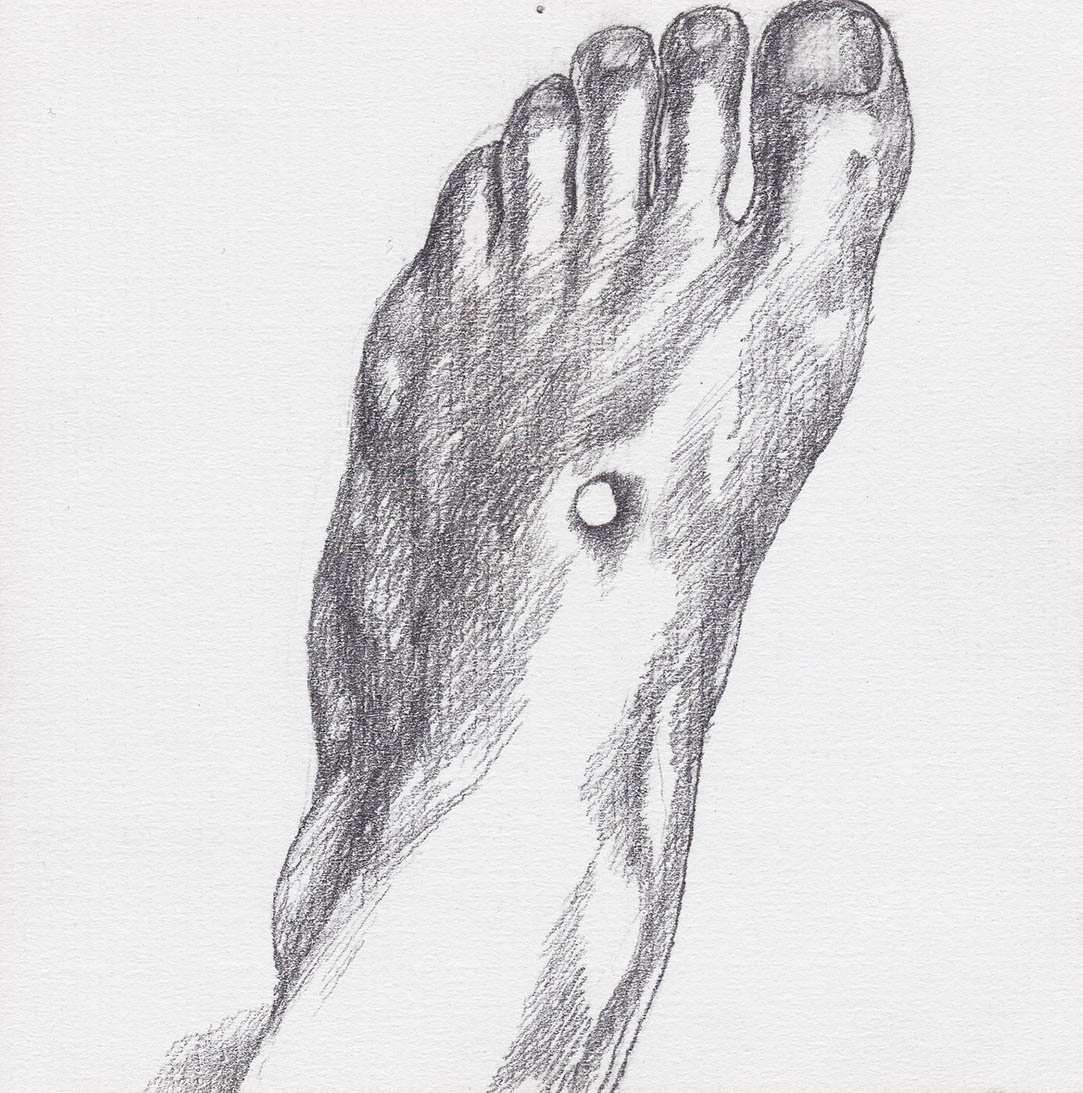 Drawing #97 from the cycle of 150 drawings “Crucifixion for the Fisherman”, 1991-1992
watercolor, brush, pencil on paper
Drawing #97 from the cycle of 150 drawings “Crucifixion for the Fisherman”, 1991-1992
watercolor, brush, pencil on paper
14 x 14 cm
numbered, signed and dated on the back More information on the series of drawings here -
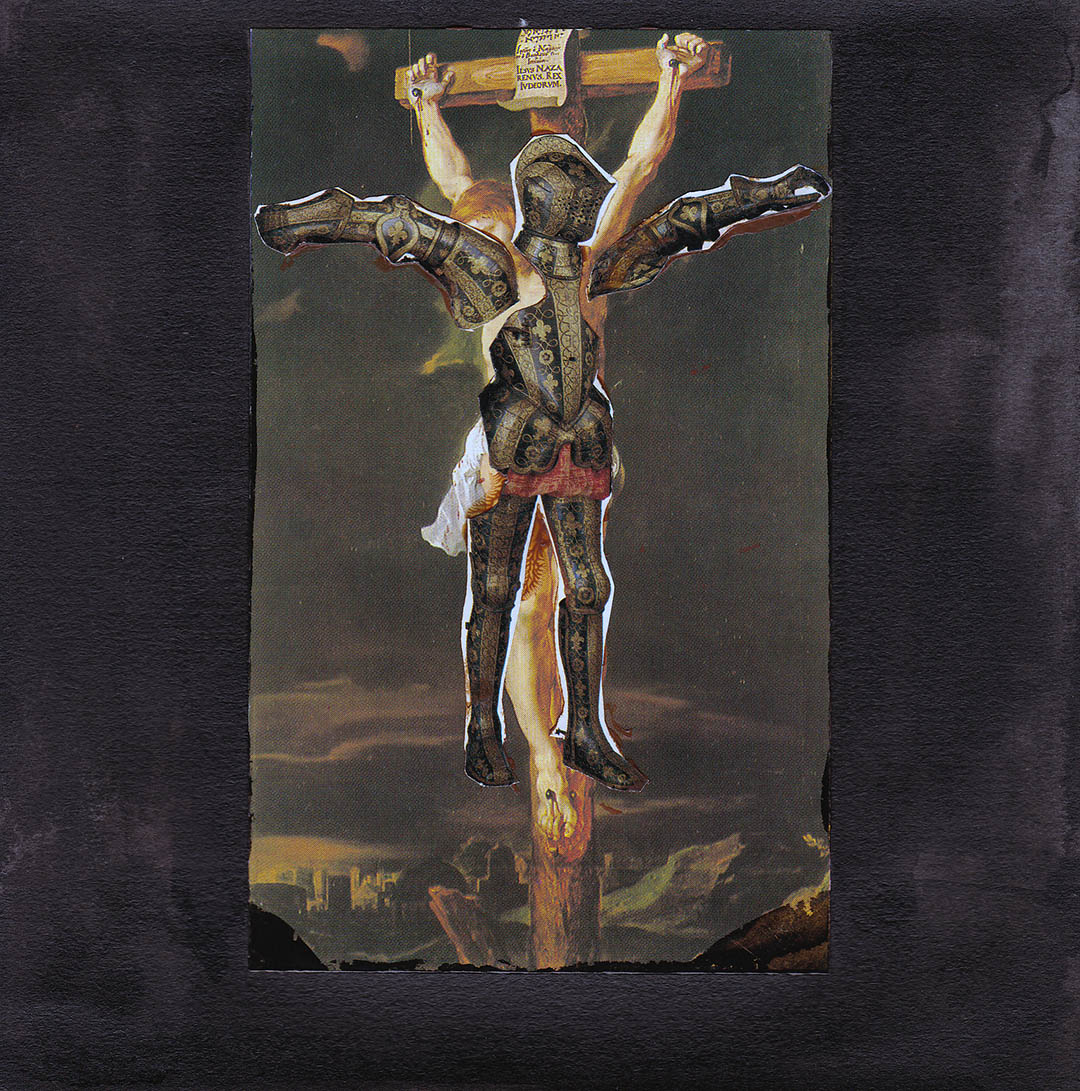 Drawing #10 from the cycle of 150 drawings “Crucifixion for the Fisherman”, 1991-1992
watercolor, brush, pencil on paper
Drawing #10 from the cycle of 150 drawings “Crucifixion for the Fisherman”, 1991-1992
watercolor, brush, pencil on paper
14 x 14 cm
numbered, signed and dated on the back More information on the series of drawings here -
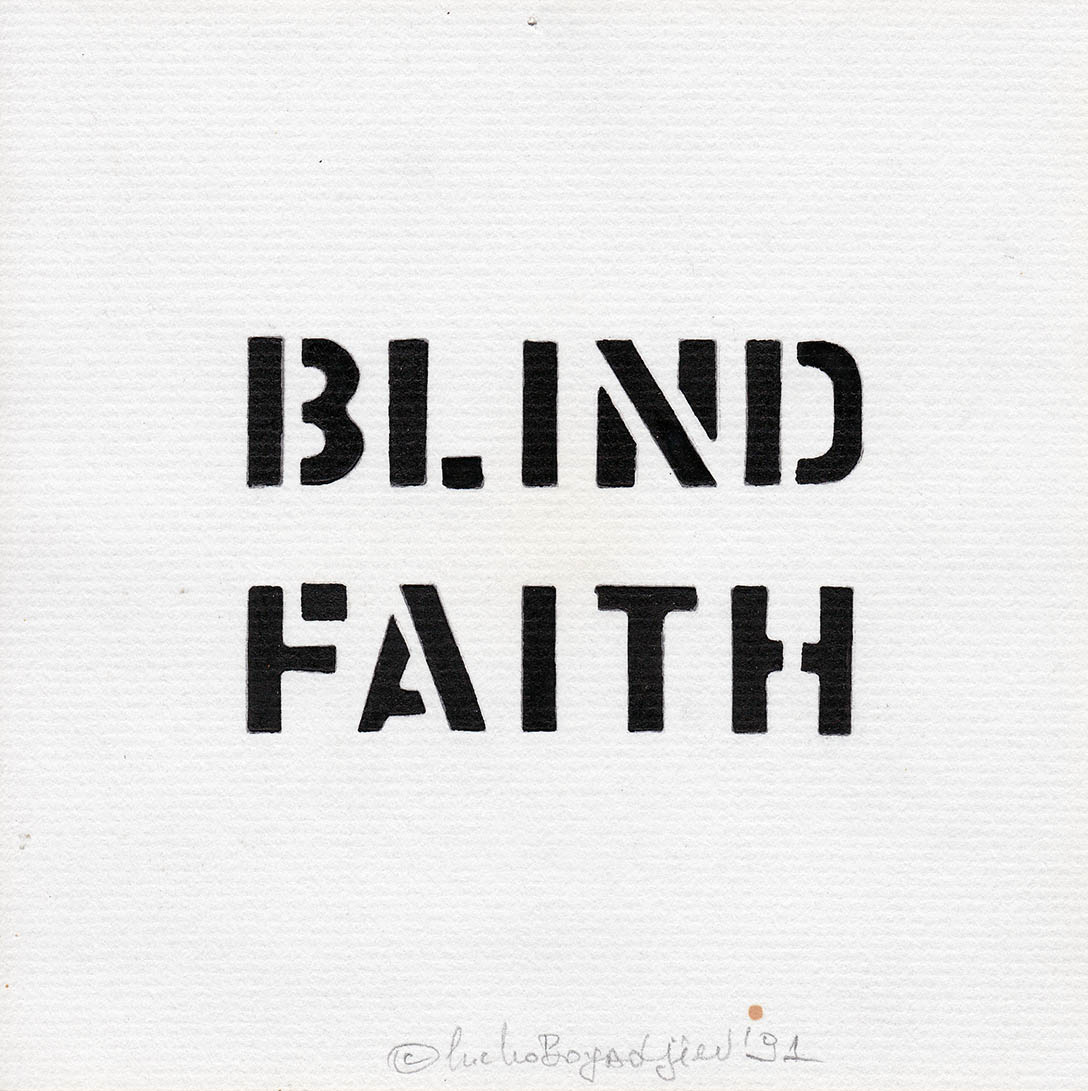 Drawing #102 from the cycle of 150 drawings “Crucifixion for the Fisherman”, 1991-1992
watercolor, brush, pencil on paper
Drawing #102 from the cycle of 150 drawings “Crucifixion for the Fisherman”, 1991-1992
watercolor, brush, pencil on paper
14 x 14 cm
numbered, signed and dated on the back More information on the series of drawings here -
 Drawing #50 from the cycle of 150 drawings “Crucifixion for the Fisherman”, 1991-1992
watercolor, brush, pencil on paper
Drawing #50 from the cycle of 150 drawings “Crucifixion for the Fisherman”, 1991-1992
watercolor, brush, pencil on paper
14 x 14 cm
numbered, signed and dated on the back More information on the series of drawings here -
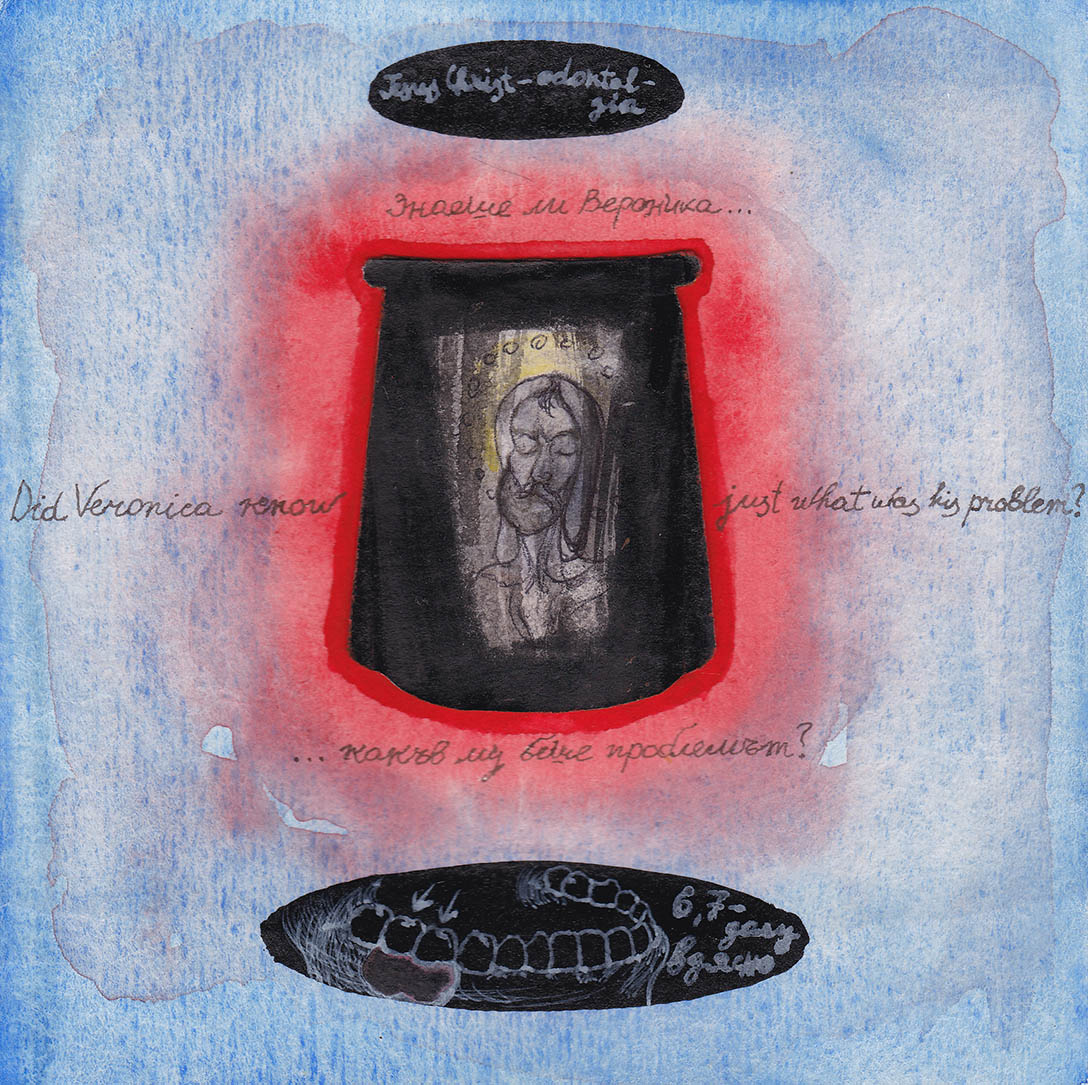 Drawing #116 from the cycle of 150 drawings “Crucifixion for the Fisherman”, 1991-1992
watercolor, brush, pencil on paper
Drawing #116 from the cycle of 150 drawings “Crucifixion for the Fisherman”, 1991-1992
watercolor, brush, pencil on paper
14 x 14 cm
numbered, signed and dated on the back More information on the series of drawings here -
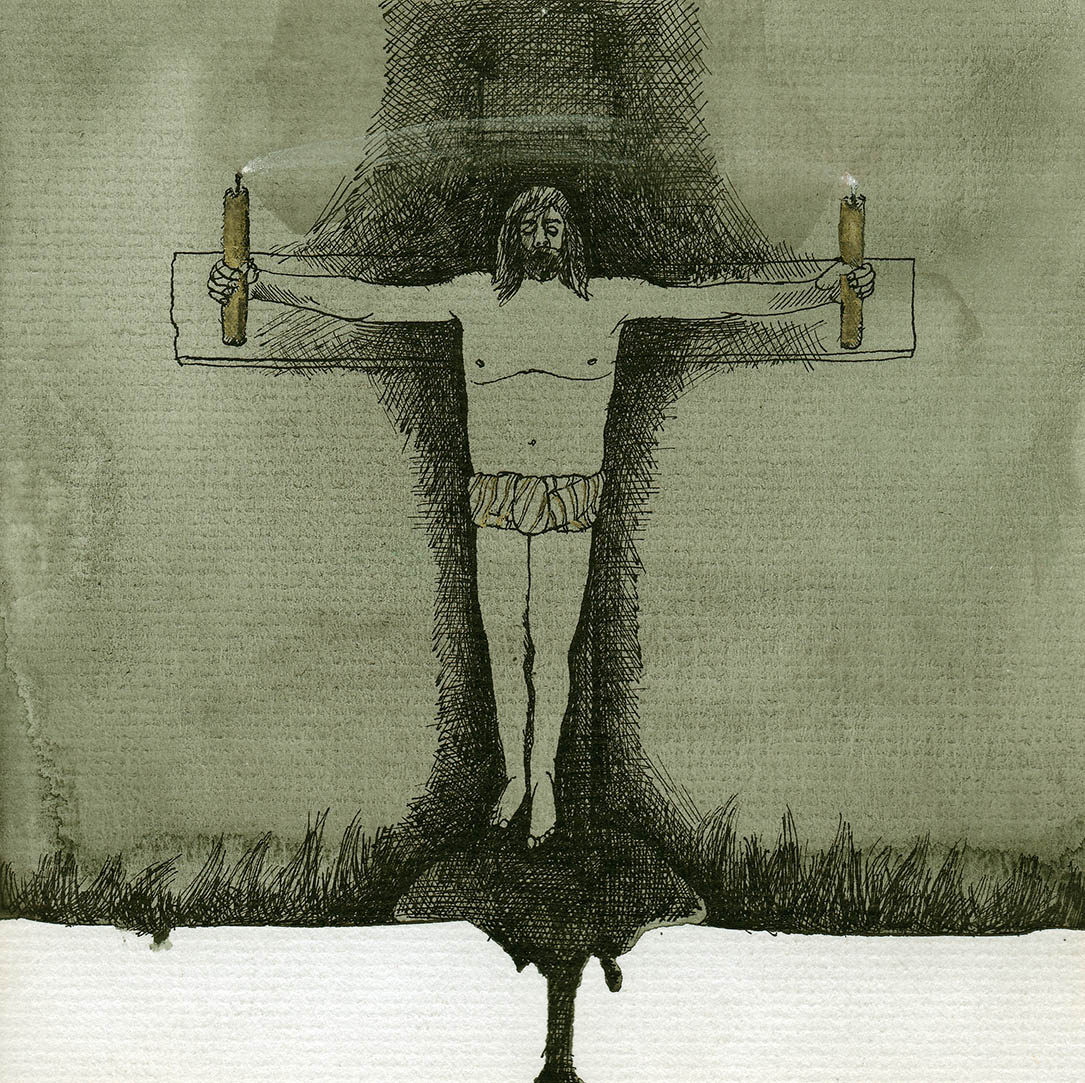 Drawing #52 from the cycle of 150 drawings “Crucifixion for the Fisherman”, 1991-1992
watercolor, brush, pencil on paper
Drawing #52 from the cycle of 150 drawings “Crucifixion for the Fisherman”, 1991-1992
watercolor, brush, pencil on paper
14 x 14 cm
numbered, signed and dated on the back More information on the series of drawings here -
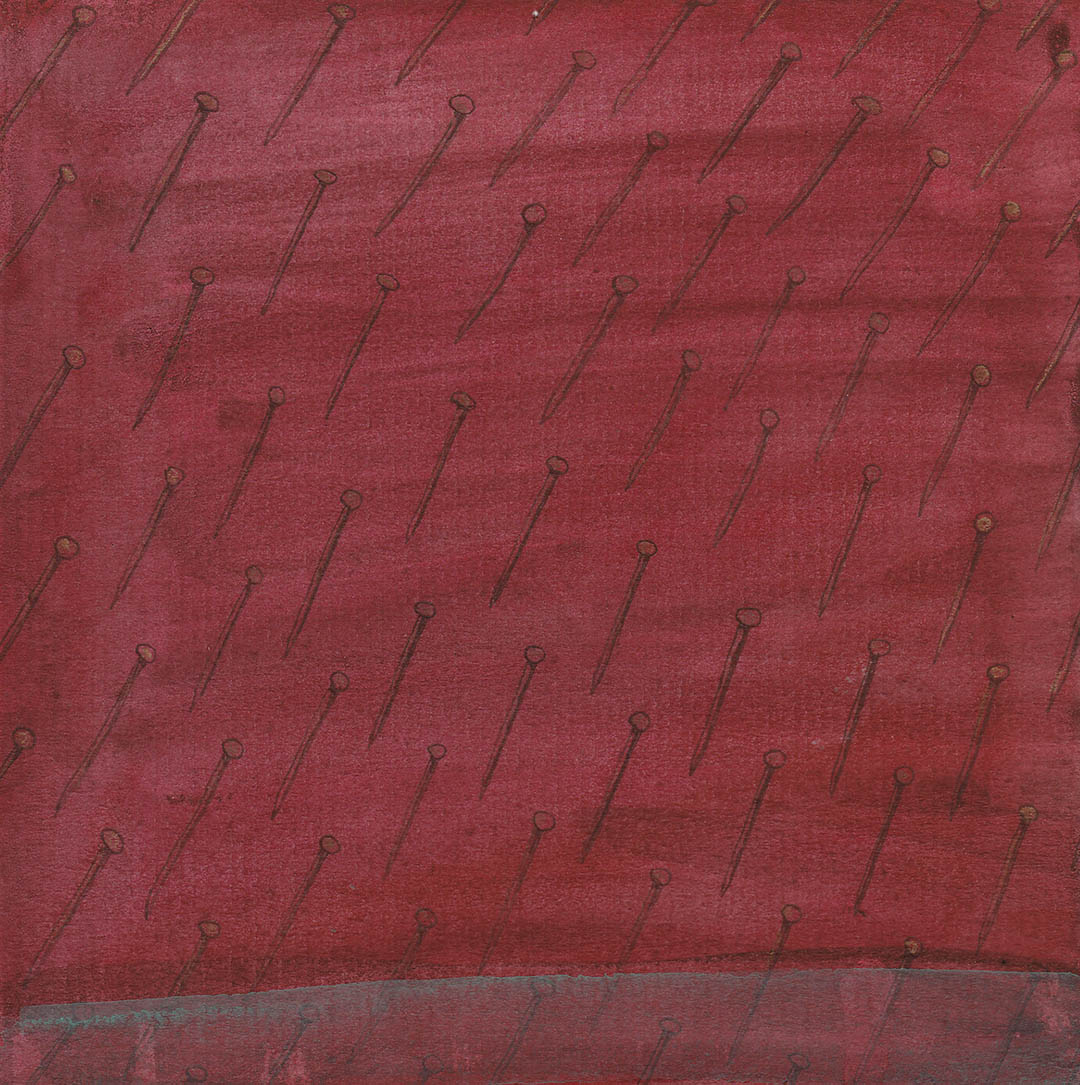 Drawing #28 from the cycle of 150 drawings “Crucifixion for the Fisherman”, 1991-1992
watercolor, brush, pencil on paper
Drawing #28 from the cycle of 150 drawings “Crucifixion for the Fisherman”, 1991-1992
watercolor, brush, pencil on paper
14 x 14 cm
numbered, signed and dated on the back More information on the series of drawings here -
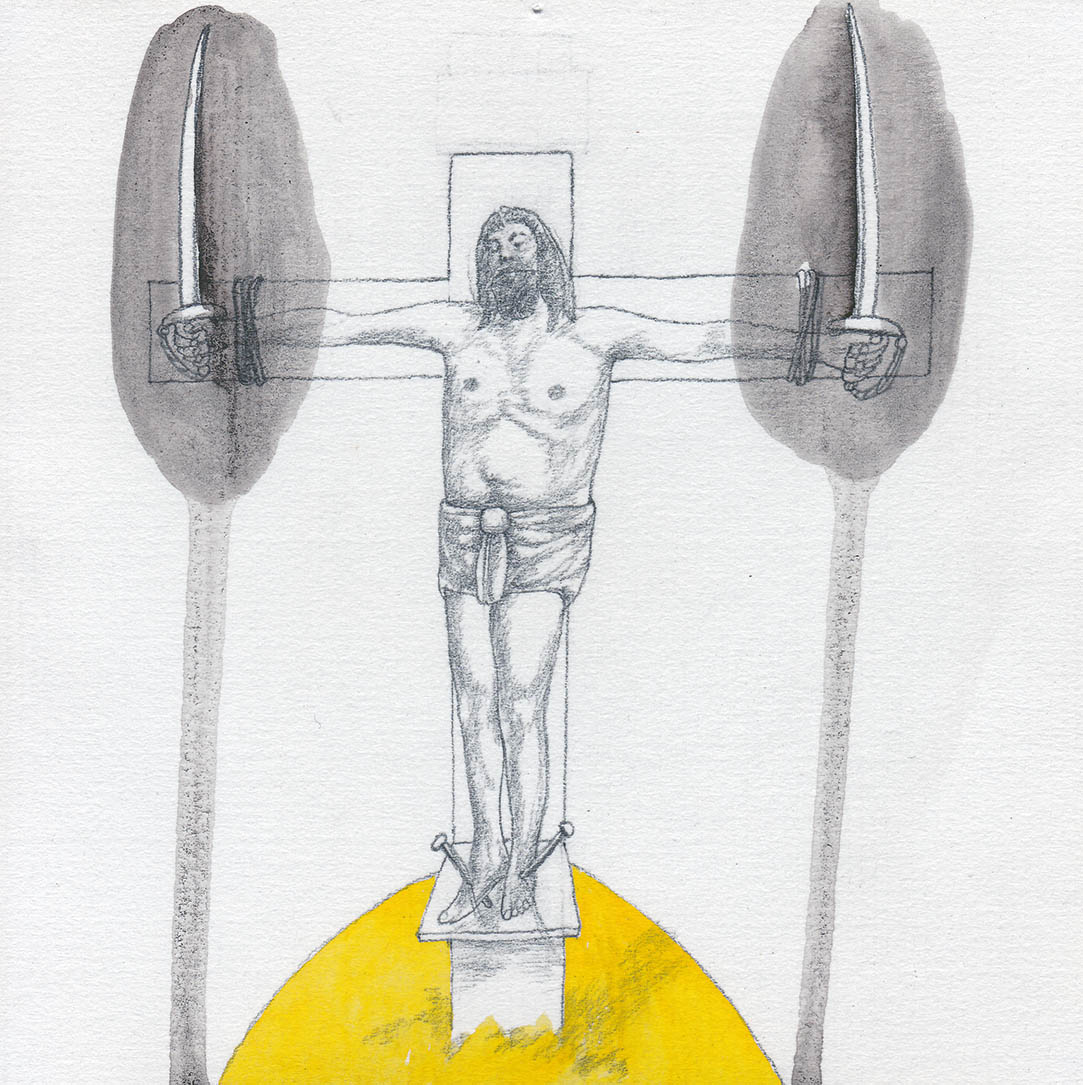 Drawing #55 from the cycle of 150 drawings “Crucifixion for the Fisherman”, 1991-1992
watercolor, brush, pencil on paper
Drawing #55 from the cycle of 150 drawings “Crucifixion for the Fisherman”, 1991-1992
watercolor, brush, pencil on paper
14 x 14 cm
numbered, signed and dated on the back More information on the series of drawings here -
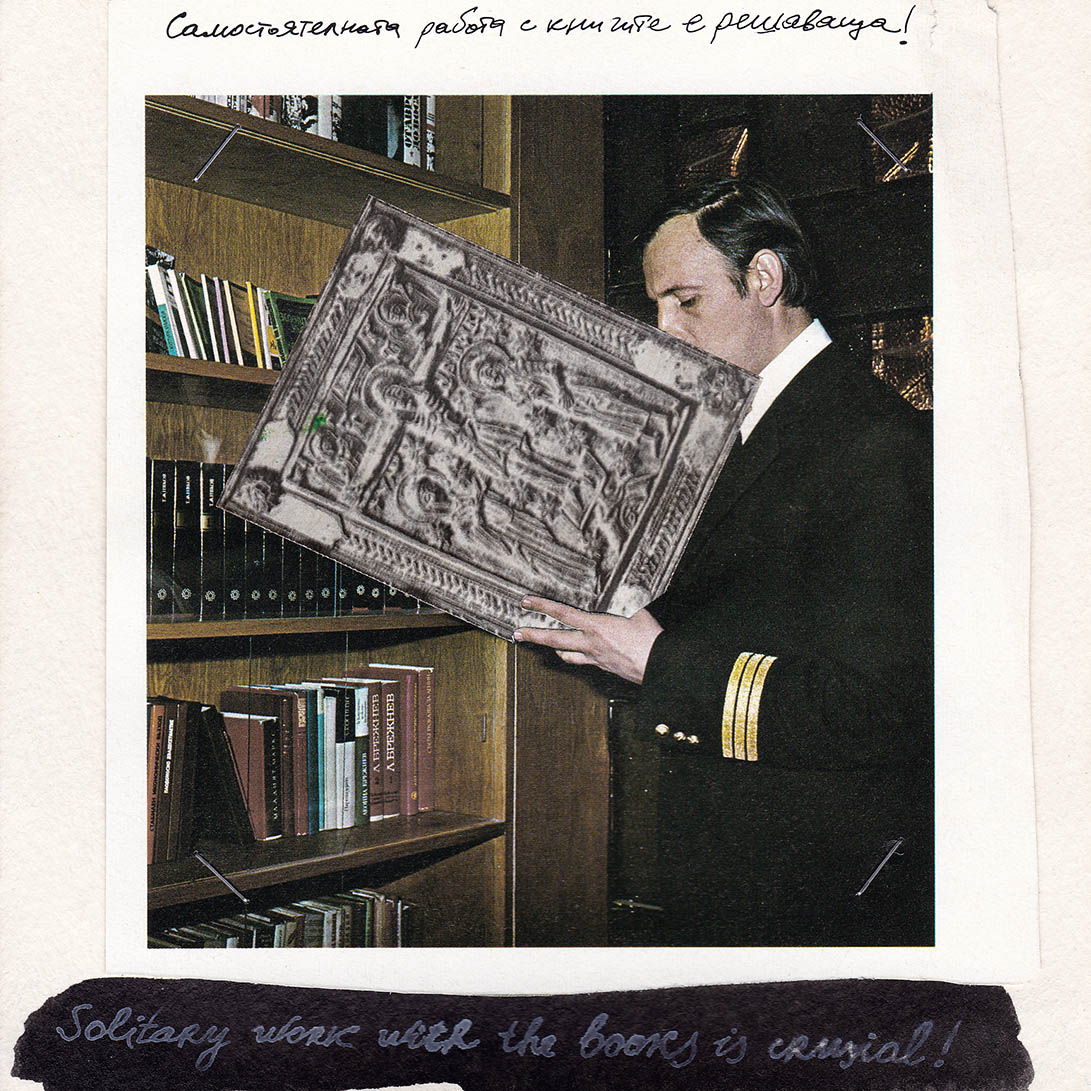 Drawing #103 from the cycle of 150 drawings “Crucifixion for the Fisherman”, 1991-1992
watercolor, brush, pencil on paper
Drawing #103 from the cycle of 150 drawings “Crucifixion for the Fisherman”, 1991-1992
watercolor, brush, pencil on paper
14 x 14 cm
numbered, signed and dated on the back More information on the series of drawings here -
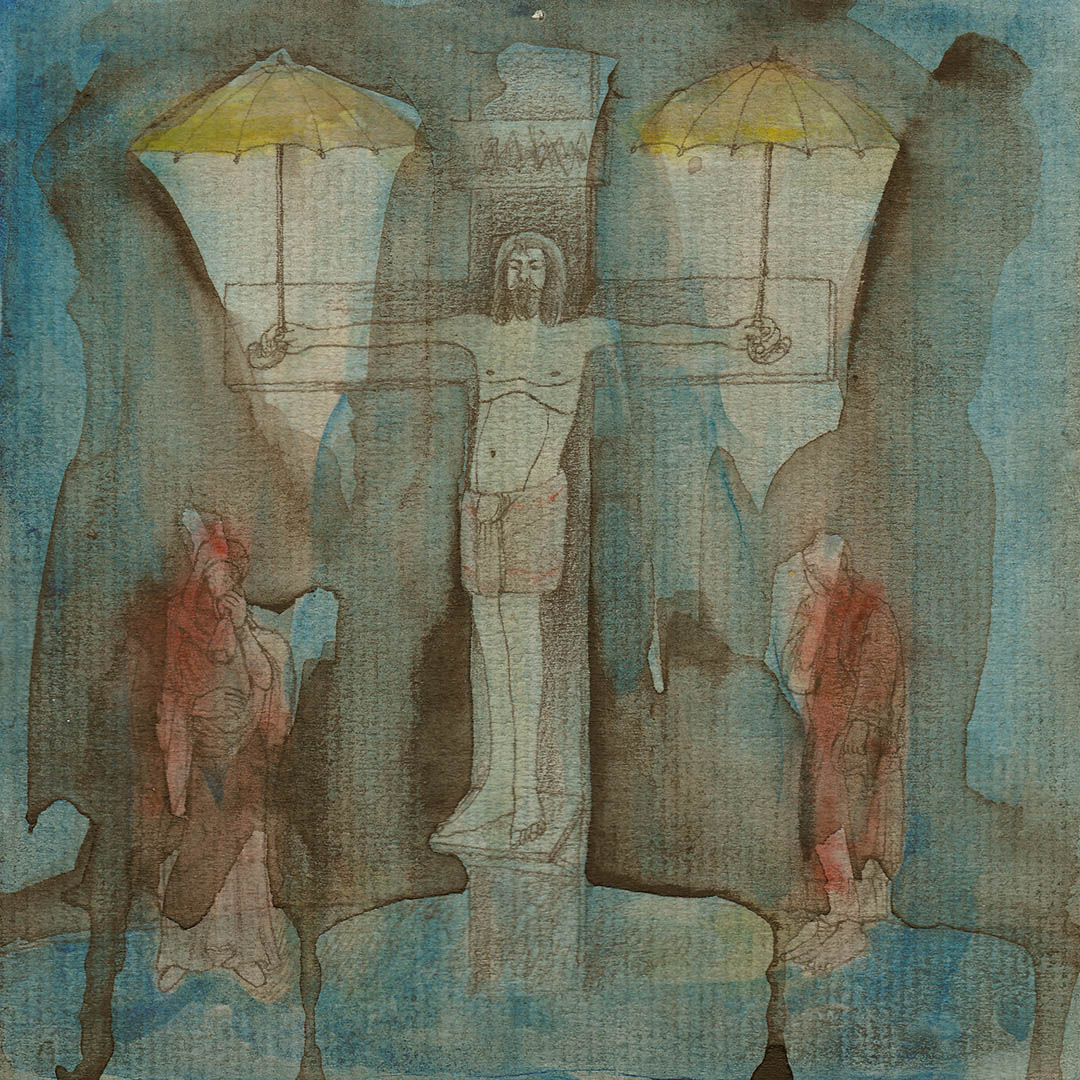 Drawing #47 from the cycle of 150 drawings “Crucifixion for the Fisherman”, 1991-1992
watercolor, brush, pencil on paper
Drawing #47 from the cycle of 150 drawings “Crucifixion for the Fisherman”, 1991-1992
watercolor, brush, pencil on paper
14 x 14 cm
numbered, signed and dated on the back More information on the series of drawings here -
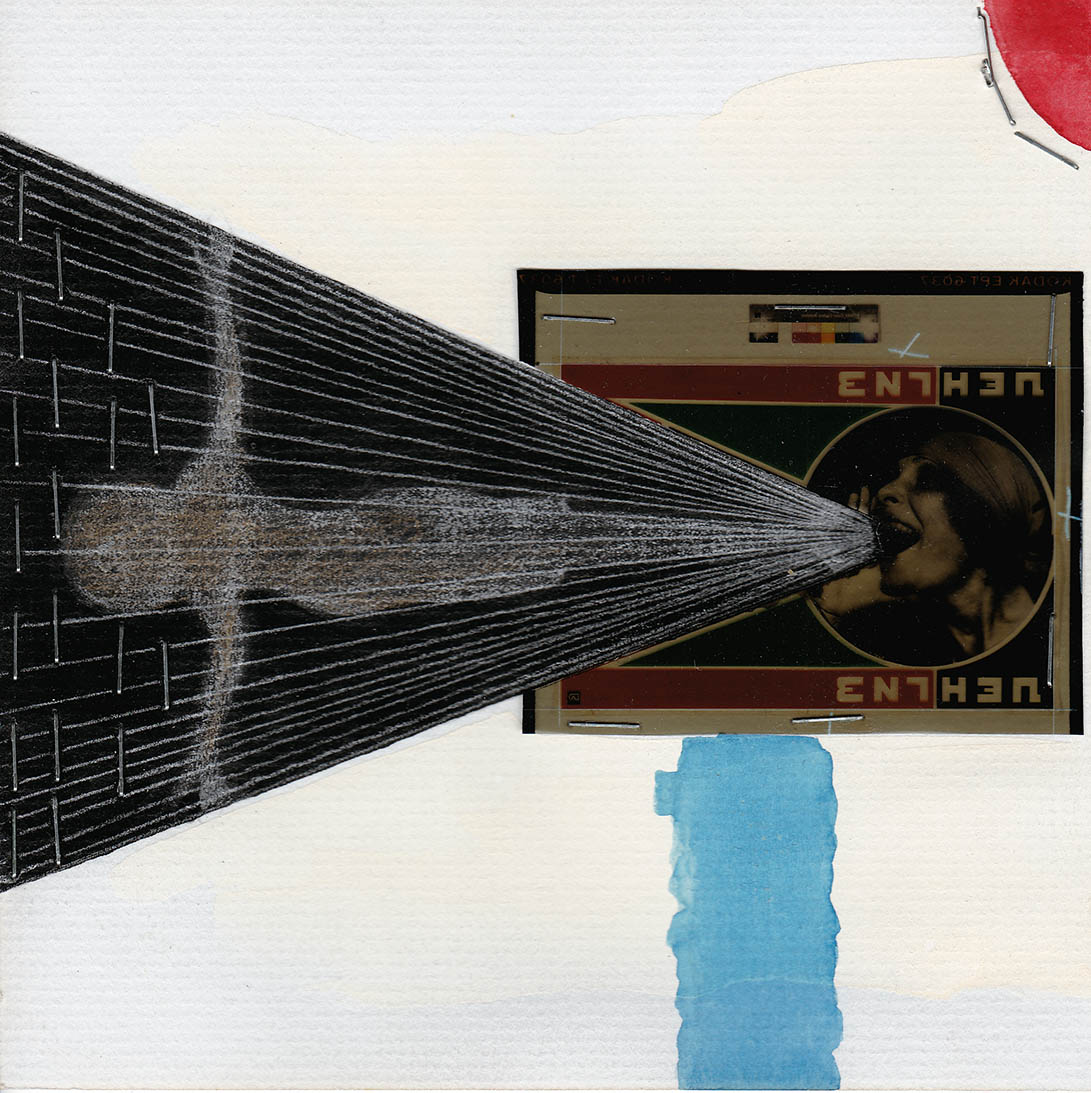 Drawing #134 from the cycle of 150 drawings “Crucifixion for the Fisherman”, 1991-1992
watercolor, brush, pencil on paper
Drawing #134 from the cycle of 150 drawings “Crucifixion for the Fisherman”, 1991-1992
watercolor, brush, pencil on paper
14 x 14 cm
numbered, signed and dated on the back More information on the series of drawings here -
 Drawing #132 from the cycle of 150 drawings “Crucifixion for the Fisherman”, 1991-1992
watercolor, brush, pencil on paper
Drawing #132 from the cycle of 150 drawings “Crucifixion for the Fisherman”, 1991-1992
watercolor, brush, pencil on paper
14 x 14 cm
numbered, signed and dated on the back More information on the series of drawings here -
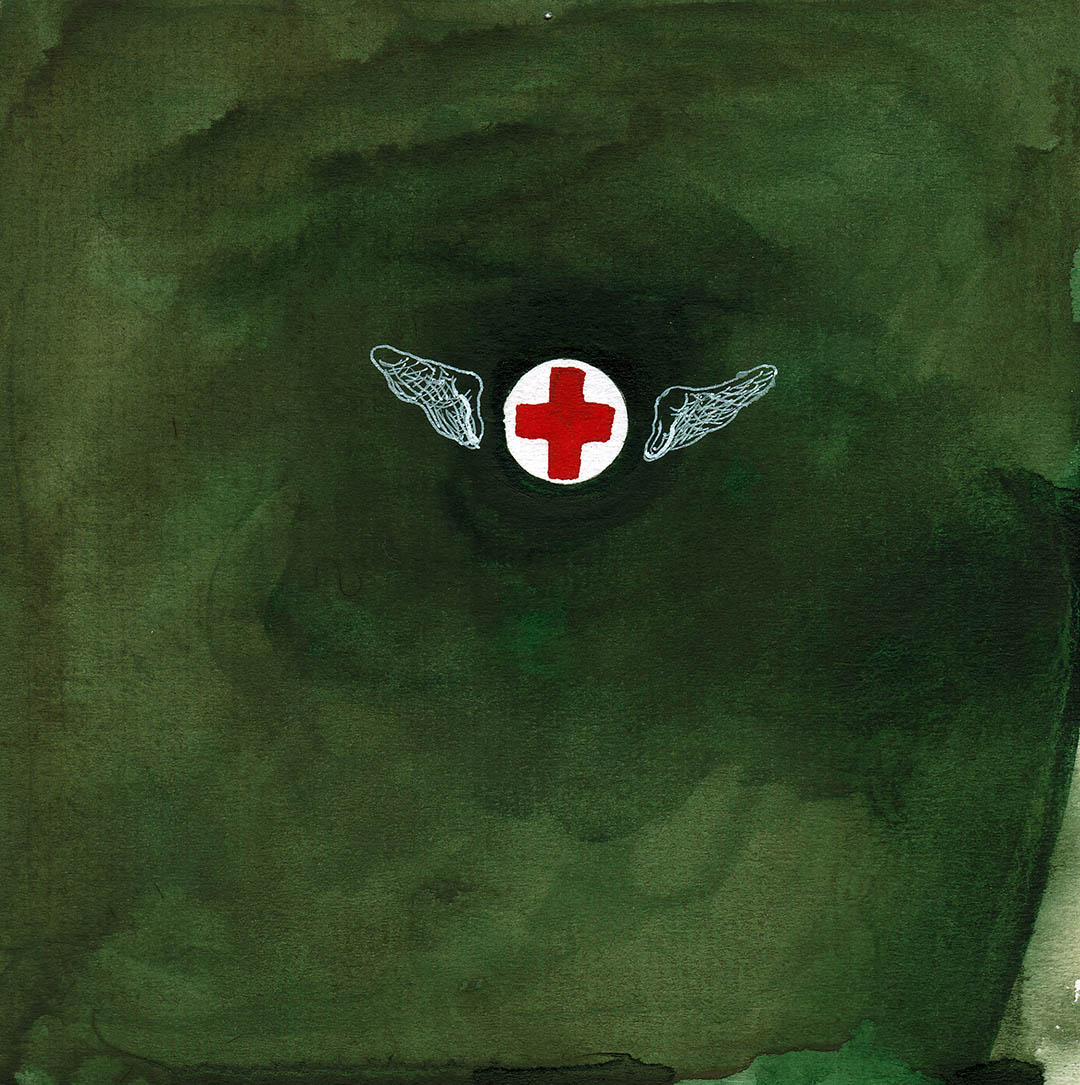 Drawing #93 from the cycle of 150 drawings “Crucifixion for the Fisherman”, 1991-1992
watercolor, pencil, ink and pen
Drawing #93 from the cycle of 150 drawings “Crucifixion for the Fisherman”, 1991-1992
watercolor, pencil, ink and pen
14 x 14 cm
numbered, signed and dated on the back More information on the series of drawings here -
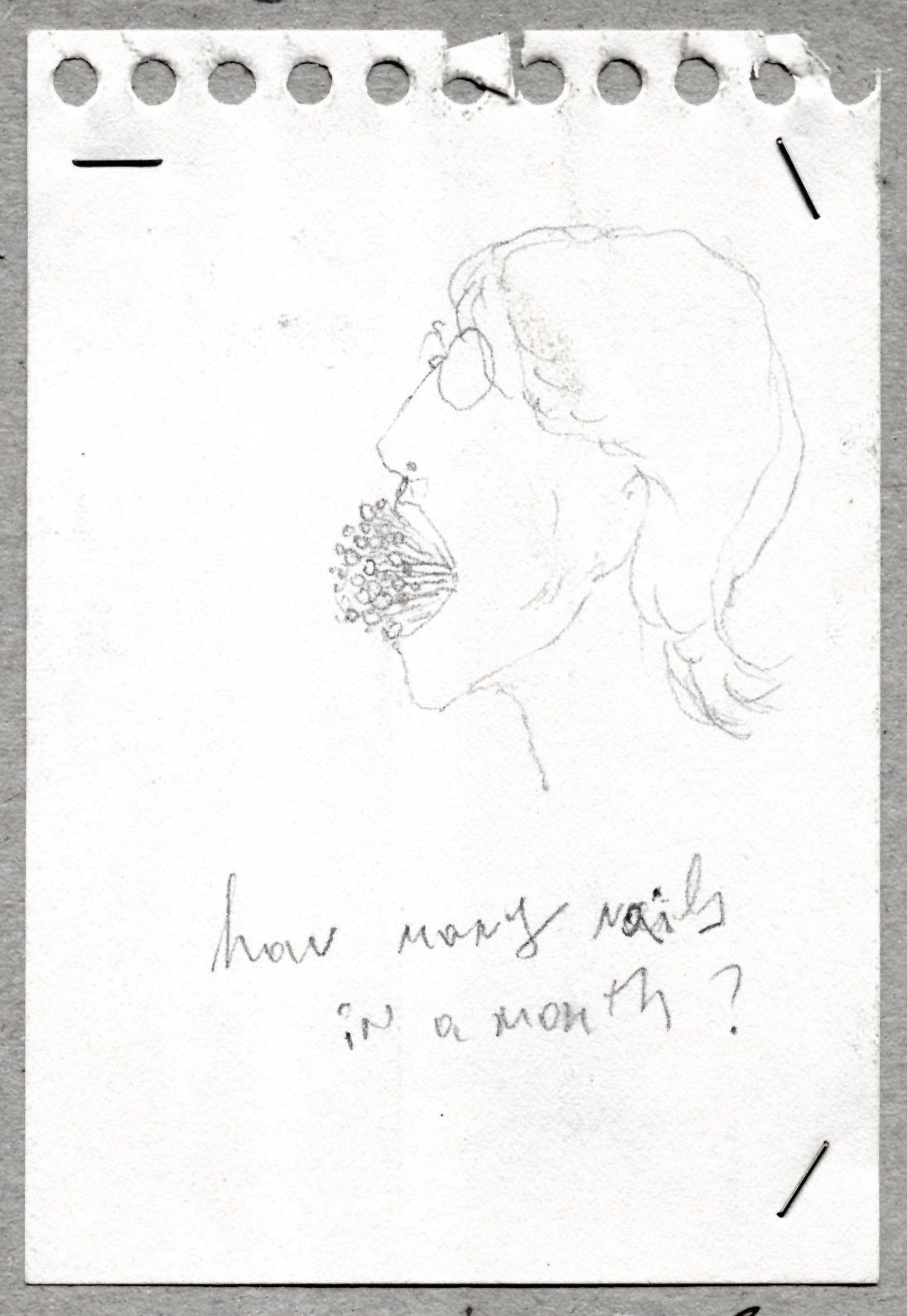 How many nails in a mouth?, 1992
drawing
How many nails in a mouth?, 1992
drawing
12.8 x 8.7 cm This image represents and attempt at self-exploration. The “How many nails in a mouth?” work started as a pencil-on-paper drawing expressing inner turmoil and anguish related to a deep family crisis. The drawing was made in the summer of 1992 on the terrace in front of the Albertina Museum in Vienna. Later on it evolved into a photographic work subtitled “Homage to Günther Uecker” – as a part of a cycle of homage(s) first shown at “Orient/ation”, the 4th Istanbul Biennial, curated by René Block in 1995. -
 Drawing #117 from the cycle of 150 drawings “Crucifixion for the Fisherman”, 1991-1992
watercolor, brush, pencil on paper
Drawing #117 from the cycle of 150 drawings “Crucifixion for the Fisherman”, 1991-1992
watercolor, brush, pencil on paper
14 x 14 cm
numbered, signed and dated on the back More information on the series of drawings here -
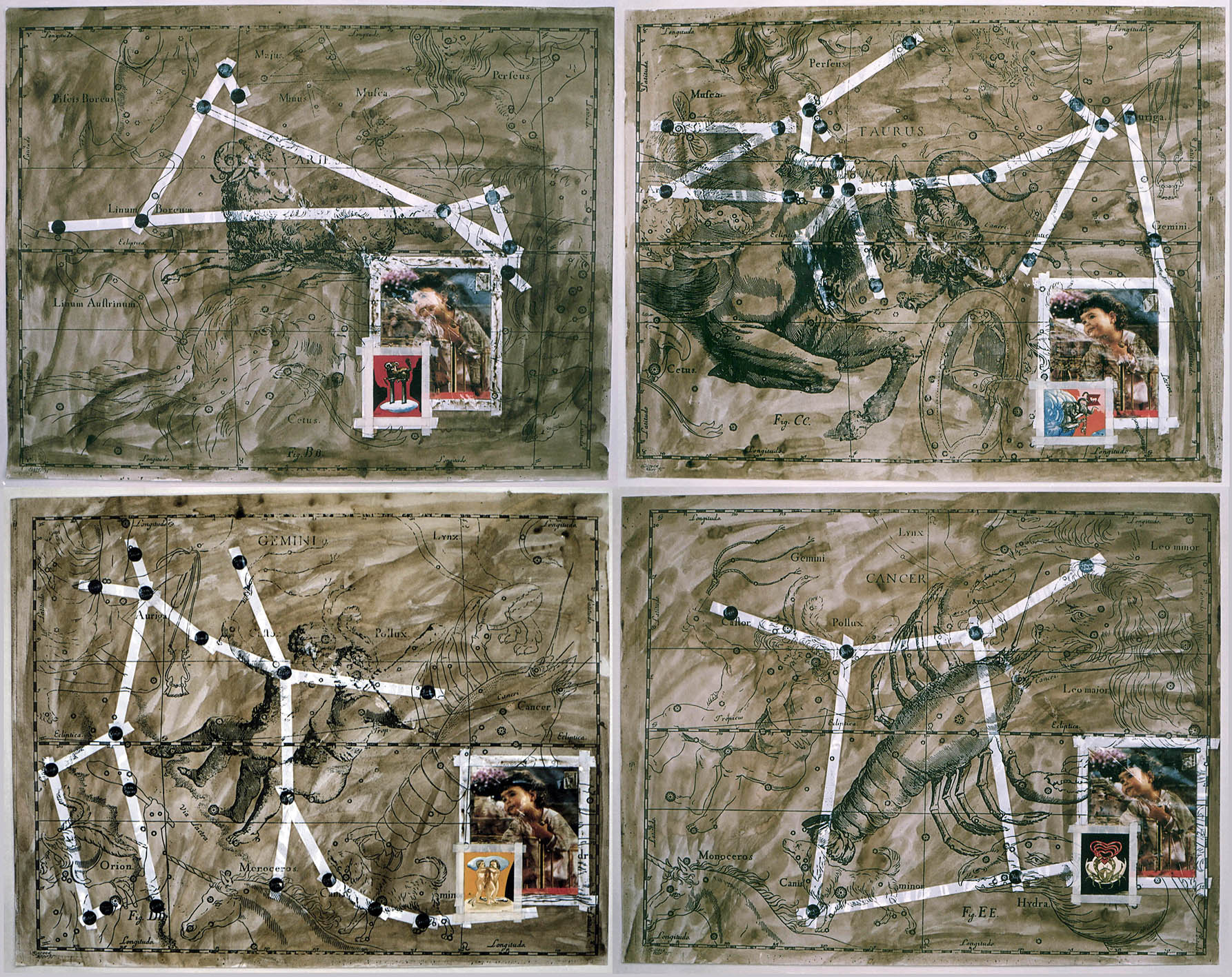 Astrologic, 1995
cycle of 12 drawings
Astrologic, 1995
cycle of 12 drawings
sepia ink, scotch tape, watercolor, Xerox, etc. on paper
each one 70 x 90 cm During the formative years of the Sofia art scene in the early 1990s, the work is interpreting the “constellation” of leading contemporary artists in Bulgaria from the time as if they are actual stars (in the skies) by grouping them in a work according to their astrological sign. All drawings can be viewed here -
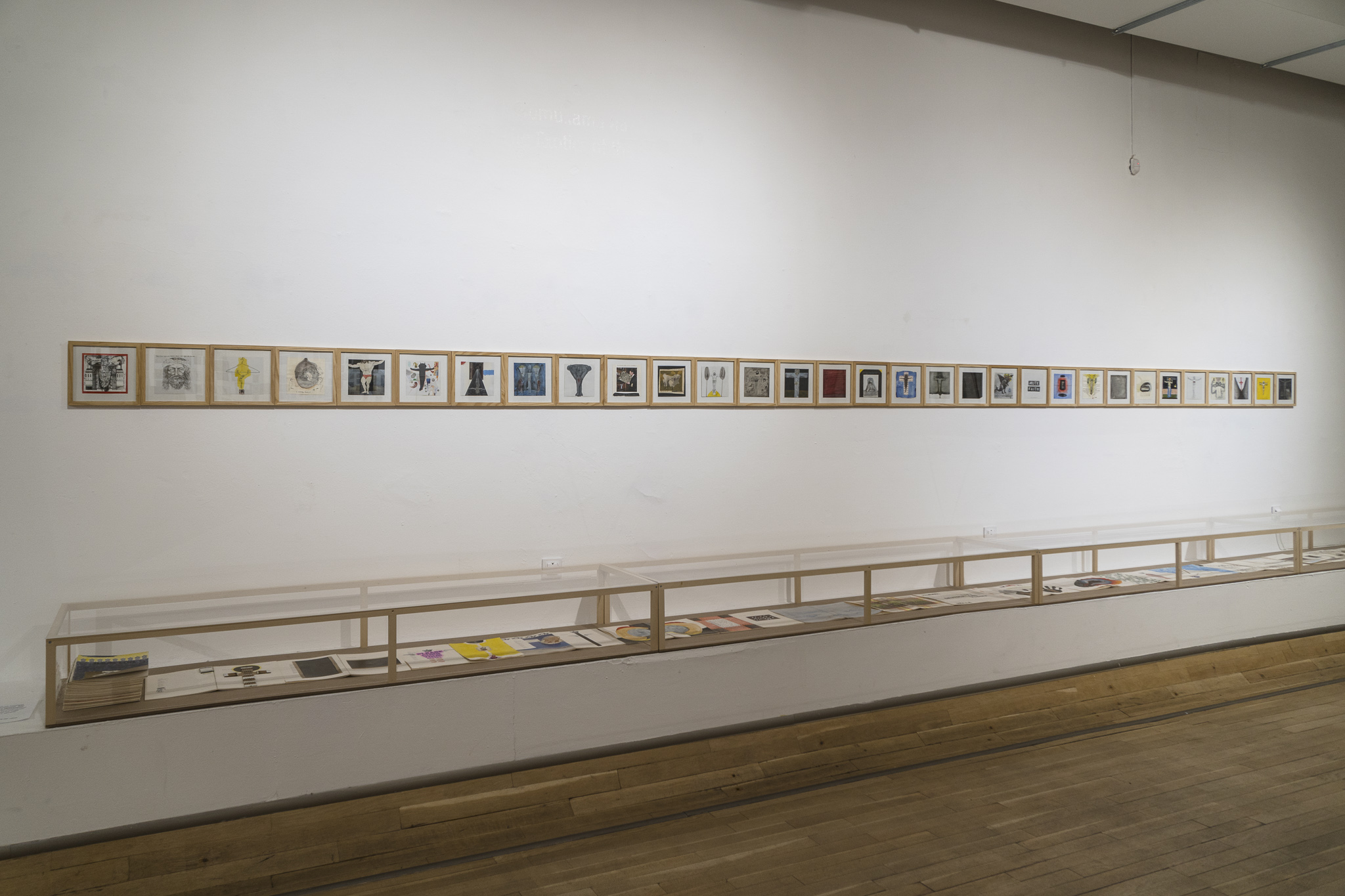 Crucifixion for the Fisherman, 1991-1992
cycle of 150 drawings
Crucifixion for the Fisherman, 1991-1992
cycle of 150 drawings
watercolor, pencil, ink and pen, collage on paper
14 x 14 cm each
numbered, signed and dated on the back In 1990‐1997 the artist responded in several works to the vulgar reintroduction of, what he called – “religion without faith”, in the post‐1989 Bulgaria. The drawings envision a multiplication of the figure of Christ in each and every one, believer or not – Jesus is depicted as a teacher nailed to a blackboard; as a bodybuilder; as an aboriginal; as an extra‐terrestrial; as a family man whose presumed family with 4 children sleeps in a bed shaped like a cross; as a rain of nails over Golgotha and many more. Drawings can be viewed here -
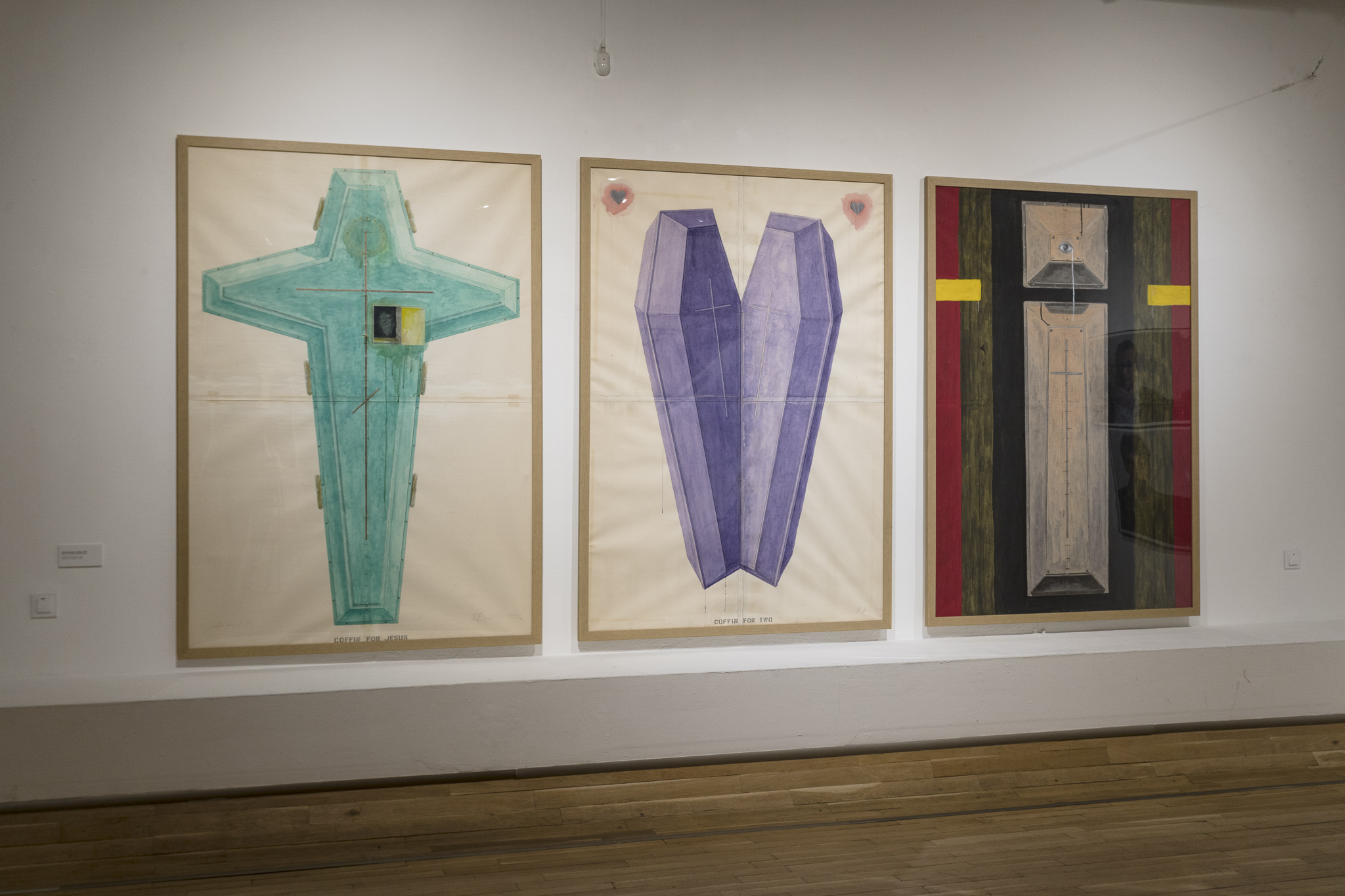 Existential Cemetery, 1992
Cycle of 3 drawings on paper
Existential Cemetery, 1992
Cycle of 3 drawings on paper
pencil, tempera and watercolor, collage
200 x 140 cm each At the end of the tumultuous year of 1992 in the life of the author – full of professional success and personal drama, the artist created 3 drawings of coffins: a/ a coffin for the Ego – shaped like the English letter “I” with head separated from the body; b/ a coffin for Two People who die in their love; and c/ a coffin for Jesus – as a symbolic gesture of liberating himself from the 3 main existential items for each human being – the self, the other and the transcendental. -
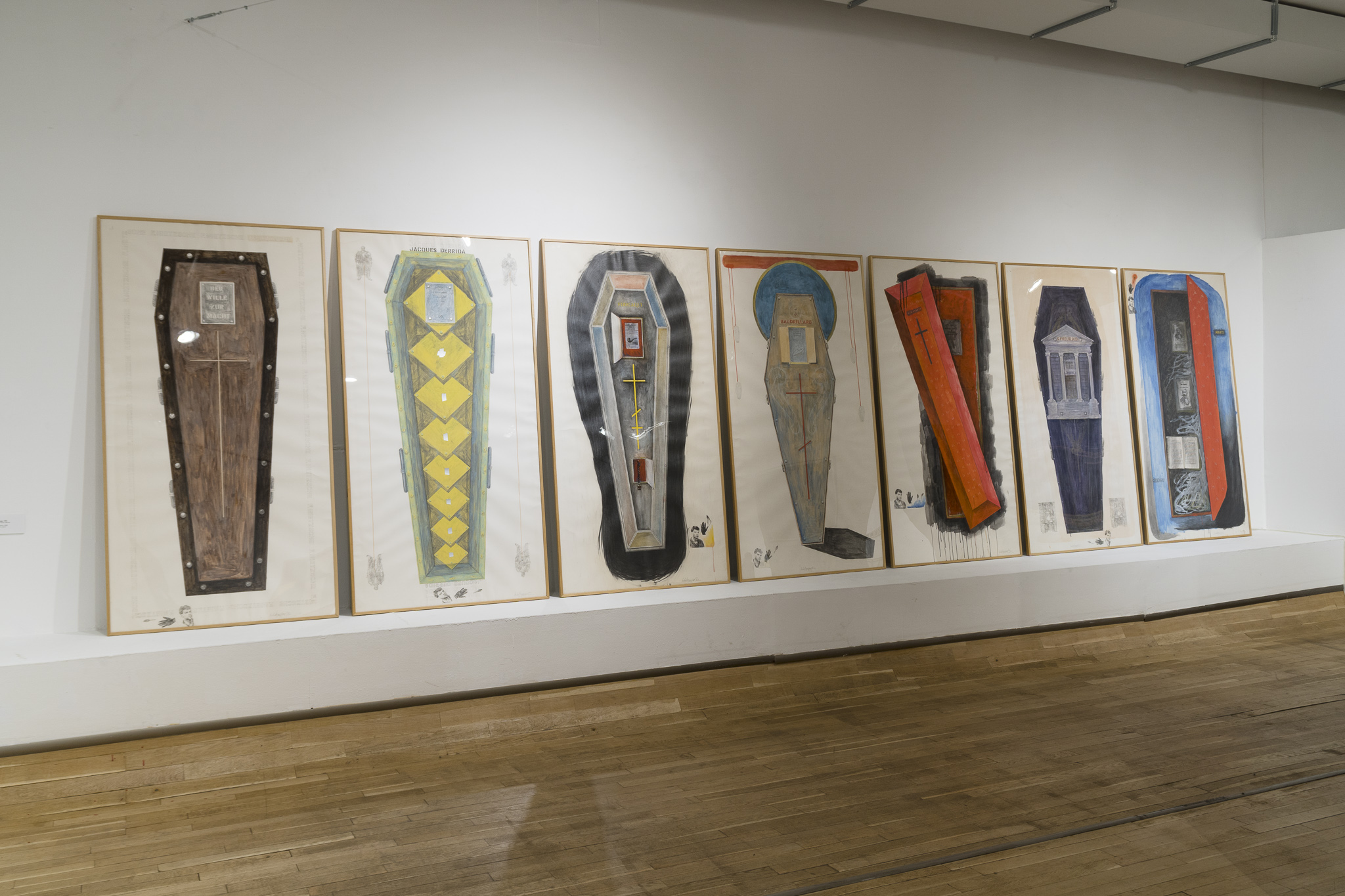 Philosophical Cemetery, 1992
cycle of 7 drawings on paper
Philosophical Cemetery, 1992
cycle of 7 drawings on paper
pencil, tempera and watercolor, collage
167 x 87 cm each In the aftermath of the fall of the Berlin Wall in 1989, the artist decided to get rid of the strong ideologies of the 20th c. that had defined the world to such disastrous results of war and human tragedy. He also made drawing to symbolically liberate himself from theory and start all over again, as well as to “bury” in this way books by (on the photograph, from left to right) Nietzsche, Derrida, Foucault, Baudrillard, Lenin, Freud, and Marx. Drawings available (on the photograph, from left to right): Nietzsche, Foucault, Baudrillard, Lenin, and Freud. Drawings can be viewed here -
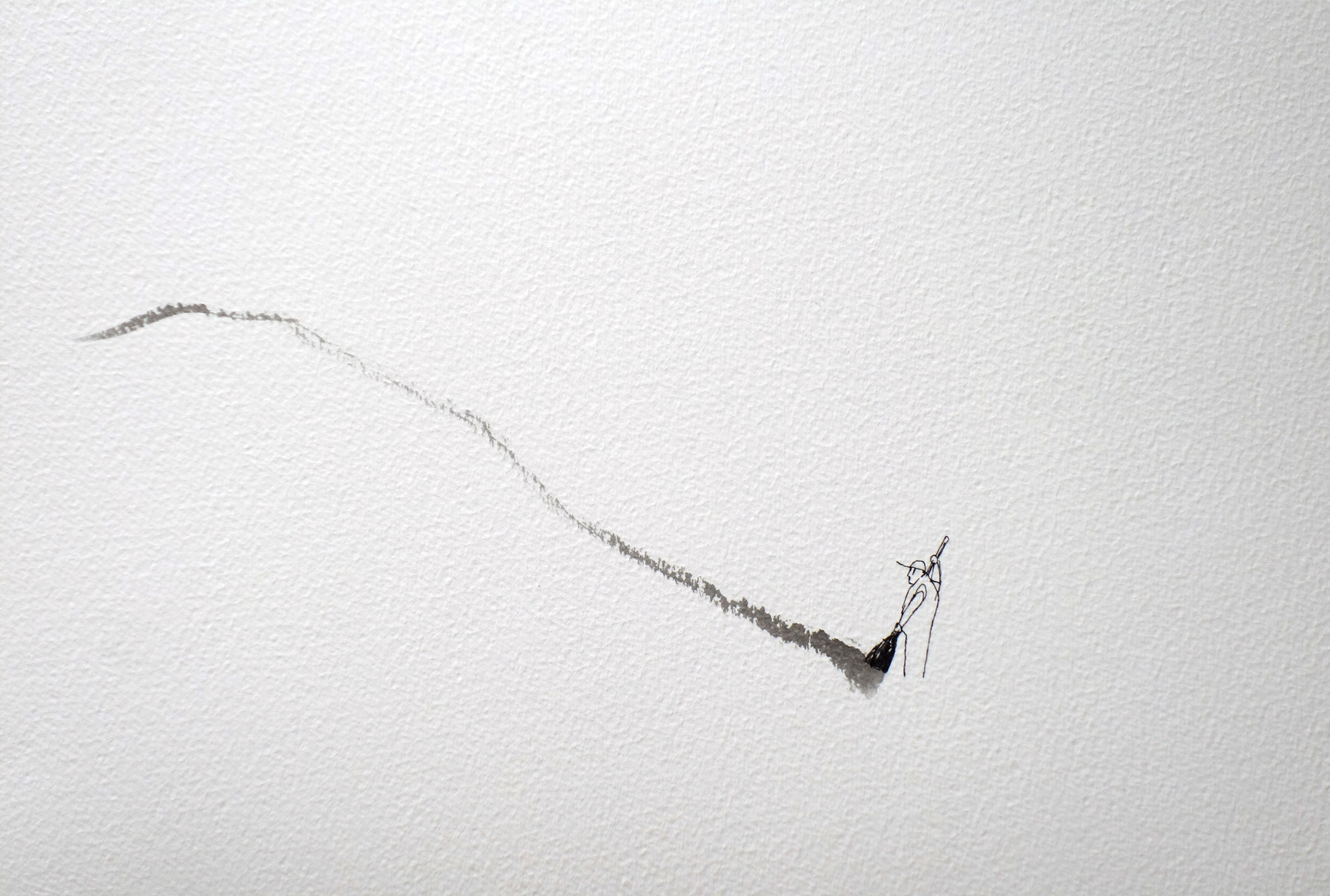 Art and Labor, 2013
isograph pen, brush and ink on paper
Art and Labor, 2013
isograph pen, brush and ink on paper
19 x 28 cm (unframed) -
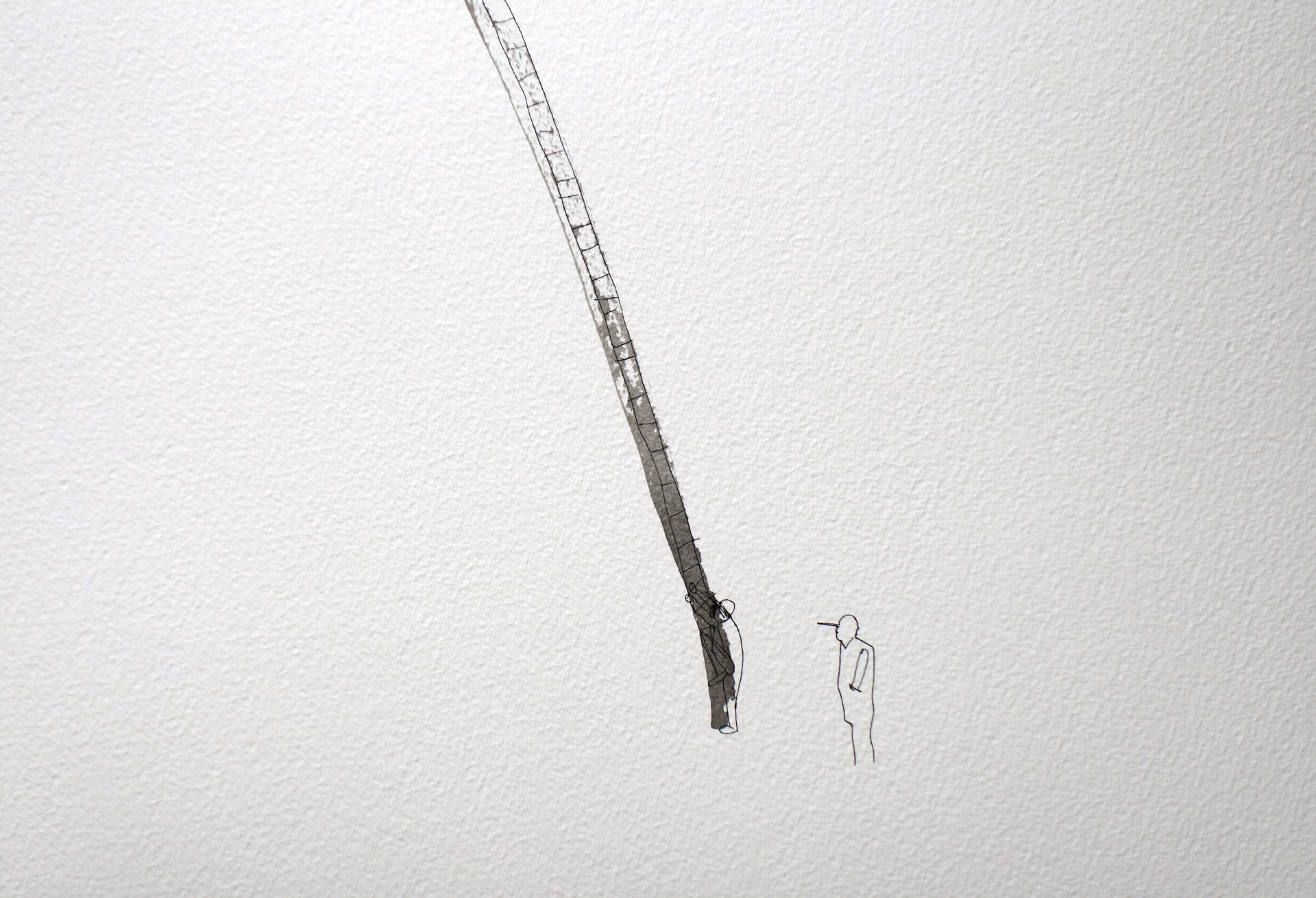 Art and Labor, 2013
isograph pen, brush and ink on paper
Art and Labor, 2013
isograph pen, brush and ink on paper
19 x 28 cm (unframed) -
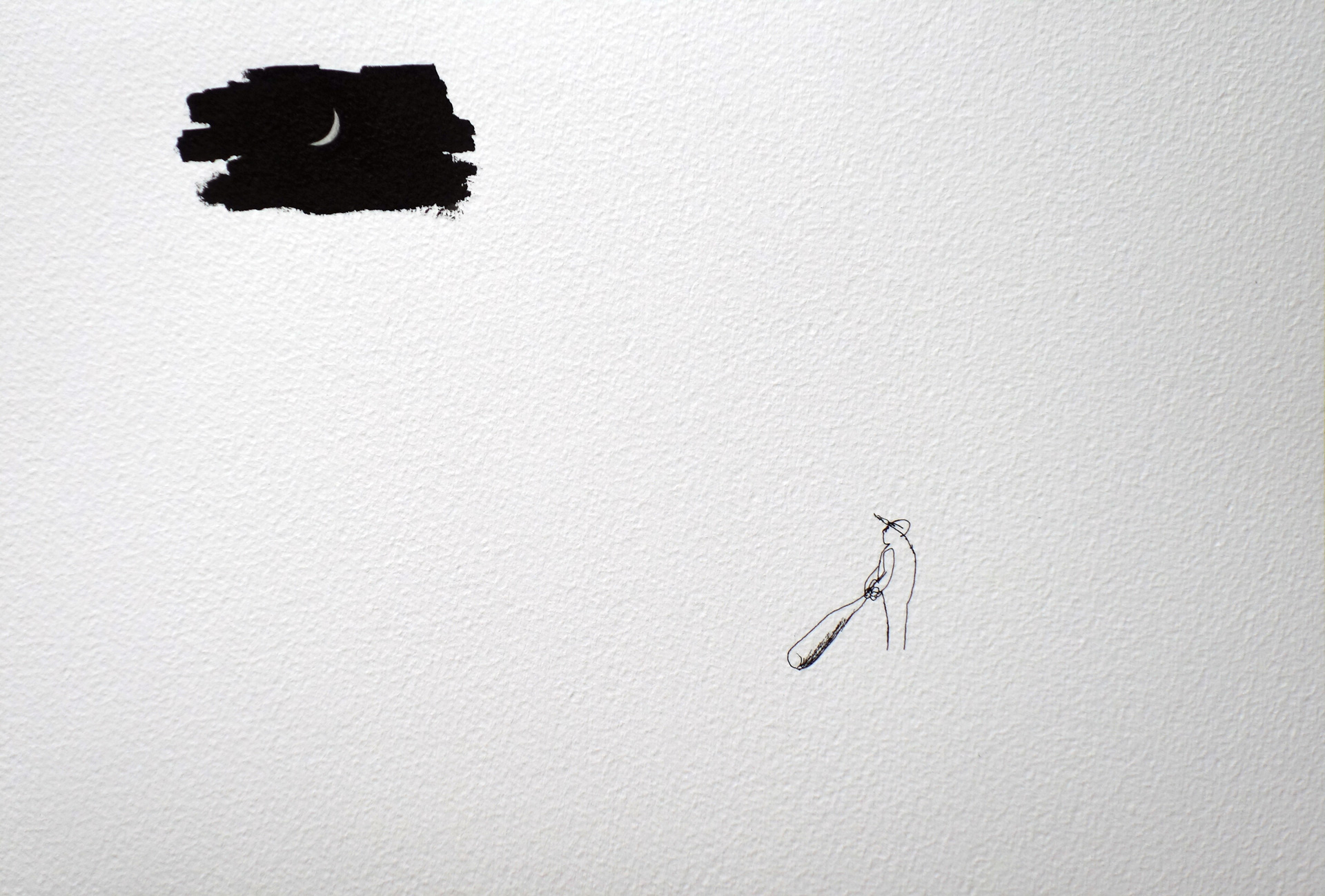 Art and Labor, 2013
isograph pen, brush and ink on paper
Art and Labor, 2013
isograph pen, brush and ink on paper
19 x 28 cm (unframed) -
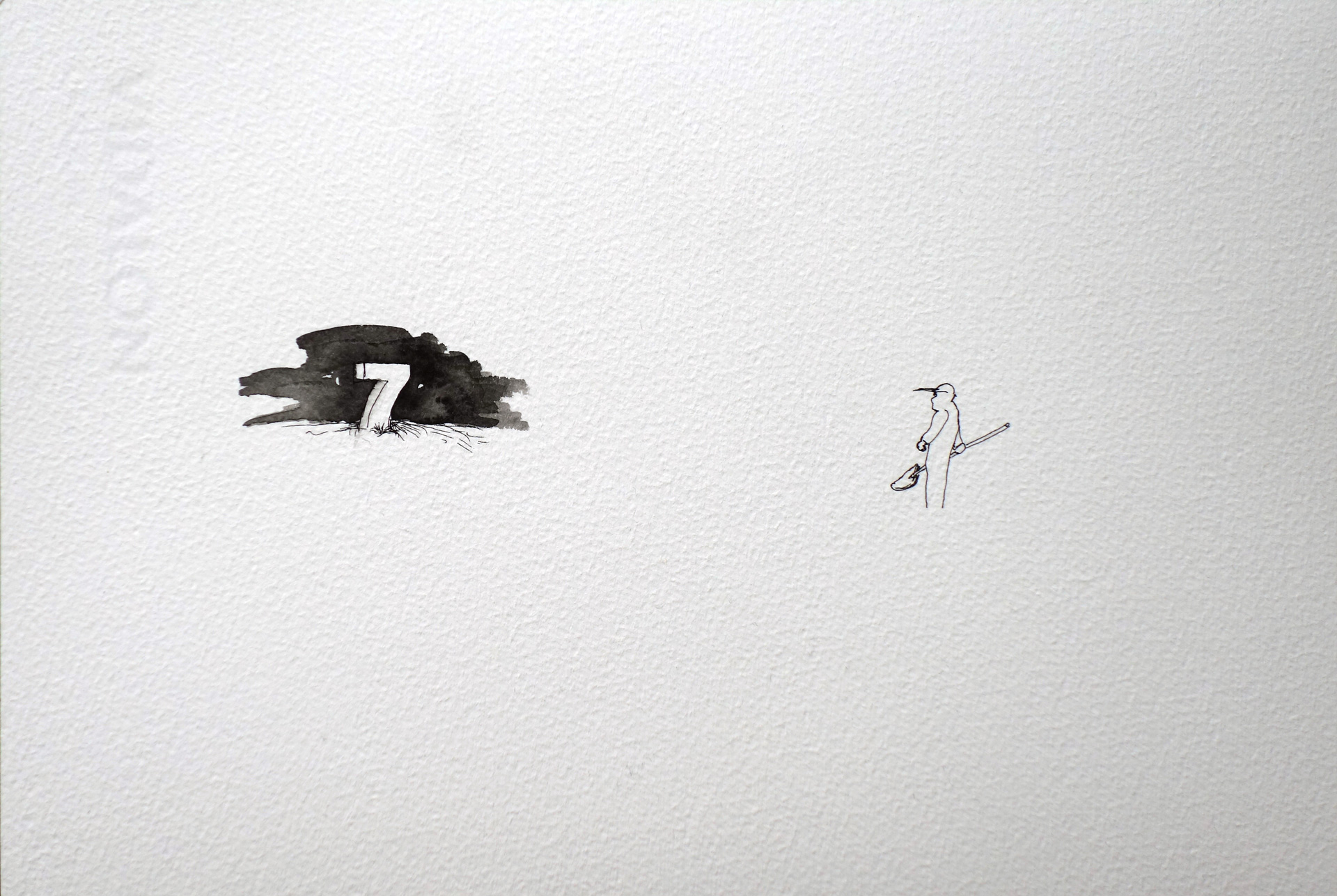 Art and Labor, 2013
isograph pen, brush and ink on paper
Art and Labor, 2013
isograph pen, brush and ink on paper
19 x 28 cm (unframed) -
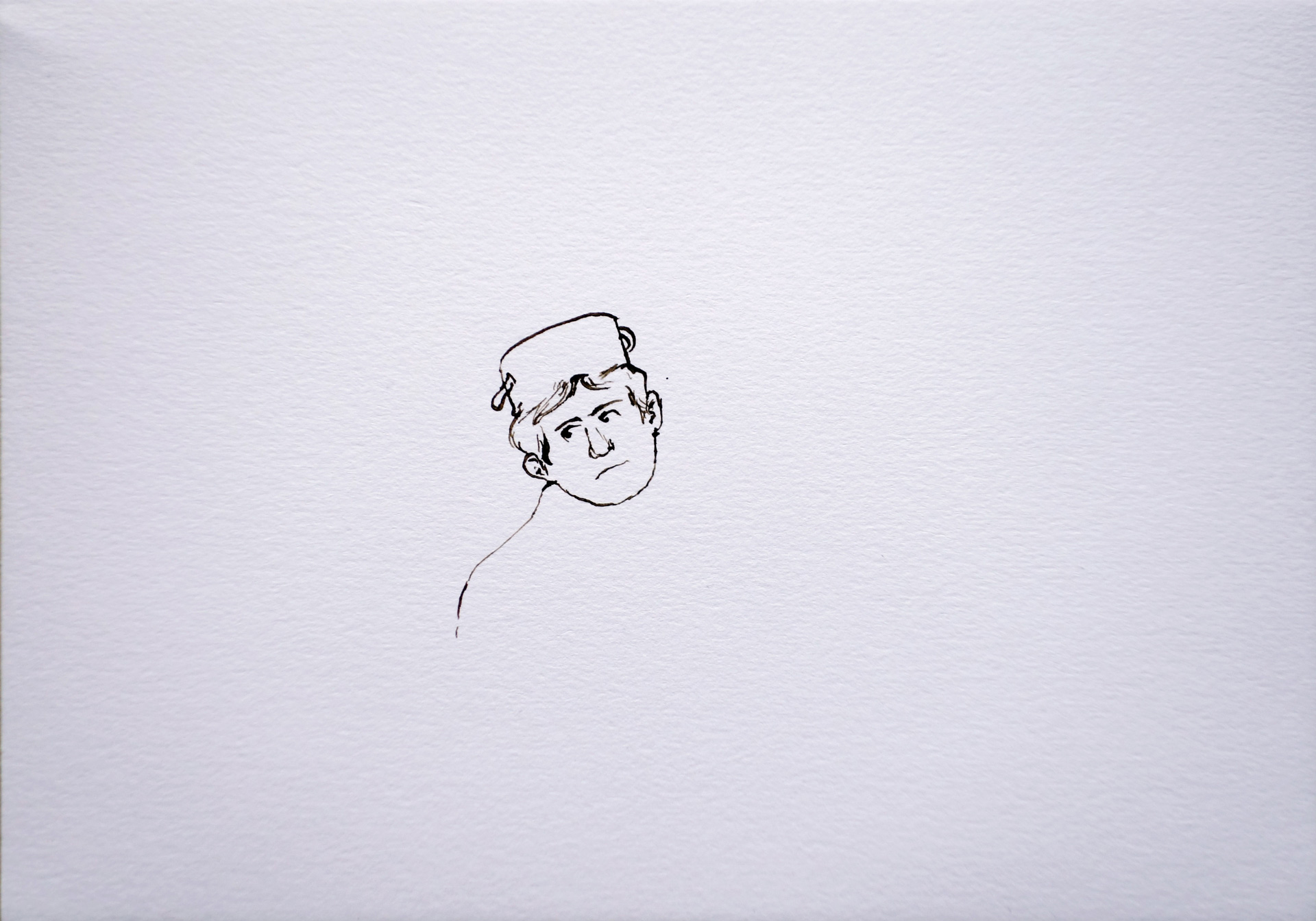 Self-portrait as a Dandy, 2012
sepia ink and pen on paper
Self-portrait as a Dandy, 2012
sepia ink and pen on paper
15 x 21 cm (unframed) -
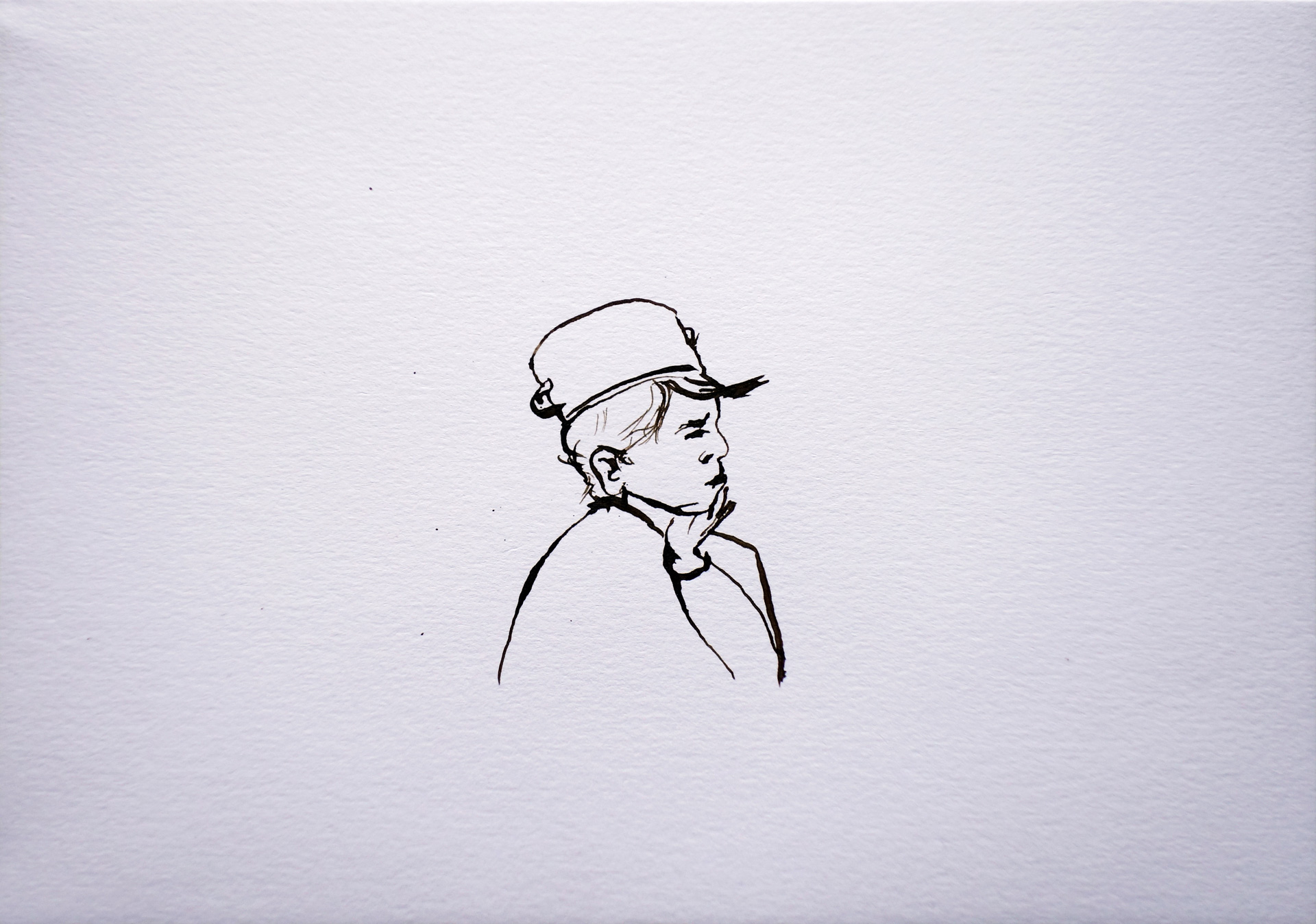 Self-portrait as a Dandy, 2012
sepia ink and pen on paper
Self-portrait as a Dandy, 2012
sepia ink and pen on paper
15 x 21 cm (unframed) -
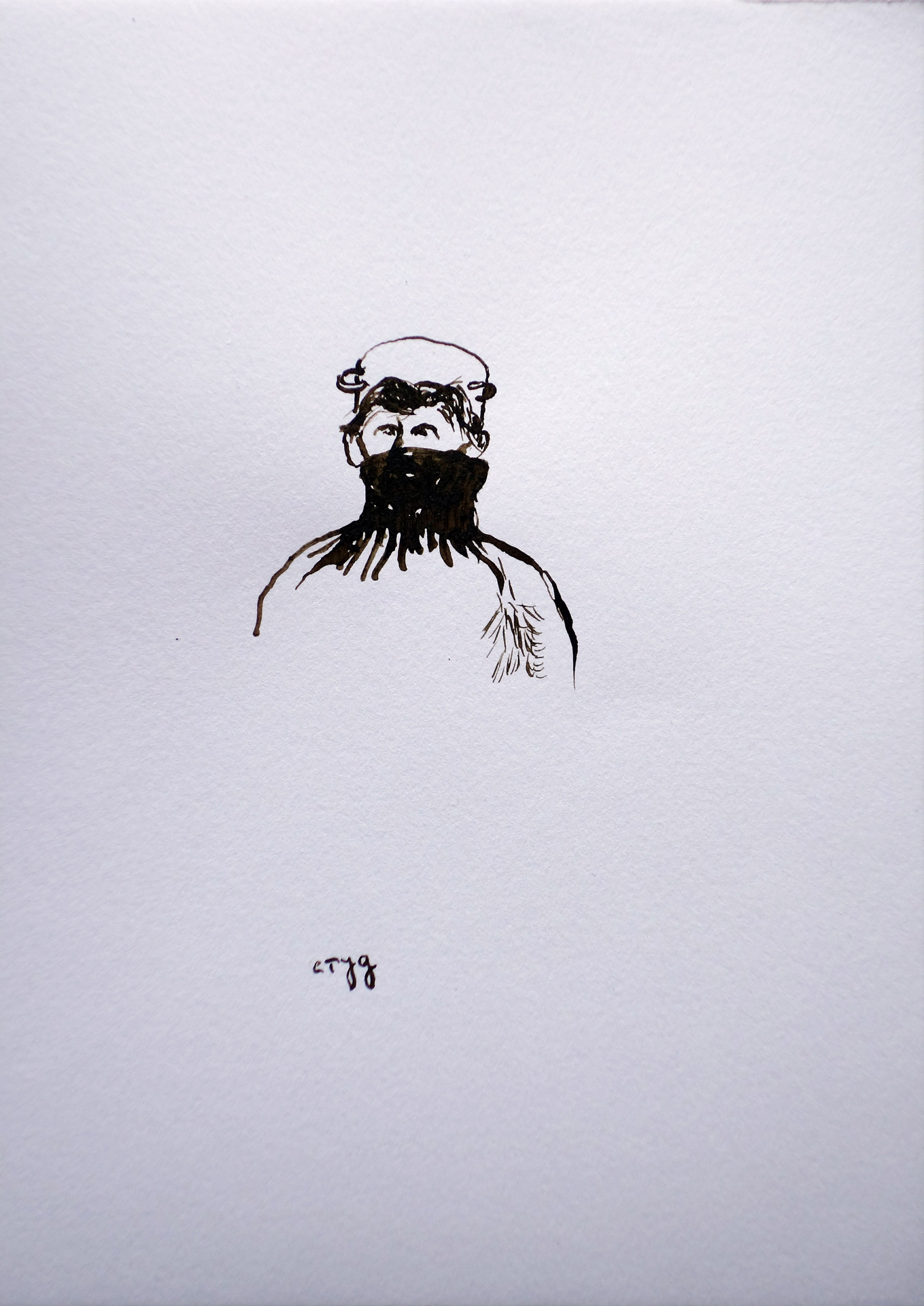 Self-portrait as a Dandy, 2012
sepia ink and pen on paper
Self-portrait as a Dandy, 2012
sepia ink and pen on paper
21 x 15 cm (unframed) -
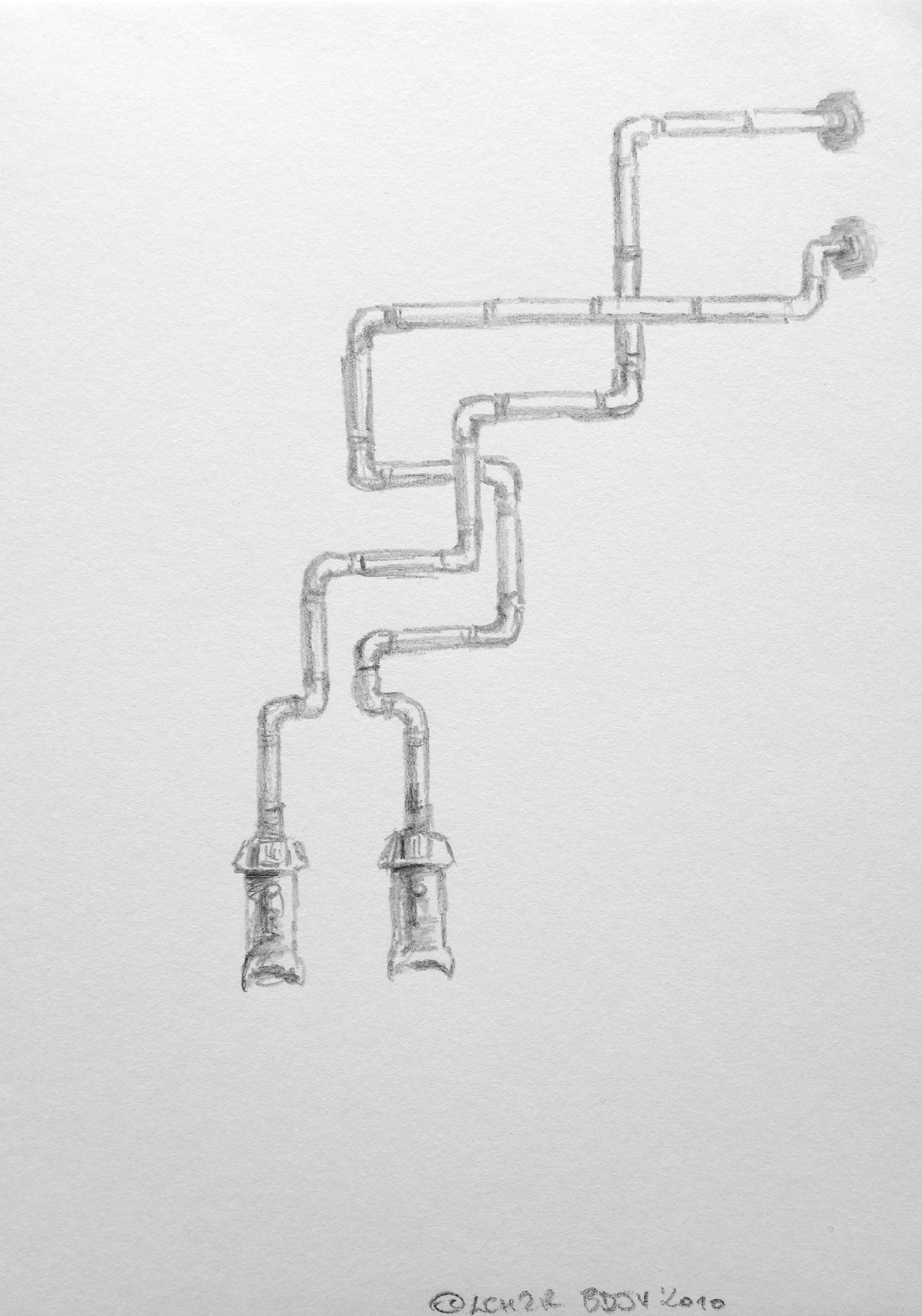 Local warming 10, 2010
drawing
Local warming 10, 2010
drawing
pencil on paper
21 x 15 cm -
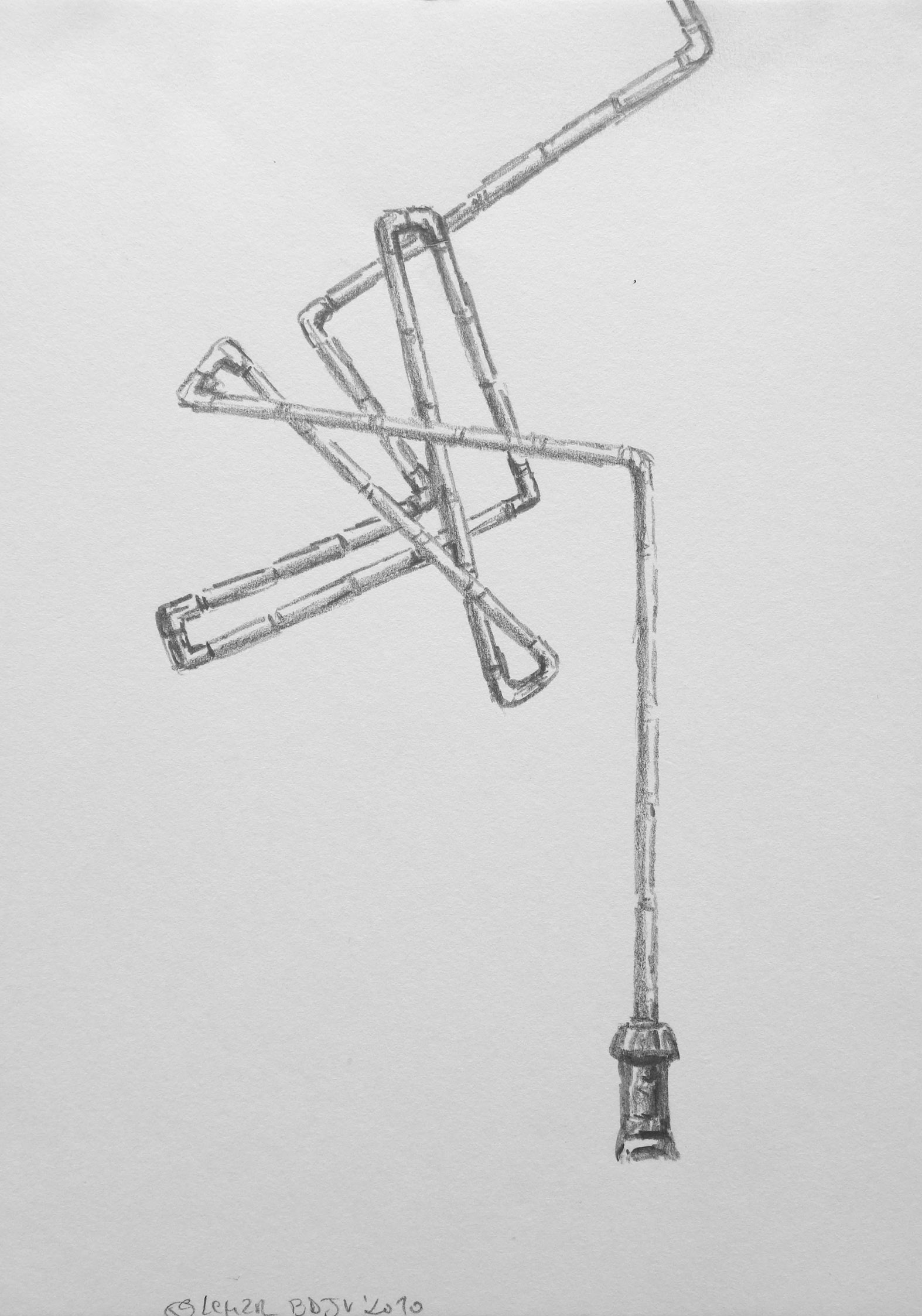 Local warming 2, 2010
drawing
Local warming 2, 2010
drawing
pencil on paper
21 x 15 cm -
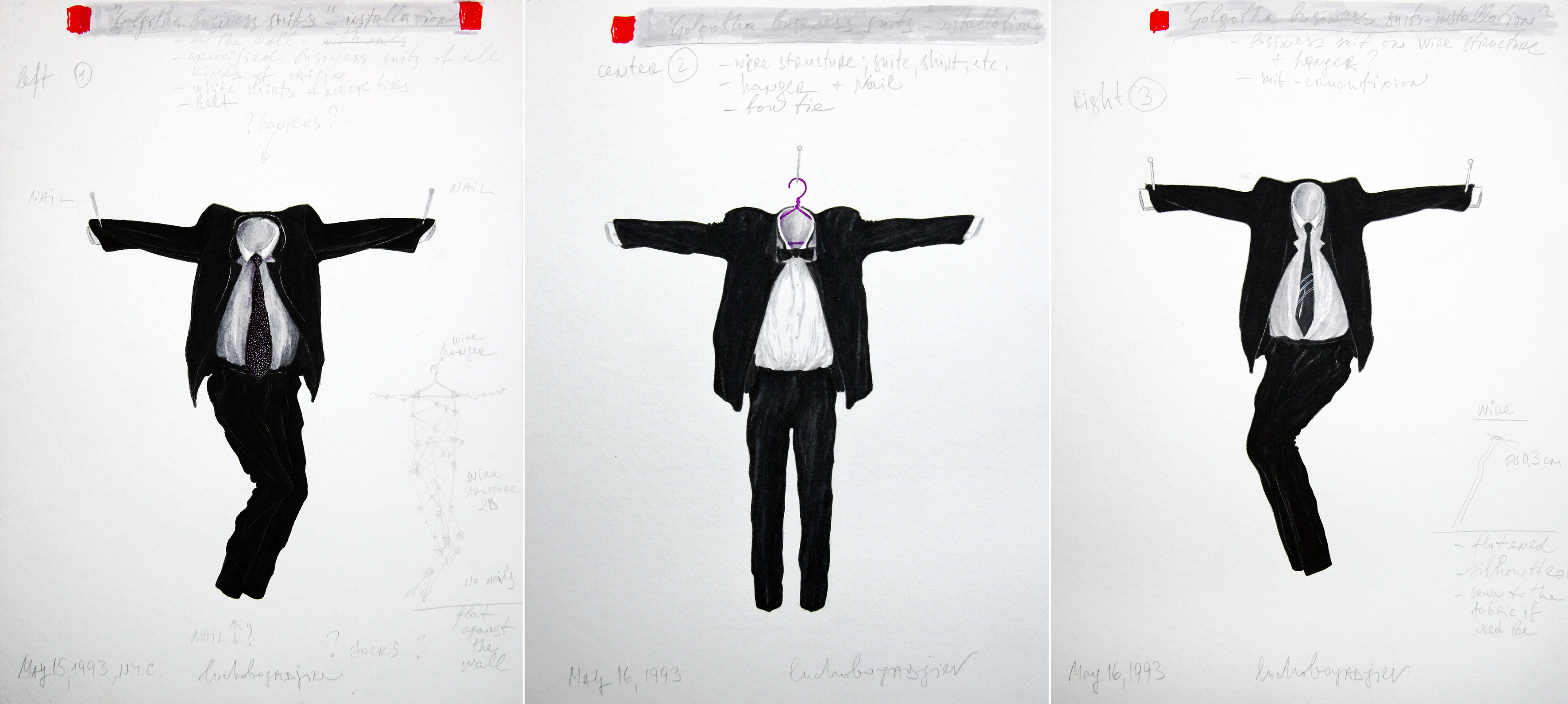 Neo-Golgotha. The Drawings, 1993
3 drawings
Neo-Golgotha. The Drawings, 1993
3 drawings
watercolor marker and pencil on paper
each one 49 x 38.5 cm
(38 x 28 cm, unframed) -
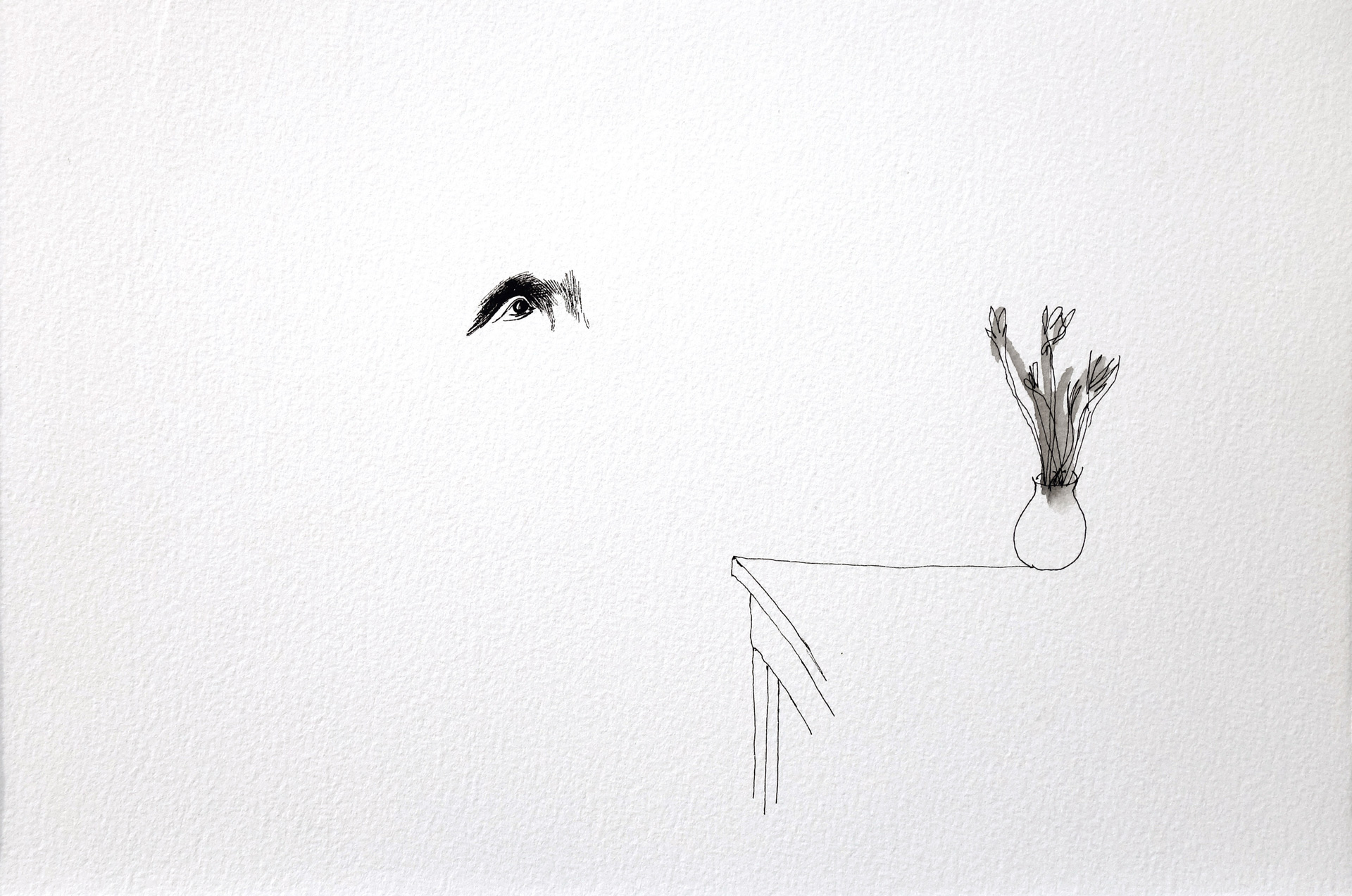 Drawing from 17.03. 2013
Rottring Isograph, brush,
Drawing from 17.03. 2013
Rottring Isograph, brush,
ink and watercolor on paper
19.2 x 28 cm -
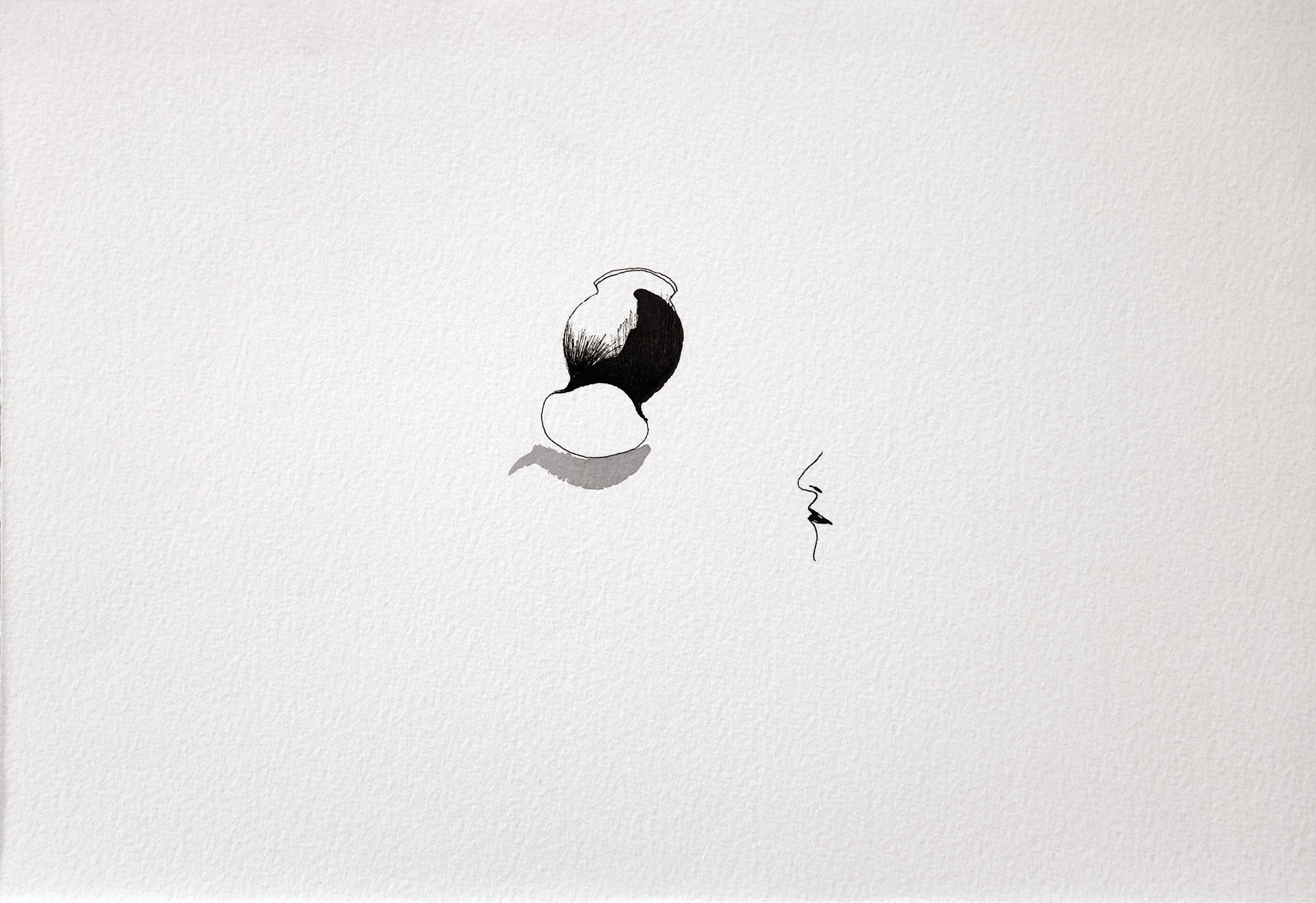 Drawing from 17.03. 2013
Rottring Isograph, brush,
Drawing from 17.03. 2013
Rottring Isograph, brush,
ink and watercolor on paper
19.2 x 28 cm -
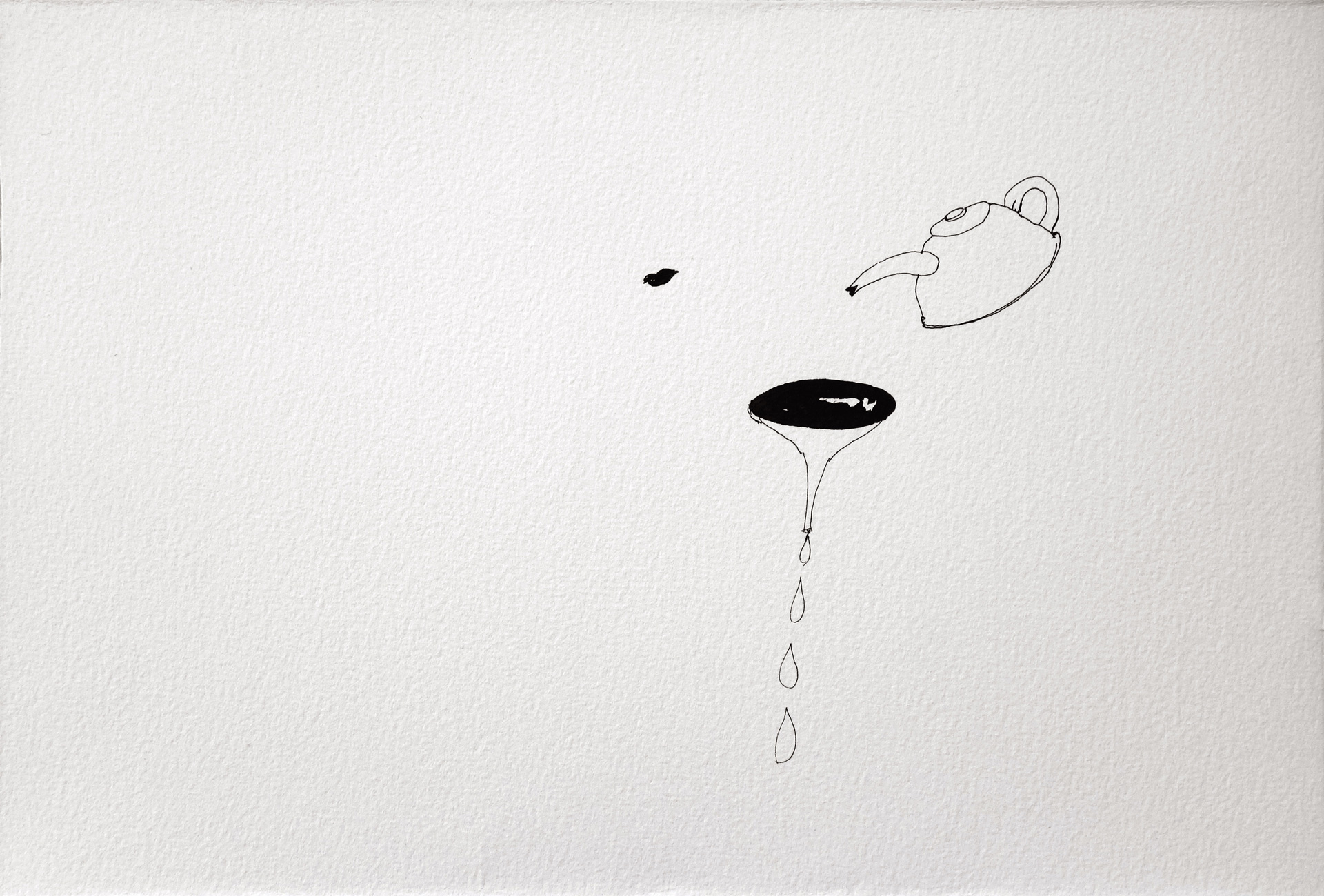 Drawing from 17.03. 2013
Rottring Isograph, brush,
Drawing from 17.03. 2013
Rottring Isograph, brush,
ink and watercolor on paper
19.2 x 28 cm -
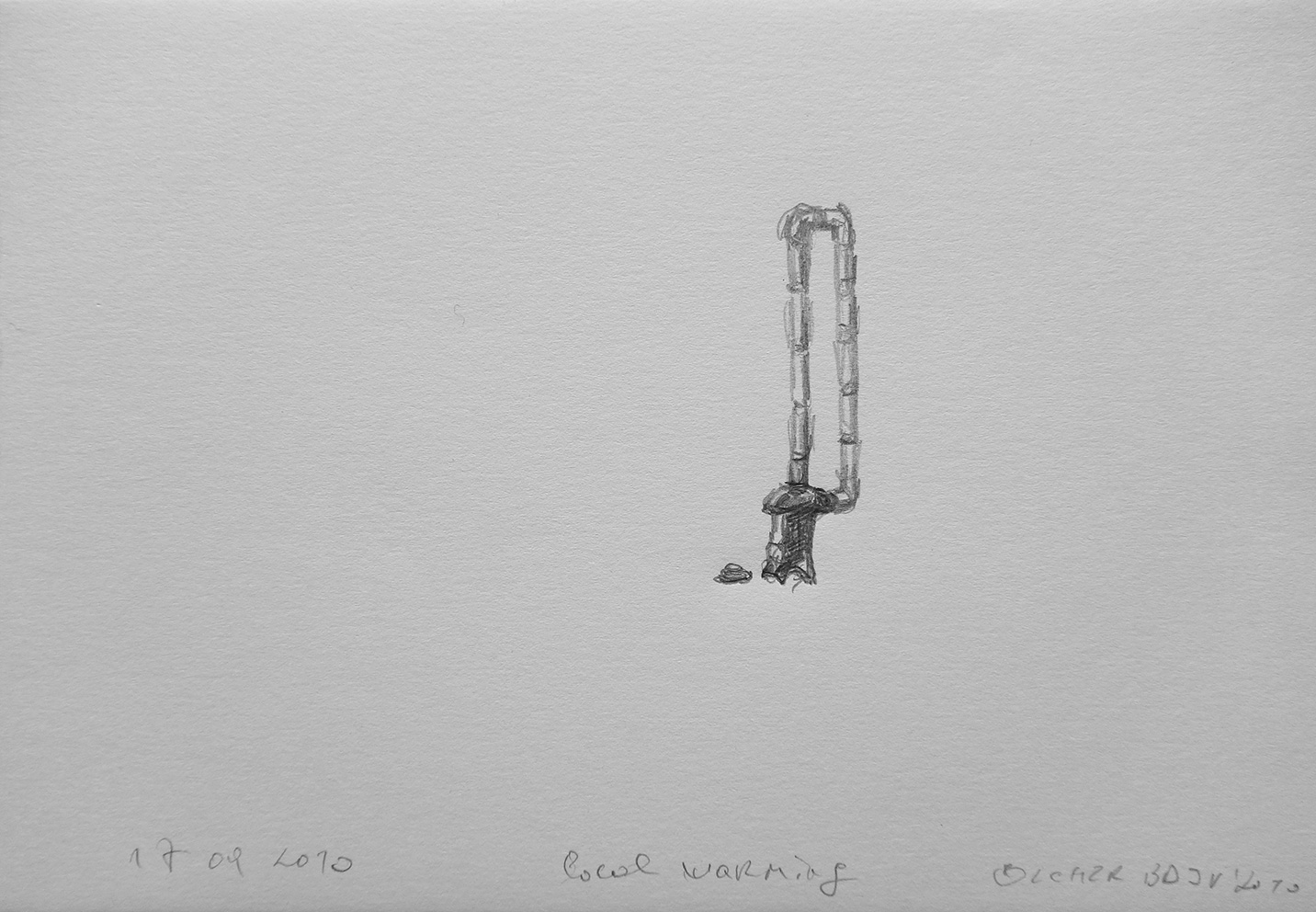 Local warming, 2010
drawing
Local warming, 2010
drawing
pencil on paper
15 x 21 cm -
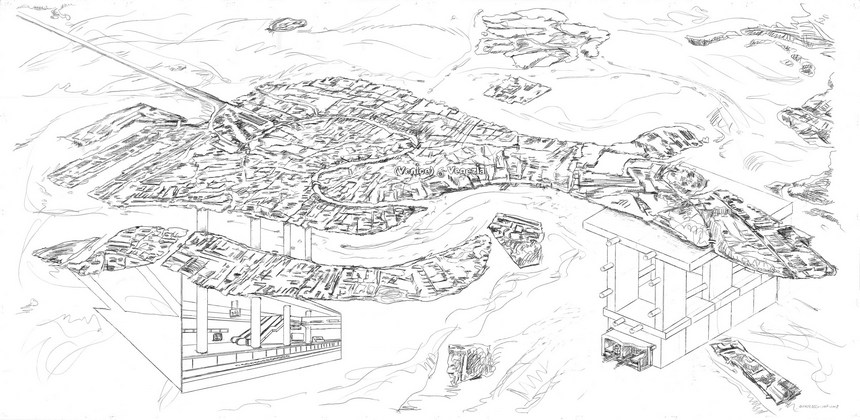 Venice needs an underground (a metro)!, 2007-2018
drawing
Venice needs an underground (a metro)!, 2007-2018
drawing
pencil on paper
101 x 203 cm (framed) -
 Kassel needs an airport!, 2007-2018
drawing
Kassel needs an airport!, 2007-2018
drawing
pencil on paper
101 x 203 cm (framed) -
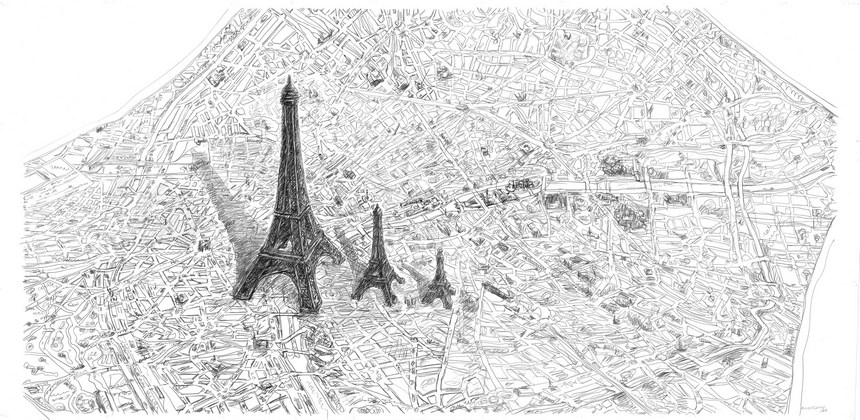 Paris needs to reboot!, 2004-2018
drawing
Paris needs to reboot!, 2004-2018
drawing
pencil on paper
101 x 203 cm (framed) -
 Jerusalem needs to hover!, 2008-2018
drawing
Jerusalem needs to hover!, 2008-2018
drawing
pencil on paper
101 x 203 cm (framed)
Collage
-
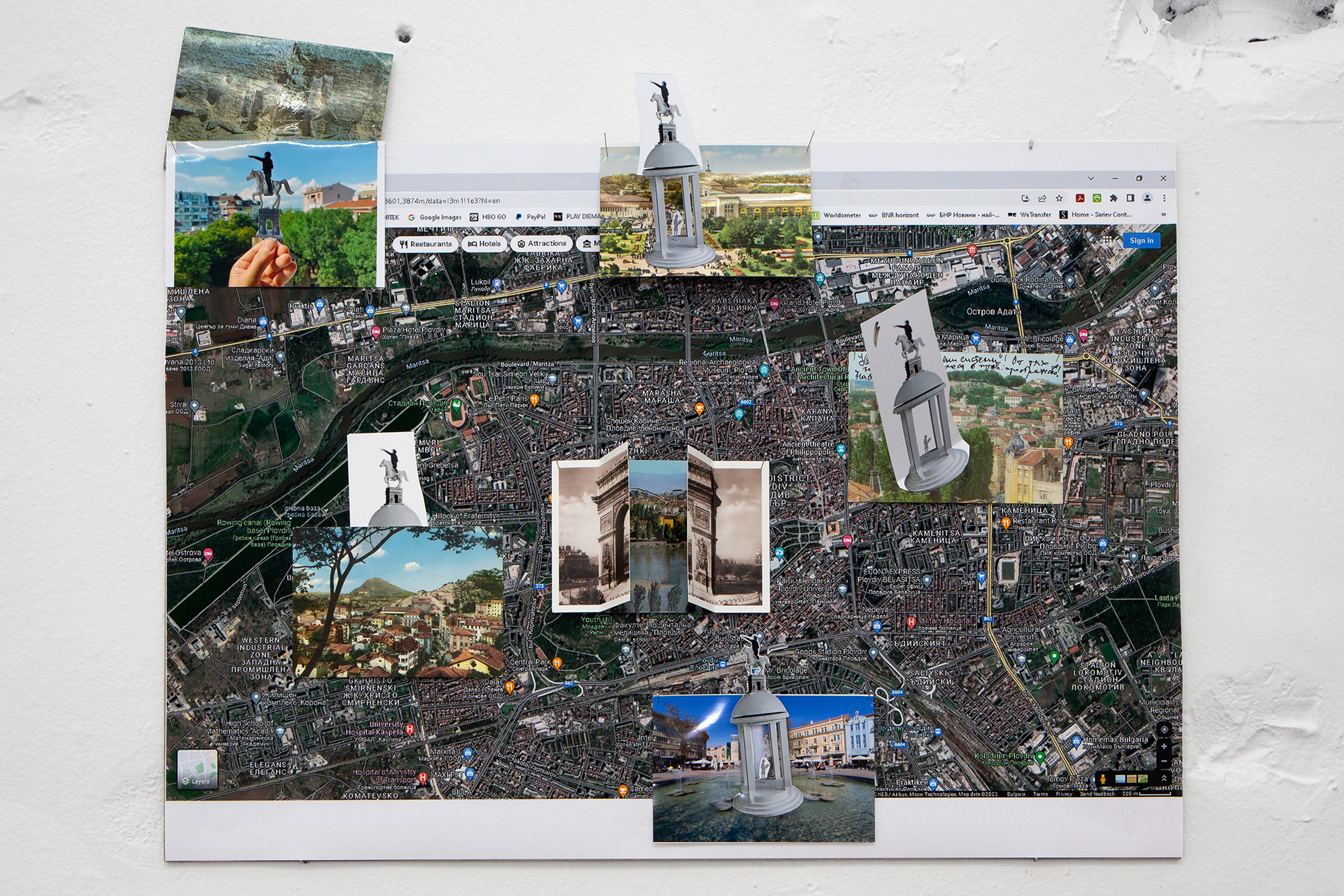 Memories from the Future/Places of Wisdom – a study for the monument’s location, 2022
Collage, paper, postcards, photographs, map of Plovdiv
Memories from the Future/Places of Wisdom – a study for the monument’s location, 2022
Collage, paper, postcards, photographs, map of Plovdiv
-
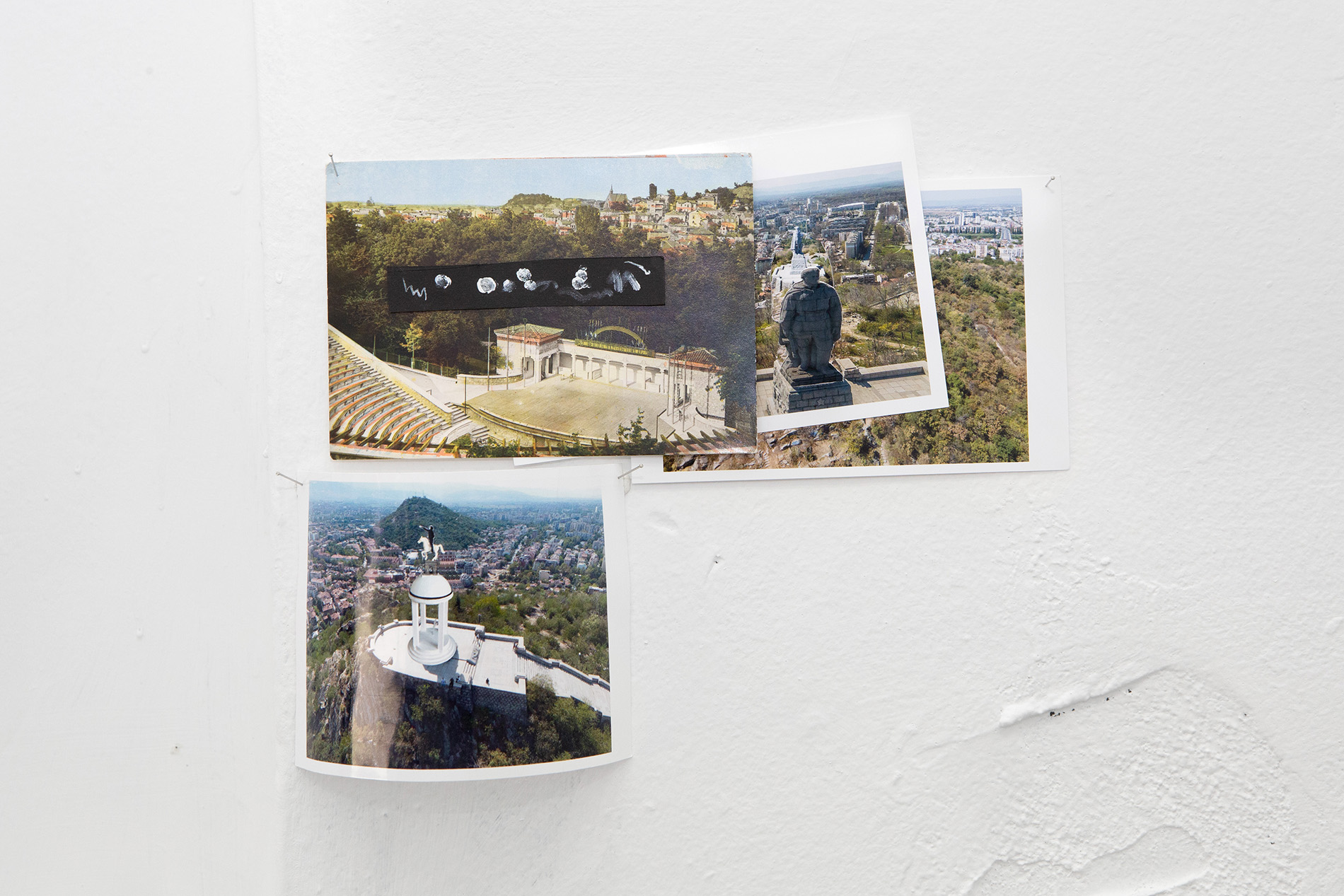 Fight for Stage, 2022
Collage, paper, postcards, photographs
Fight for Stage, 2022
Collage, paper, postcards, photographs
-
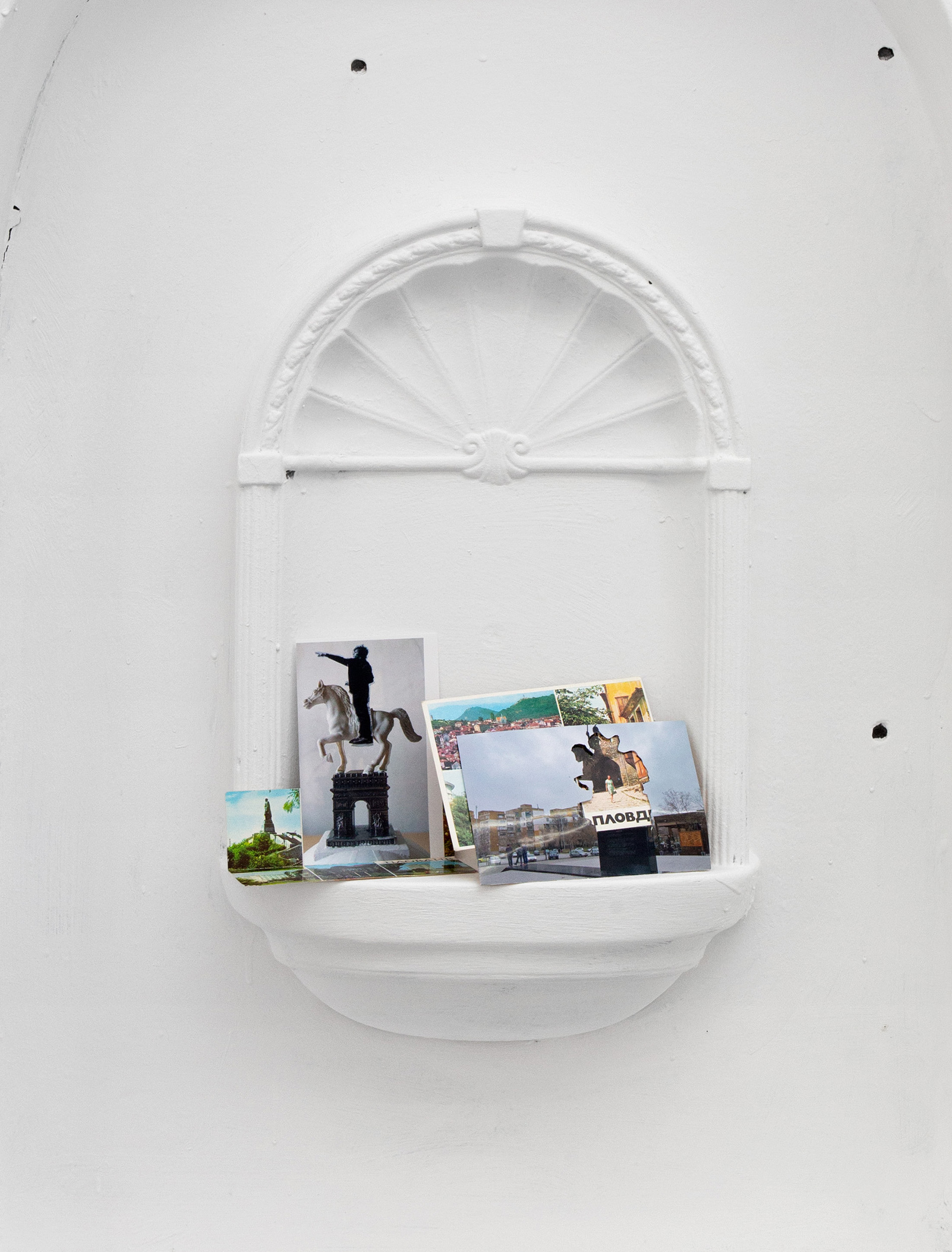 The Future in Postcards, 2022
Collage, paper, postcards, photographs
The Future in Postcards, 2022
Collage, paper, postcards, photographs
-
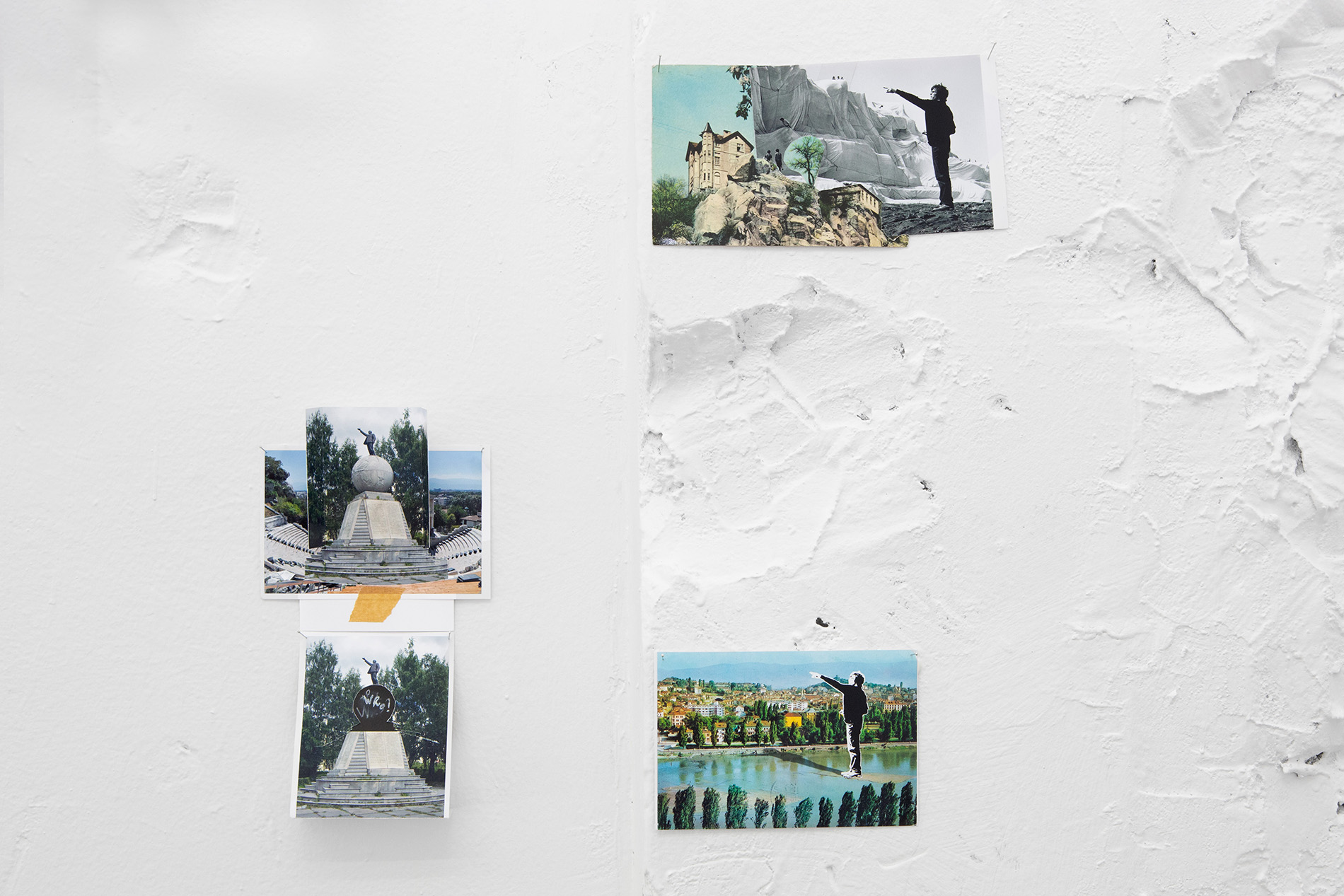 Powerful Gestures Make Strong Monuments in Public Space – From Nizhny Tagil, via Sidney, to Plovdiv
Collage, paper, postcards, photographs
Powerful Gestures Make Strong Monuments in Public Space – From Nizhny Tagil, via Sidney, to Plovdiv
Collage, paper, postcards, photographs
-
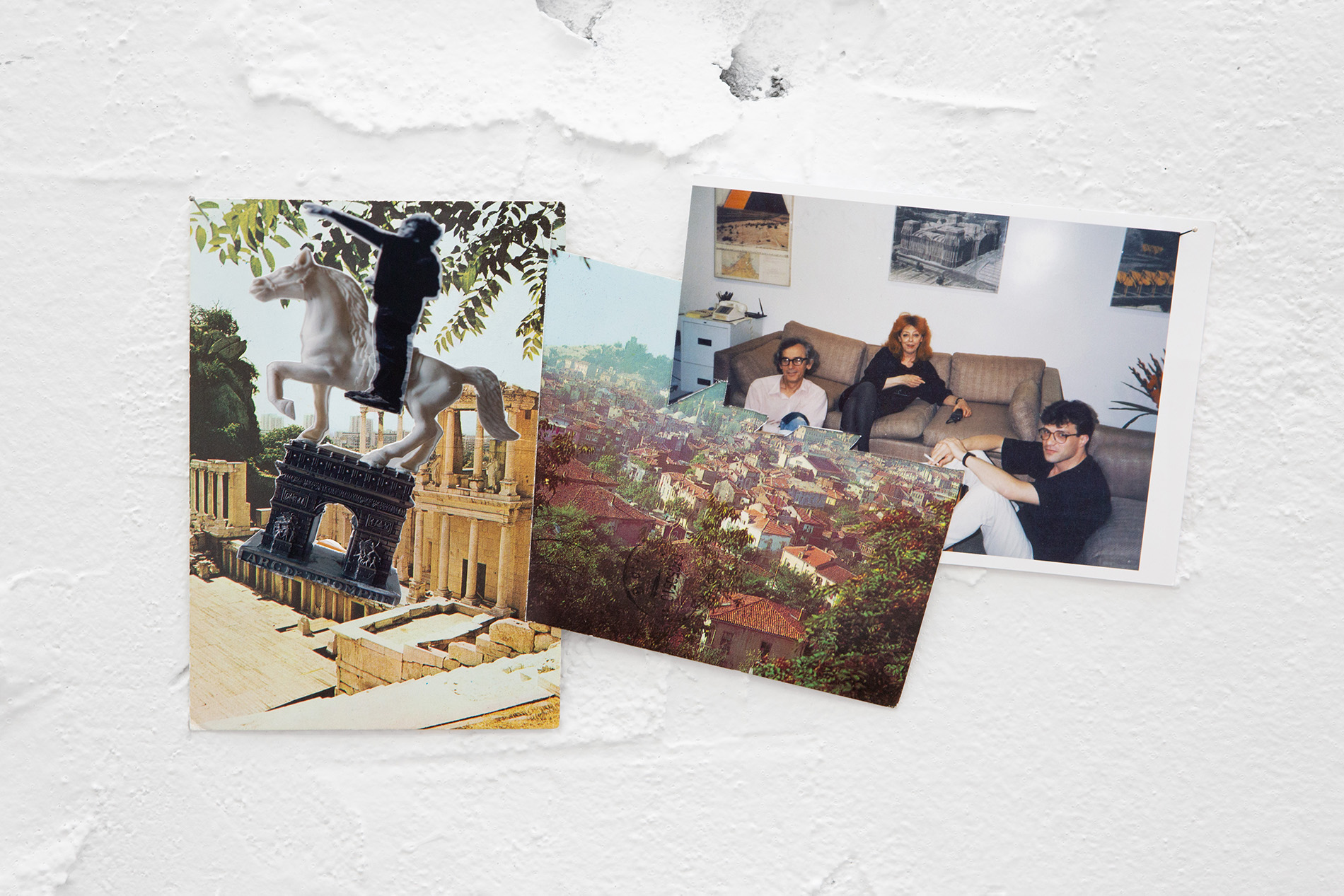 There is no Wall between the Private and the Public (from 1993 to 2022), 2022
Collage, paper, postcards, photographs
There is no Wall between the Private and the Public (from 1993 to 2022), 2022
Collage, paper, postcards, photographs
-
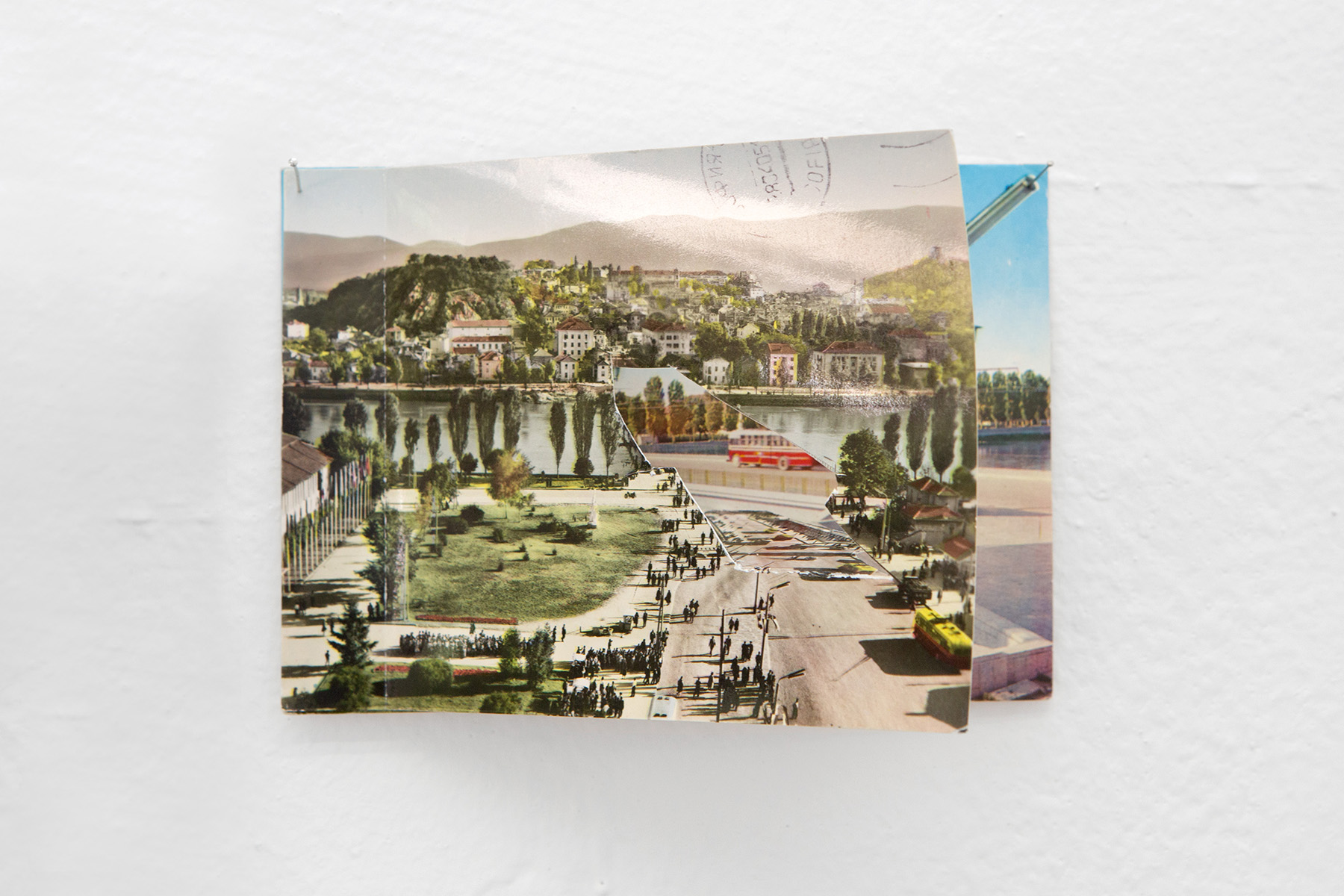 The History Comes to Us in Layers, as a Wrapping (remembering Pont Neuf in Paris), 2022
Collage, paper, postcards, photographs
The History Comes to Us in Layers, as a Wrapping (remembering Pont Neuf in Paris), 2022
Collage, paper, postcards, photographs
Photography
-
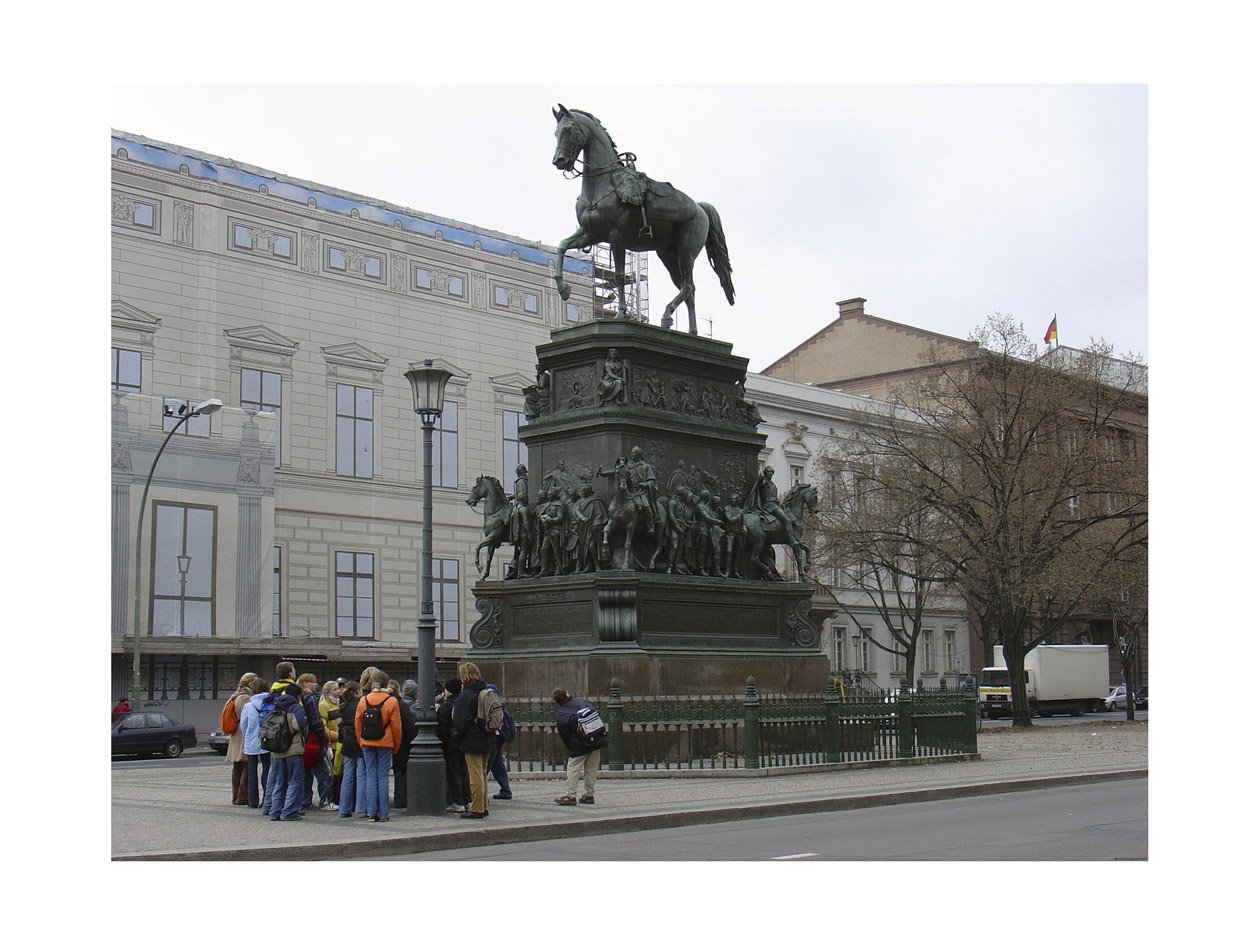 On vacation…, 2004 – in progress
Part of a cycle of app. 80 digital prints on paper,
On vacation…, 2004 – in progress
Part of a cycle of app. 80 digital prints on paper,
each one 80 x 60 or 60 x 80 cm,
edition 3+2AP -
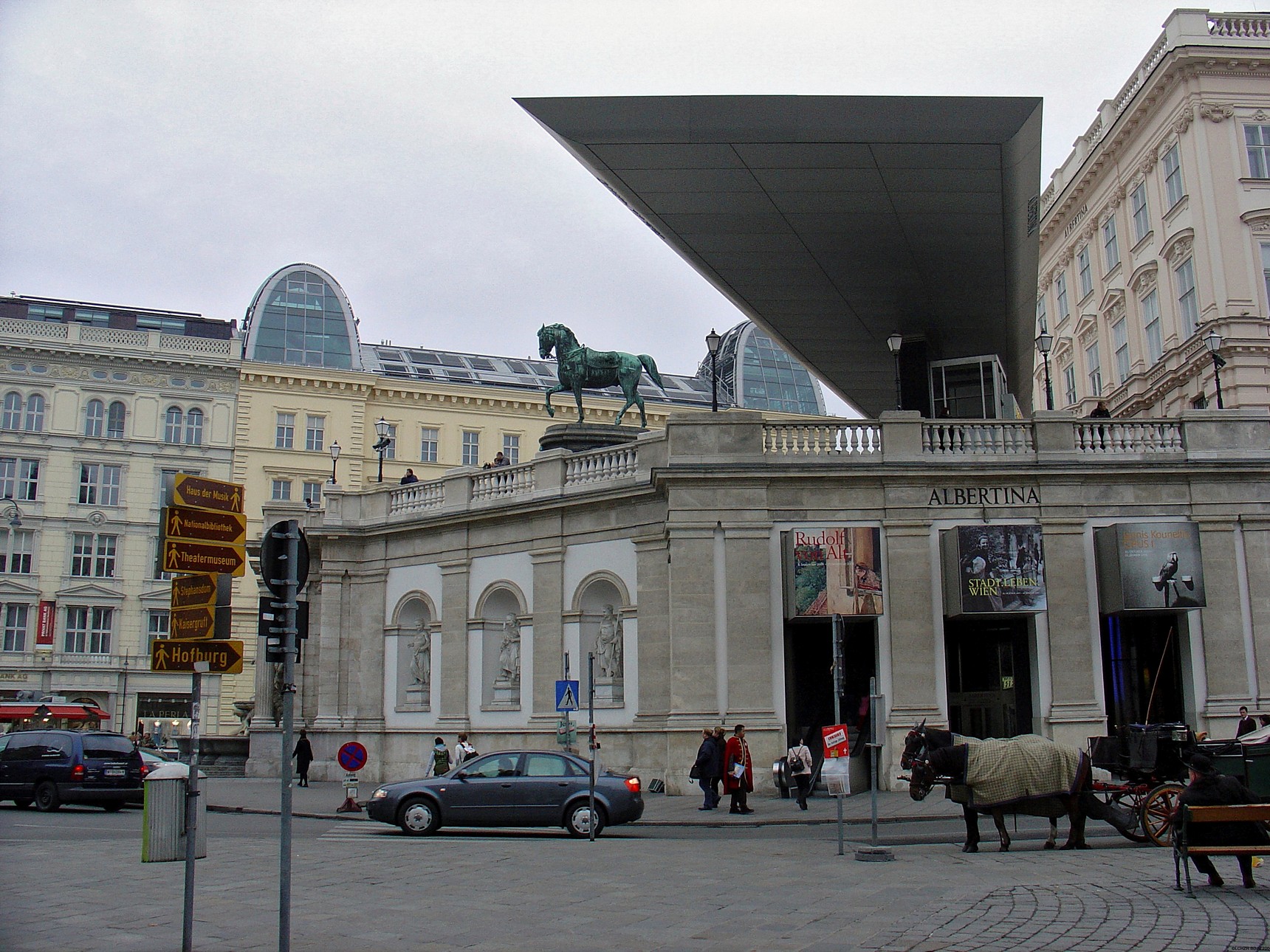 On Vacation: Erzherzog Albrecht from Vienna, 2006
Digital print on 300 g Paul Calle Fine Art paper
On Vacation: Erzherzog Albrecht from Vienna, 2006
Digital print on 300 g Paul Calle Fine Art paper
60 x 80 cm
Part of: On Vacation…, 2004 / in progress
On-going cycle of digital prints
each one 60 x 80 or 80 x 60 cm More information on the cycle here -
 How many nails in a mouth? Self-portrait with 2 kg of 12.5 cm long nails in the mouth, 1992-1995
Homage to Günther Uecker Passport photographs in a block of 4
How many nails in a mouth? Self-portrait with 2 kg of 12.5 cm long nails in the mouth, 1992-1995
Homage to Günther Uecker Passport photographs in a block of 4
13 x 9 cm
Edition 3/1 AP
Courtesy SARIEV Contemporary Based on the idea that a truer self-portrait is made if the artist finds the Other in the Self, this image represents and attempt at self-exploration. The “How many nails in a mouth?” work started as a pencil-on-paper drawing expressing inner turmoil and anguish related to a deep family crisis. The initial drawing was made in the summer of 1992 on the terrace in front of the Albertina Museum in Vienna. Later on it evolved into a photographic work subtitled “Homage to Günther Uecker” – as a part of a cycle of homage(s) first shown at “Orient/ation”, the 4th Istanbul Biennial, curated by René Block in 1995. The photographic image was made in a passport photo booth in the center of Sofia in October 1995. The “model” could hold the bunch of nails in his mouth for less than 2 sec due to the very heavy strain on the lower jaw muscles. There were 2 versions/negatives made – a straight up frontal face image and a ¾ side view as in a passport photograph, seen here. -
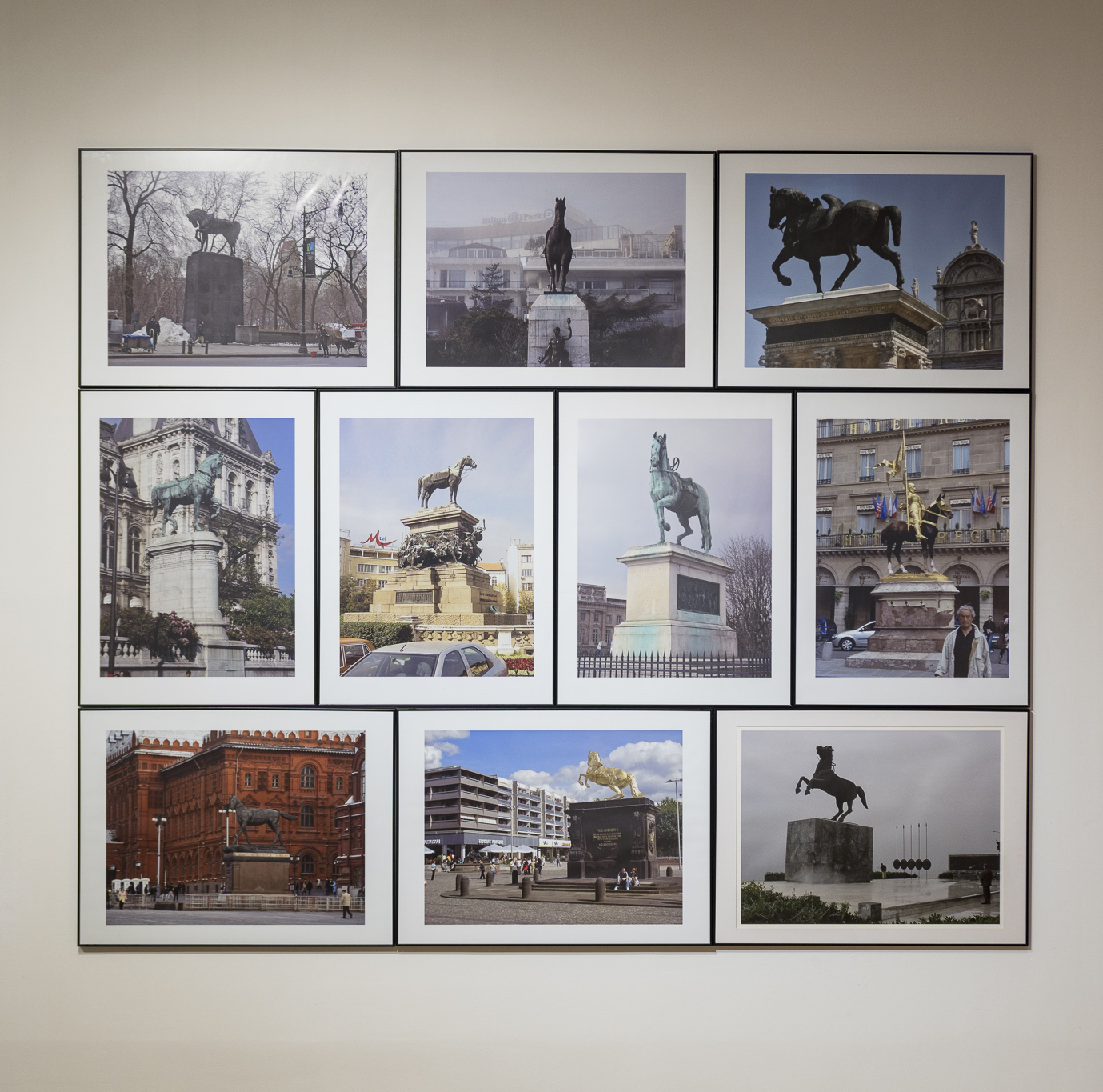 On vacation…, 2004 – in progress
part of a cycle of app. 80 digital prints on paper
On vacation…, 2004 – in progress
part of a cycle of app. 80 digital prints on paper
each one 80 x 60 or 60 x 80 cm
edition 3+2AP From left to right and from top to bottom On Vacation are: Simon Bolivar from New York; General İnönü from Istanbul; Bartolomeo Colleoni from Venice; Étienne Marcel from Paris; Alexander II from Sofia; Henri IV from Paris; Jeanne d'Arc from Paris; Marshall Zhukov from Moscow; Augustus II the Strong from Dresden; Alexander the Great from Thessaloniki. The work is based on a simple gesture of digitally removing (and thus symbolically sending on vacation) the human figures from the photographic images of an endless number of public monuments from cities all over the world. It implies a personal involvement with globalization… By erasing the, predominantly male, figure of a political leader, historical character, military commander, or a royal subject, etc. the proposed idea is to liberate public space from political tensions even for a short while and in the context of a work of visual art. View prints in detail here -
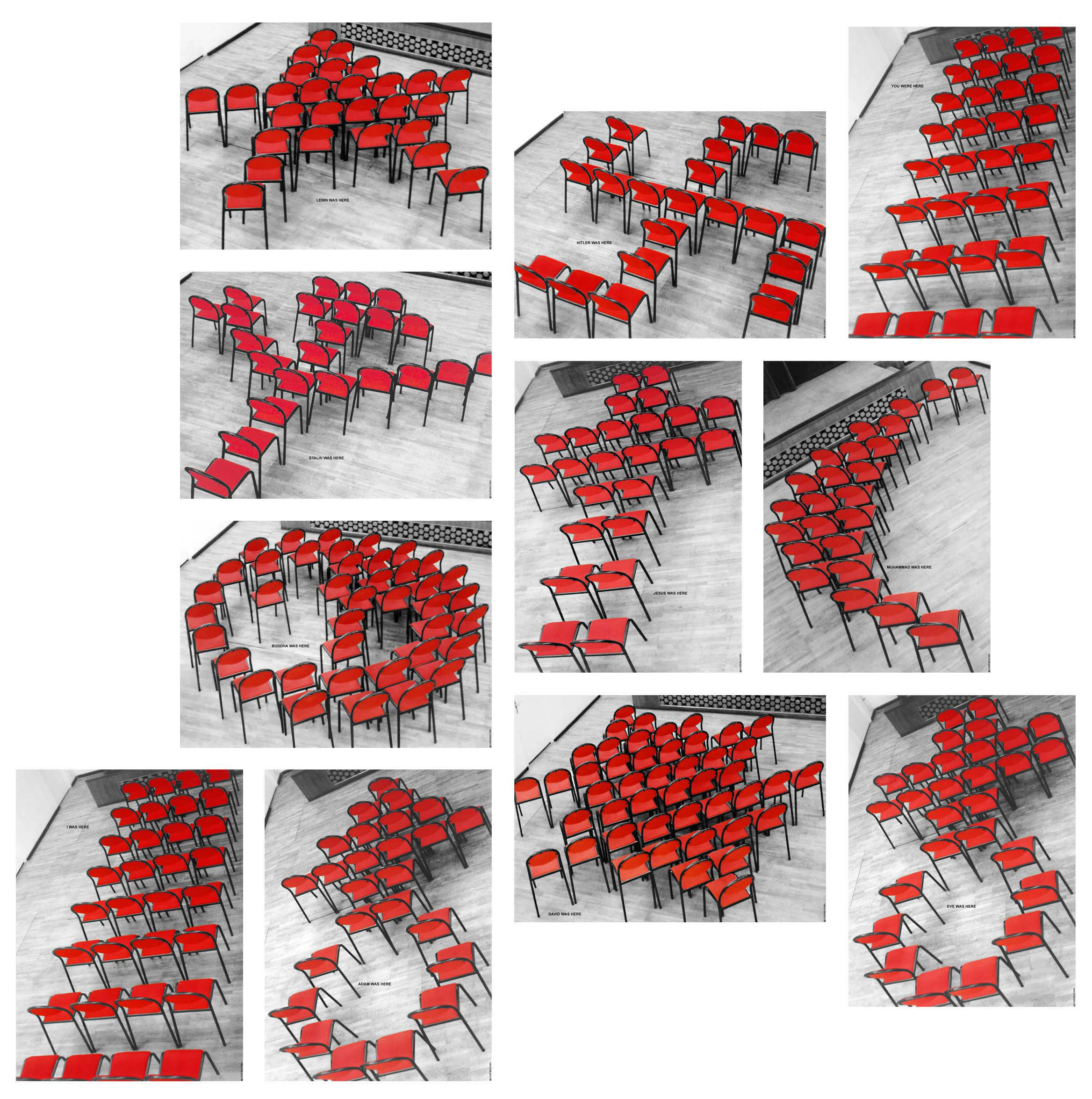 Chairs and Symbols. A project for peaceful co-identification, 1995-2001
cycle of 11 digital prints on paper
Chairs and Symbols. A project for peaceful co-identification, 1995-2001
cycle of 11 digital prints on paper
each one 56.5 х 78 or 78 х 56.5 cm
edition 2+2AP The work references the notion of peaceful co-existence from the time of the Cold War. However, here the idea is to have a peaceful co-identification – we are all responsible for what happens on the world as we are all here and now together, like it or not; instead of “stepping into somebody else’s shoes the work urges identification-by-sitting into somebody else’s symbol. The symbols that divide people – from the male-female duo, to the religious and totalitarian symbols might also serve as a reminder that we are or have been or will be in this world together, for good and bad. All prints can be viewed here -
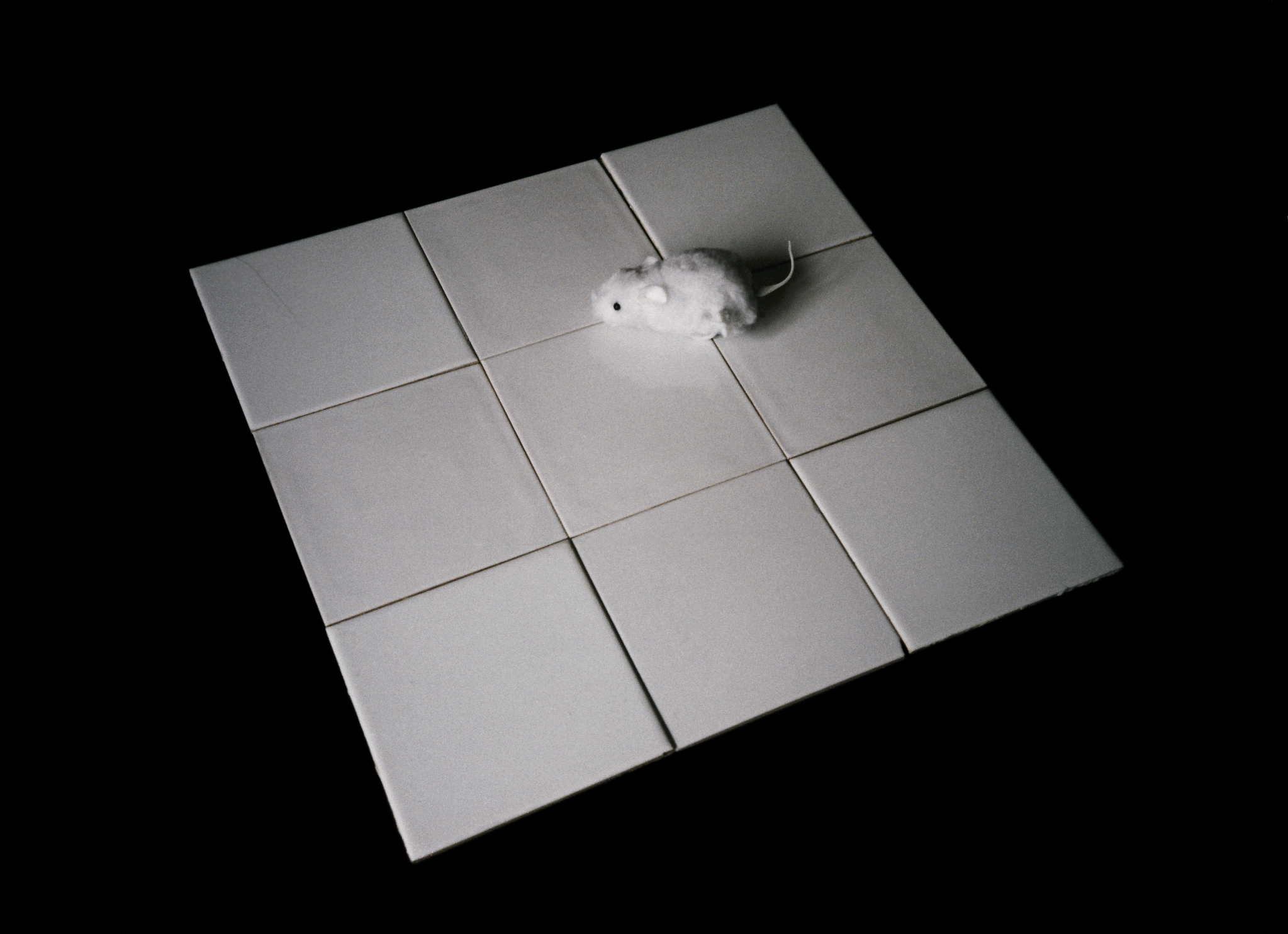 White mouse on white background (Homage to Kasimir Malevich), 1995
Color photograph
White mouse on white background (Homage to Kasimir Malevich), 1995
Color photograph
12.6 x 17.5 cm
edition 20/5 AP Playing with the notion of modernism and the early avant-garde as an experimental and alternative way of “making art”, the work references the white, tiled laboratory and the test animals there. The references go on with Malevich use of White Square on white background, the cross and the square as preferred forms of Suprematism. The “Homage to Kasimir Malevich” was first shown at “Orient/ation”, the 4th Istanbul Biennial curated by René Block in 1995. -
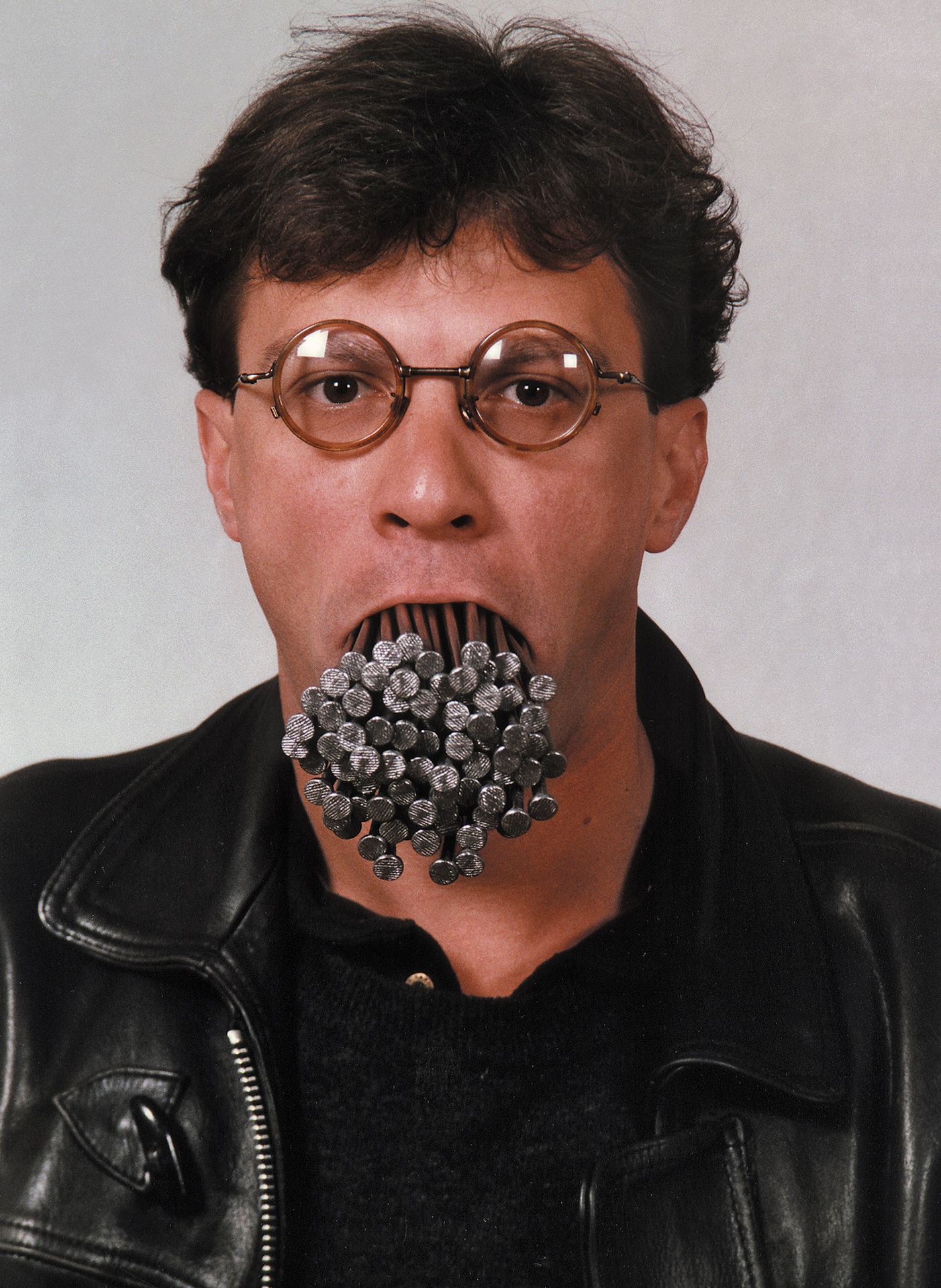 How many nails in the mouth? Self-portrait with 2 kg 12.5 cm long nails in the mouth, 1992-1995
digital print on paper
How many nails in the mouth? Self-portrait with 2 kg 12.5 cm long nails in the mouth, 1992-1995
digital print on paper
80 x 60 cm
edition 3+2AP The “How many nails in a mouth?” work started as an inner turmoil expressing pencil-on-paper drawing made on the terrace in front of the Albertina Museum in Vienna in summer of 1992. Later on it evolved into “Homage to Günther Uecker”, part of cycle of homage(s) first shown at “Orient/ation”, the 4th Istanbul Biennial curated by René Block in 1995. -
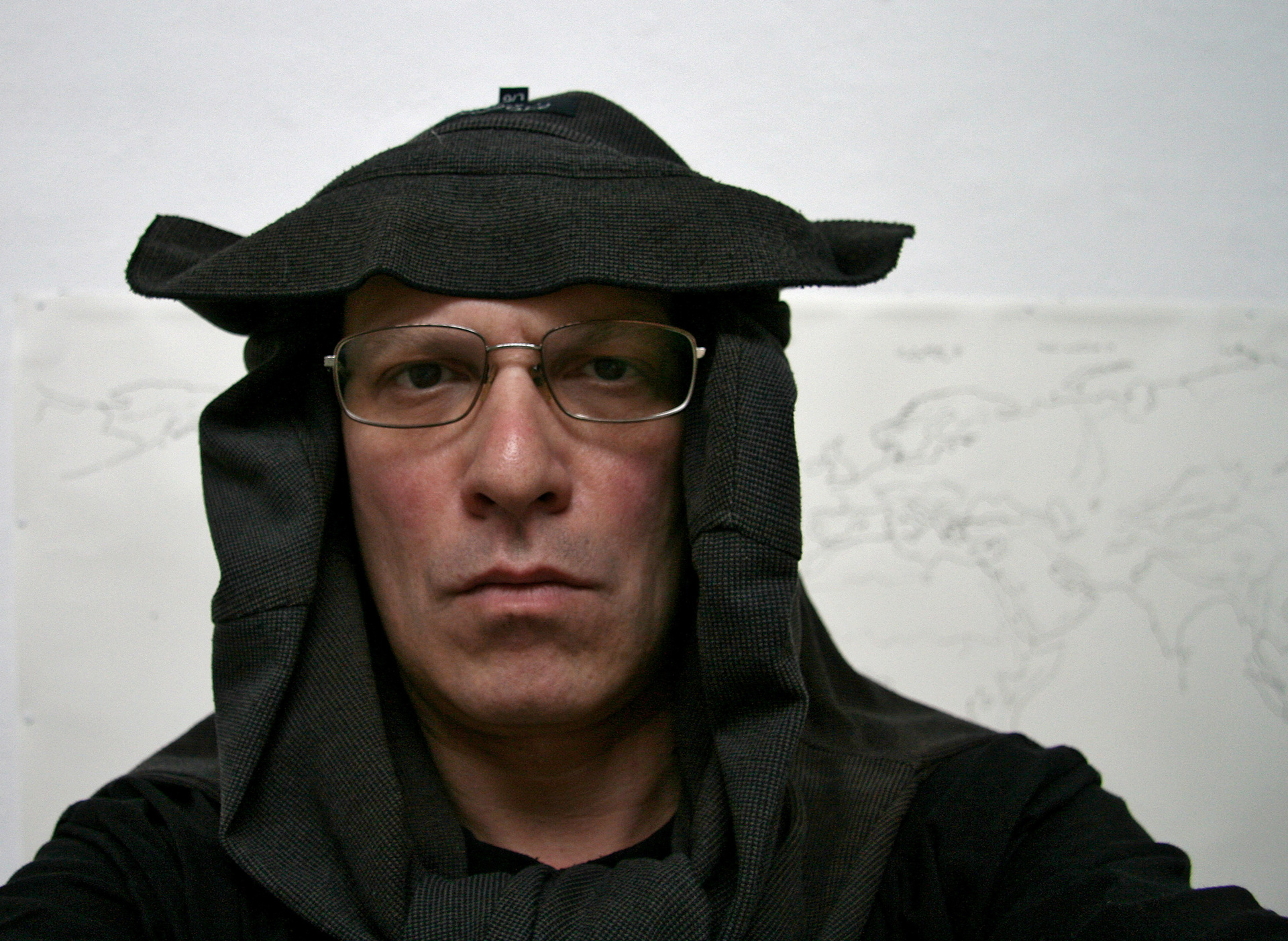 The Inquisition – get out! Self-portrait with a warm flannel over the head, 2007
digital print on paper
The Inquisition – get out! Self-portrait with a warm flannel over the head, 2007
digital print on paper
60 x 80 cm
edition 3+2AP -
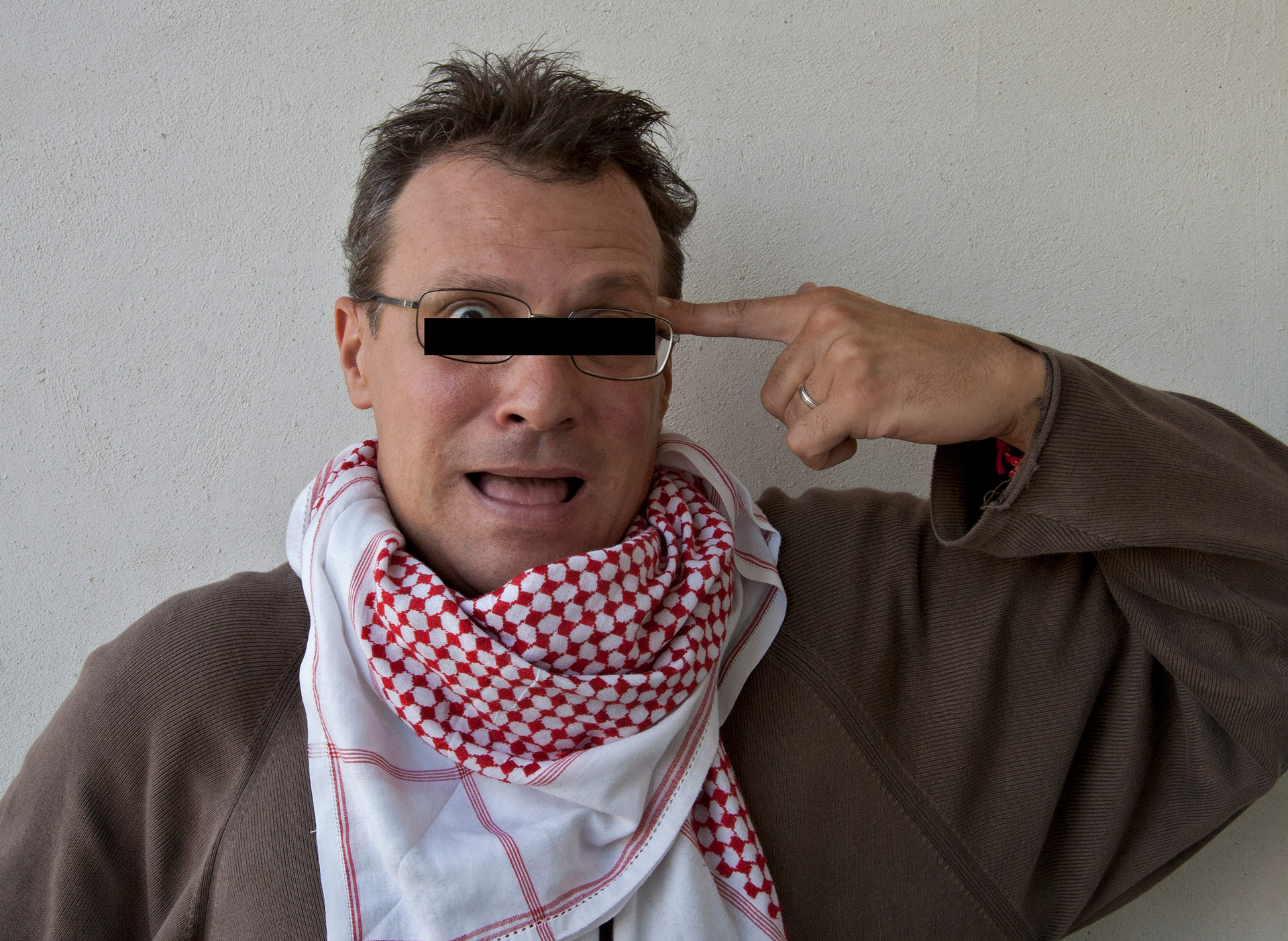 Shut up or you are next! Self-portrait with a black stripe across the eyes, 2007
digital print on paper
Shut up or you are next! Self-portrait with a black stripe across the eyes, 2007
digital print on paper
60 x 80 cm
edition 3+2AP -
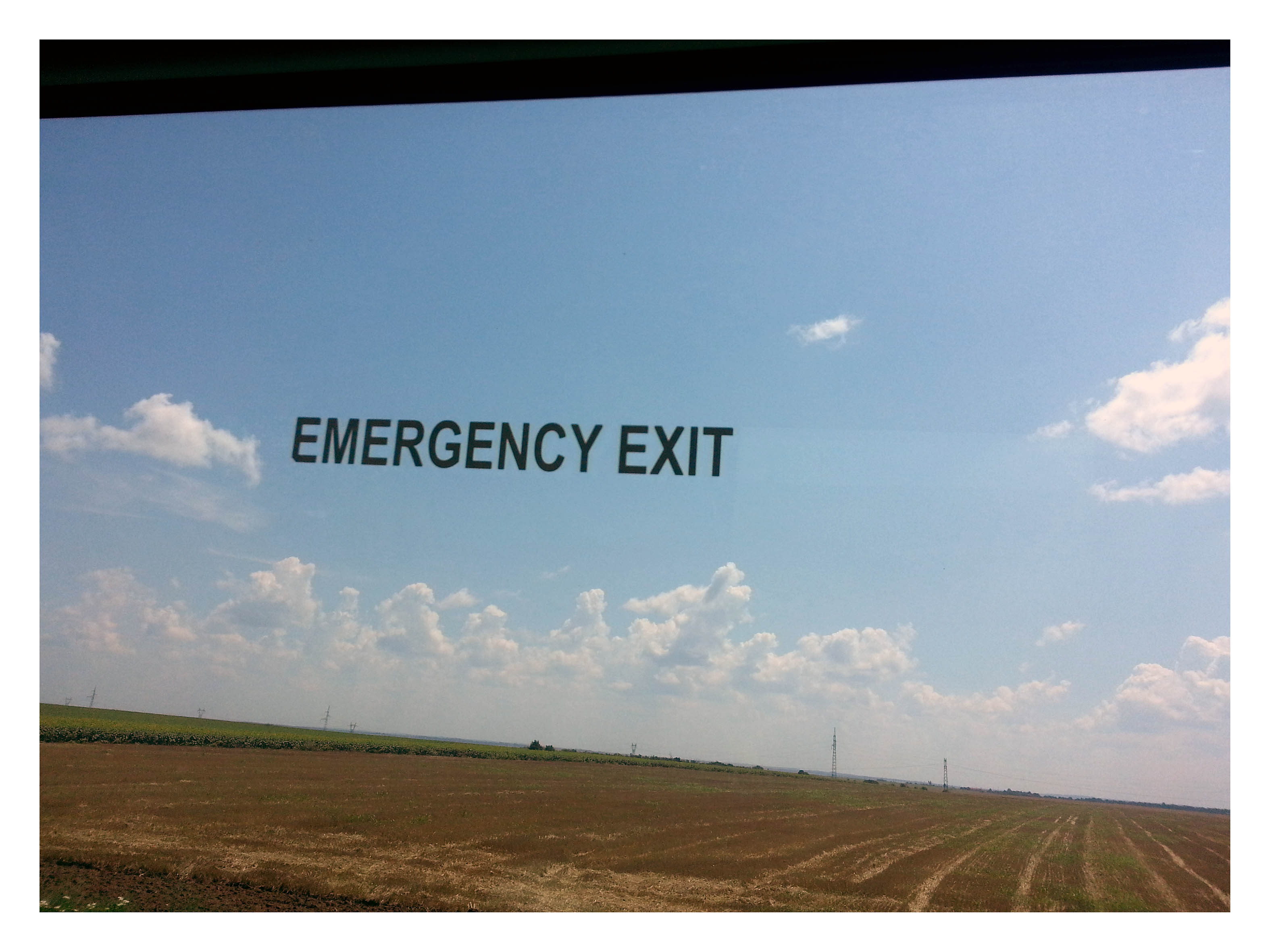 Emergency Exit, 2013
photograph
Emergency Exit, 2013
photograph
digital print on paper
60 x 80 cm
edition 5+2AP -
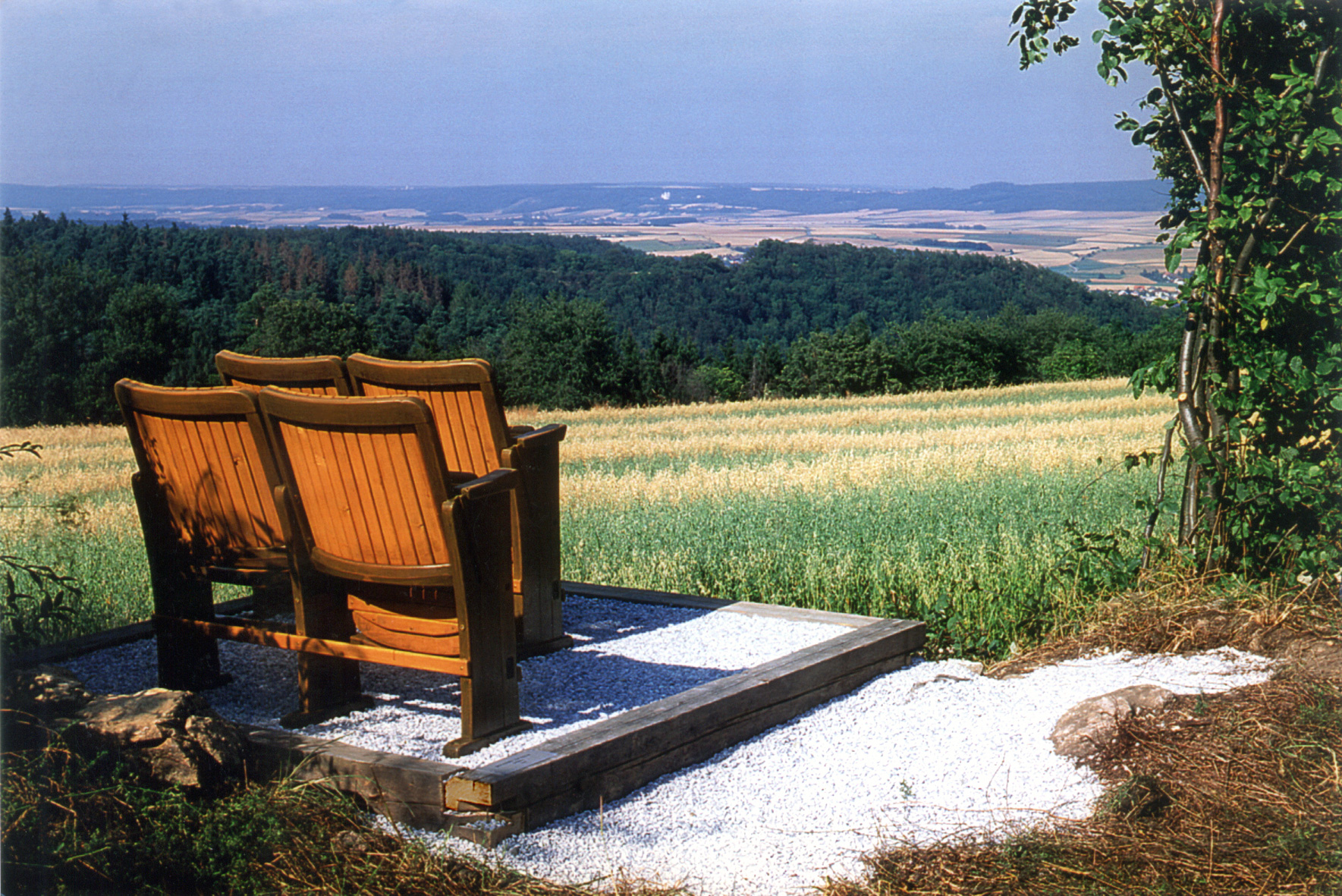 Gazebo, 1996 (2018)
author’s reconstruction of a site-specific work in Austria near Gars-am-Kamp
Gazebo, 1996 (2018)
author’s reconstruction of a site-specific work in Austria near Gars-am-Kamp
app. 80 km north-west of Vienna
photo-wallpaper on a wall
app. 330 x 550 cm and variable depending on size of wall
edition 3+2AP In the summer of 1996 I was invited to a sculpture symposium in nature. Not a sculptor, I tried to create a setting to enjoy the beauty of nature while seeing it as if in a cinema. I found 2 pairs of old wooden cinema chairs on the farmyard of the host and repaired them. The line of bush and small trees between two private fields was cut down to create an opening through which a beautiful vista is revealed. I paid 500 Austrian Schilling (app. 50 $) to the owner of the fields for the use of the cleared spot and built a stone platform. The repaired chairs were fixed to the platform to construct a “gazebo”. The site-specific work was kept functional for more than 10 years by the local people. Nowadays I am showing it as a fit-to-wall site-specific photo-wallpaper.
-
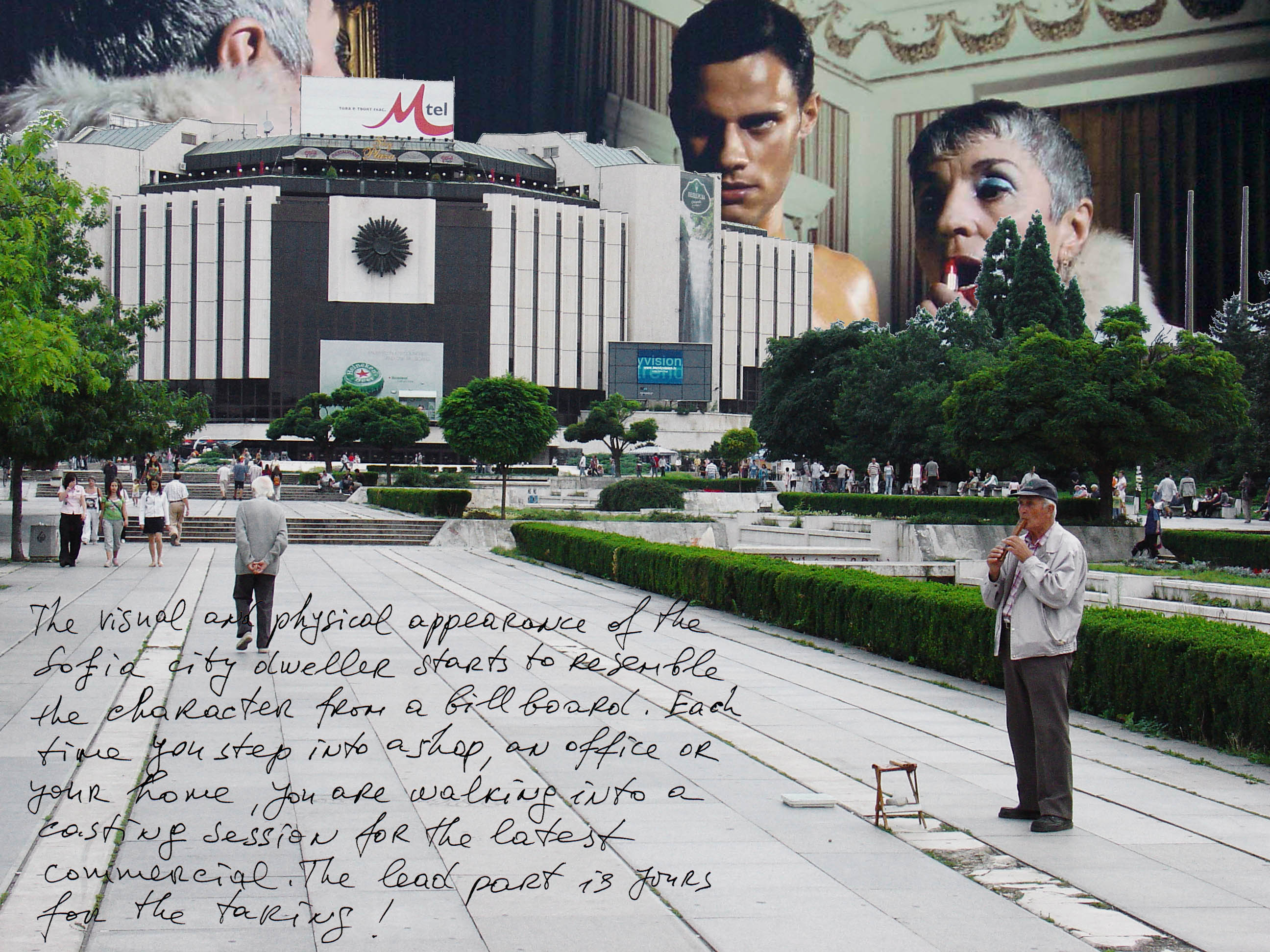 Billboard Heaven, 2005
Cycle of 19 digital prints on paper. Each one 60 x 80 cm. Sofia City Art Gallery Collection
Billboard Heaven, 2005
Cycle of 19 digital prints on paper. Each one 60 x 80 cm. Sofia City Art Gallery Collection
-
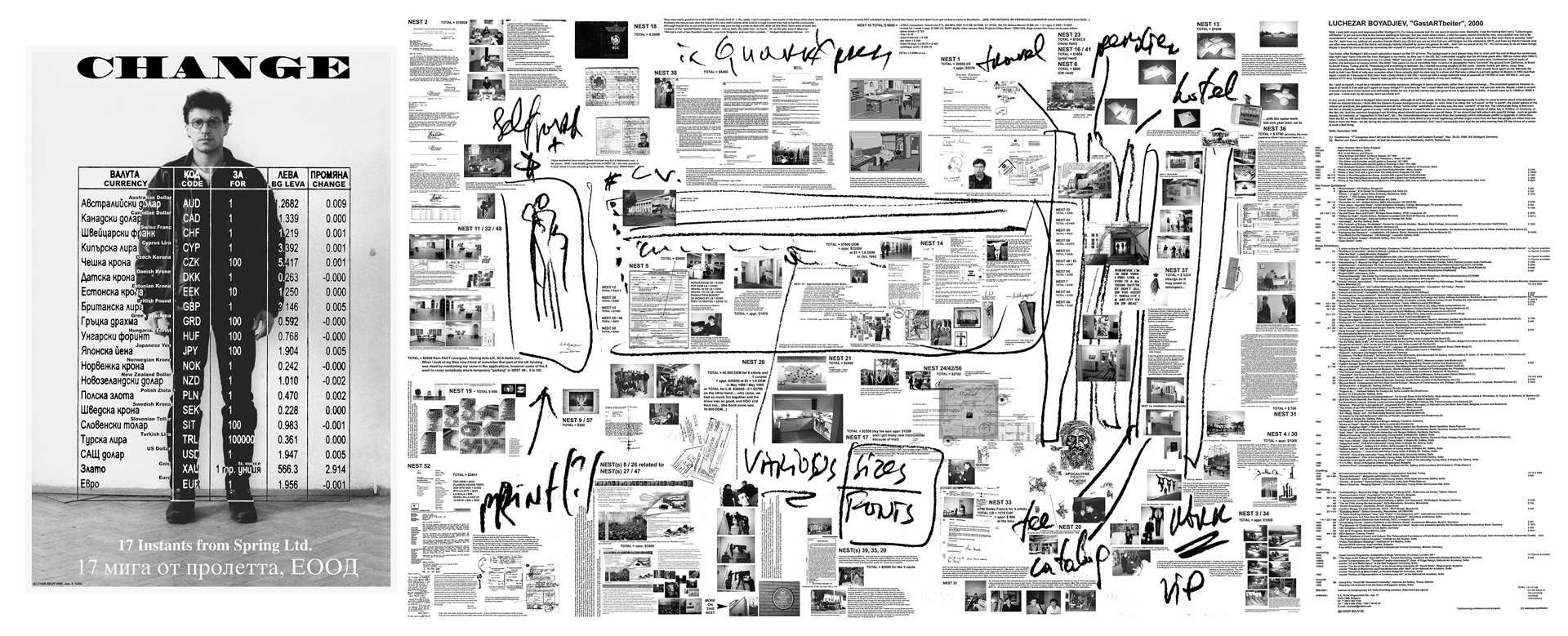 GastARTbeiter, 1998-2000
digital print on vinyl
GastARTbeiter, 1998-2000
digital print on vinyl
210 x 510 cm
edition 5+2AP At the end of the 1990s the artist noticed that his CV is growing fast while his income and ability to support his family was staying close to zero. Any earnings he was able to secure were from working outside of his home country. Any money he brought home from his working trips had to be exchanged immediately for the local currency. He wanted to know who is paying for his career, and later on – to meet them - the taxpayers-turned-visitors to the shows he was part of. He was aware that he is part of a kind of symbolic exchange and wanted to explore in more detail the situation. The work is a calculation of how much money was spent for the artist’s career between 1991 and early 2000, excluding sales of art works. The work consists of “data nests” where scanned documentation, receipts, photos from social occasions and installations are grouped together with textual explanation and notes concerning each show, conference or residency. The print is a kind of a mini-retrospective of the artist. -
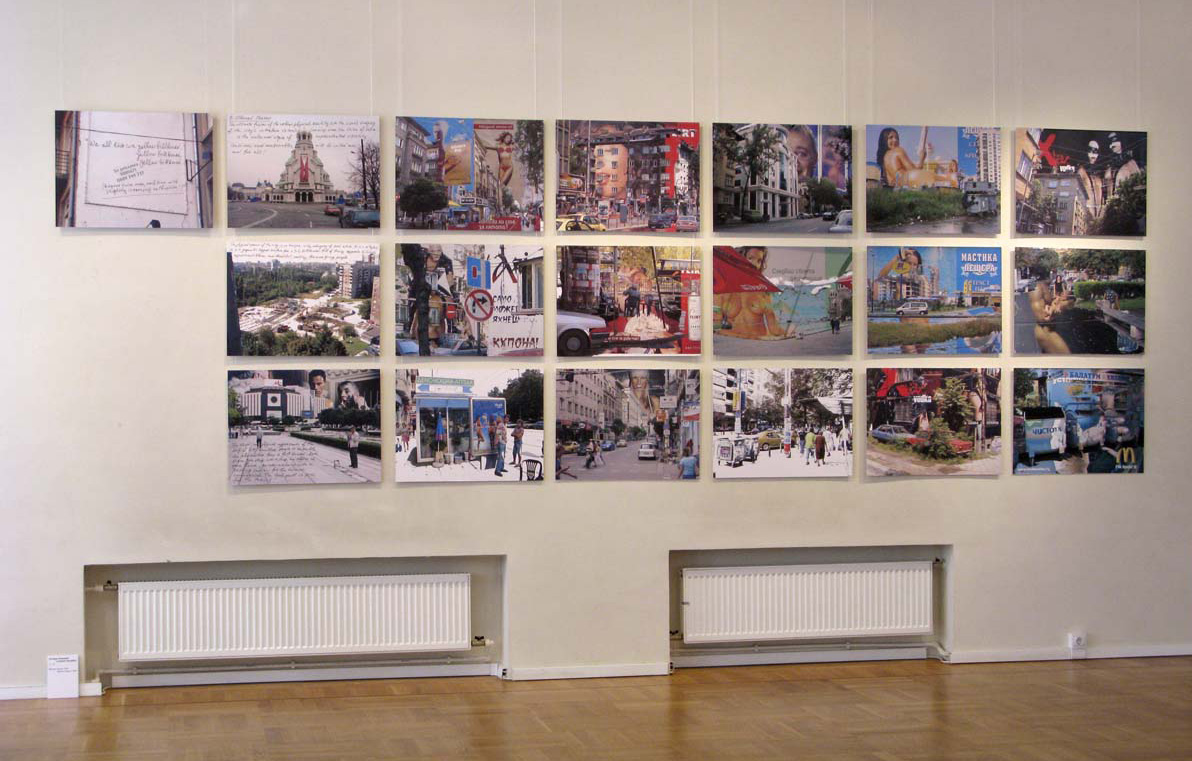 Billboard Heaven, 2005
cycle of 19 digital prints on paper
Billboard Heaven, 2005
cycle of 19 digital prints on paper
60 x 80 cm each
Sofia City Art Gallery Collection
edition 5+2AP Installation view: “From Ideology to Economy. Contemporary Bulgarian Art 20 years later”, State Central Museum of Contemporary History of Russia, Moscow, October-November 2009 (curators Iara Boubnova, Maria Vassileva) (C) Conceived and produced at the time of immensely aggressive invasion of vulgar advertisements in the city of Sofia, the work explores the visual interface of a neo-capitalist city in the process of change and massive investment. The visual surface of the prints proposes a vision for what might happen if the 2D space of the new billboards is merged together with the 3D space of the city. The horizon of such an urban interface cannot be anything else but a “billboard heaven”. View all prints here -
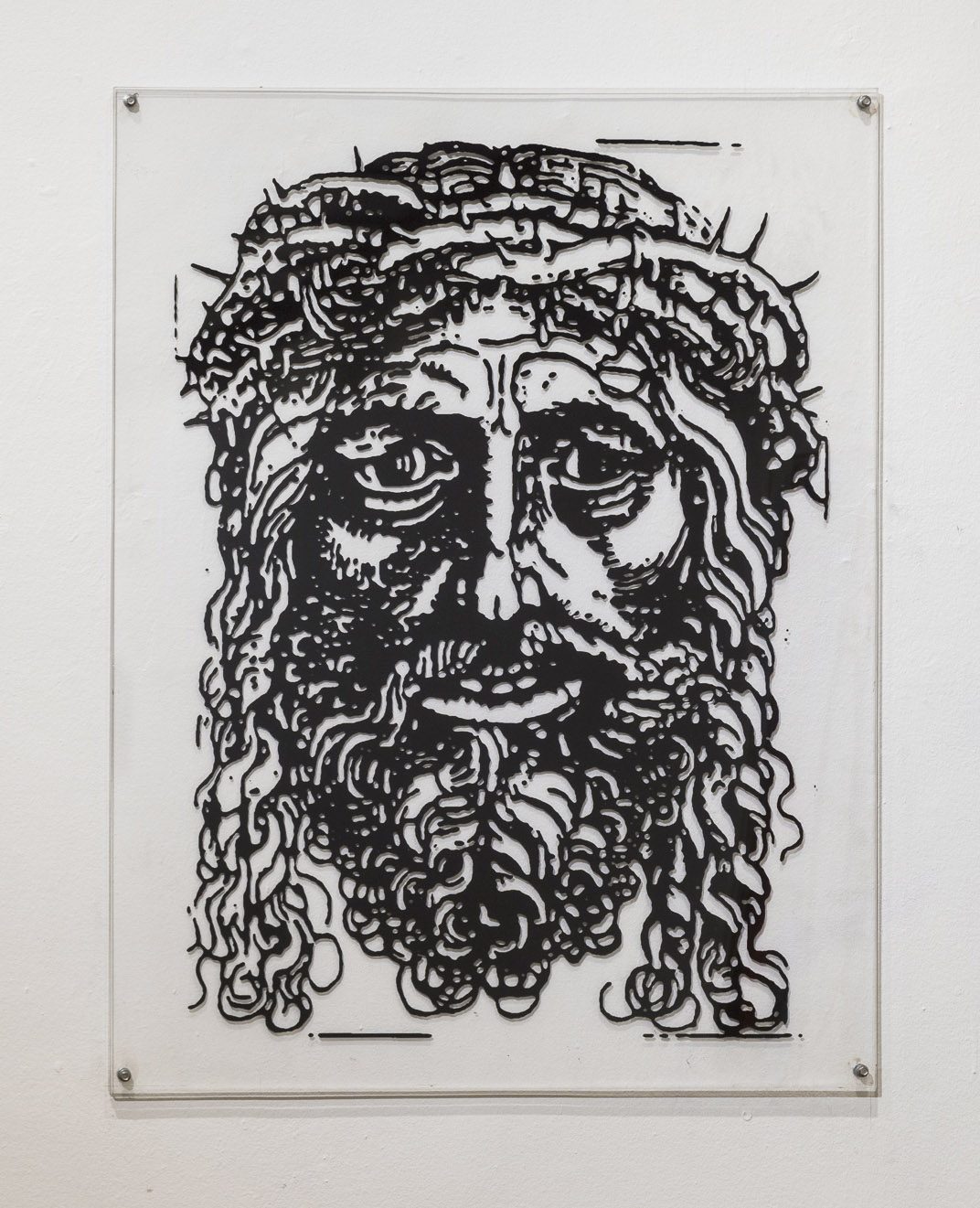 It’s all OK, 1997 (2018)
plexiglas, silkscreen
It’s all OK, 1997 (2018)
plexiglas, silkscreen
130 x 100 cm
edition 3+2AP Initially conceived as an image for the Christmas-time T-shirt offered to its patrons by the Fabric Workshop and Museum in Philadelphia (where the artist was on a residency at the time), this is an author’s re-purposing of the hand-made paper collage from 1997, which is based on a Durer print.
